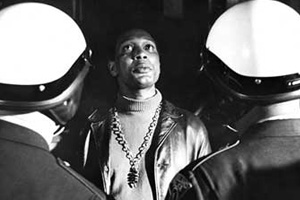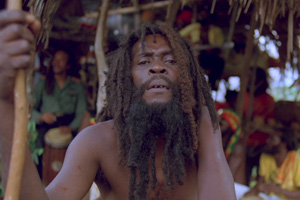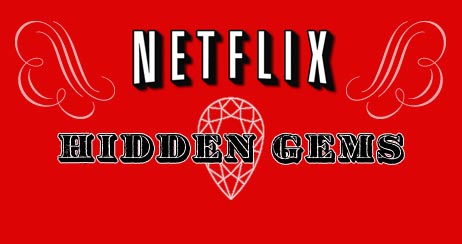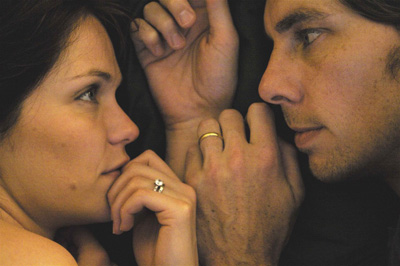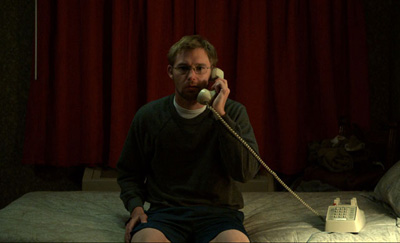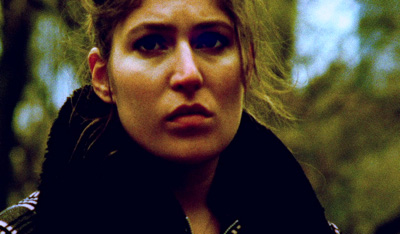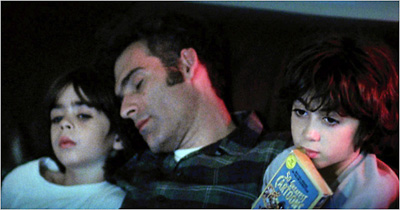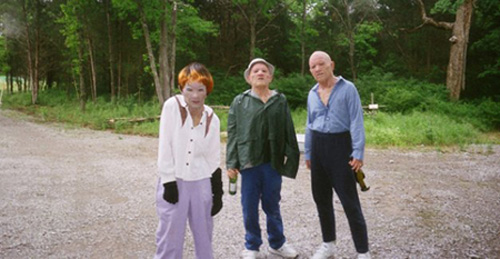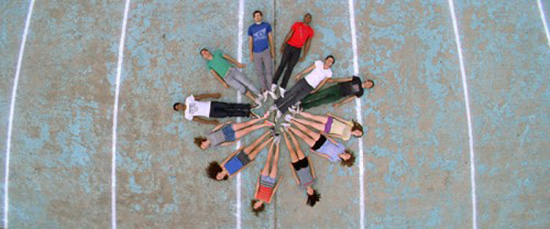
Dobra filmska stranica. Kakvi su, govori njihov izbor "najboljih filmova".
www.hammertonail.com/
THE 2012 HAMMER TO NAIL AWARDS
To clarify, here are our general voting parameters and rules for eligibility:
1) American narrative features produced for one million dollars or less.
2) The film had its first public release—theatrically, VOD, DVD—in said calendar year.
3) No HTN contributor is allowed to vote for a film in which they have a cast/crew credit (i.e., Mike S. Ryan was not allowed to vote for The Comedy, Alex Ross Perry did not vote for The Color Wheel or Green, Dustin Guy Defa did not vote for Bad Fever or Richard’s Wedding, Brandon Harris did not vote for Redlegs, Michael Tully did not vote for Codependent Lesbian Space Alien Seeks Same, etc.).
4) Each contributor ranks their films in order from 1 (highest) to 10 (lowest). The number 1 film receives 10 points; 2 receives 9 points; and on down the line. These results are then added up in order to calculate our winners.
[A gentle reminder: This type of thing is never, and will never be, a perfect science (for example, not everybody got to see every eligible film obviously). But we stand behind our commitment to distilling our year-end awards attention down to films that have been produced in this just-as-worthy-yet-so-often-unfairly-overlooked narrative budgetary realm.]
GOLDEN HAMMER
 In September of 2009, Matt Grady left his position as director of production at Plexifilm in order to launch his own label, Factory 25. His first release—Ronald Bronstein’s Frownland—was
a bold, emphatic mission statement. Since then, Grady has continued to
release work that meets his goal of keeping “physical media alive, while
exposing the indie world to under-the-radar films, music, and other
curiosities.”
In September of 2009, Matt Grady left his position as director of production at Plexifilm in order to launch his own label, Factory 25. His first release—Ronald Bronstein’s Frownland—was
a bold, emphatic mission statement. Since then, Grady has continued to
release work that meets his goal of keeping “physical media alive, while
exposing the indie world to under-the-radar films, music, and other
curiosities.”The past few years have seen Grady continue to release audacious films in great packages, works that defy easy categorization and electrify in their own special ways: Brock Enright: Good Times Will Never Be The Same, NY Export: Opus Jazz, The Oregonian, You Won’t Miss Me, Beetle Queen Conquers Tokyo, and Make-Out With Violence, just to name a few.
In 2012, however, Grady hit a new stride. Not only did he acquire more films than ever this year, but his hard work has led to distribution partnerships in which many of these titles have become accessible through VOD formats such as InDemand, iTunes, Amazon, Vudu, Sony Playstation, and X-box. A quick scan below reveals just how much we here at HTN appreciate his efforts (The Color Wheel, Bad Fever, Francine, Richard’s Wedding, Green… the hits don’t stop coming!). In our current distribution climate, in which several of the mini-major companies who once supported micro/low-budget American narrative cinema have turned their backs in favor of more easily marketable material, Grady has risen to the occasion in a major way.
A filmmaker friend of mine jokingly refers to Matt Grady as a “philanthropist,” for he certainly isn’t getting rich and famous by doing what he’s doing. Still, he appears to be pushing forward as strongly as ever in 2013, with an upcoming slate (we’ll let him make those announcements when he’s officially ready) that will make even more of 2012’s best previously undistributed work available. What better way to sum up Grady than by quoting the man himself: “Yeah, I’m really psyched about my 2013 line-up… I get to release my favorite films. How great is that?” Considering how great his taste is, that is seriously great news indeed. Congratulations to Matt Grady, the very worthy winner of our 2012 Golden Hammer award. (Michael Tully)

SILVER NAIL

Each year, we like to give our Silver Nail award to the individual who has displayed the best cinematic one-two punch, whether they be a writer, editor, director, cinematographer, or (insert other role here). This year, that award goes to writer/director Rick Alverson. As you’ll discover shortly, Alverson’s newest film, The Comedy, which premiered in the U.S. Dramatic Competition at the 2012 Sundance Film Festival, was much appreciated by us here at HTN (like, very much appreciated). Late in the year, Alverson’s previous feature, New Jerusalem, which world premiered at the 2011 International Film Festival Rotterdam, found a theatrical/VOD release thanks to our Golden Hammer winner Matt Grady/Factory 25 (there he goes again!). Though The Comedy and New Jerusalem share a similar filmmaking approach—treatments-as-opposed-to-fully-formed-scripts shot with superior technical craftsmanship and elemental control that breeds a striking blend of both intimacy and detachment, distance and immersion—they also couldn’t be more thematically different. New Jerusalem is a sincere exploration of one individual’s quest to find a tactile spiritual connection in a hazy world, while The Comedy is a scathing dissection of White Male Hipster Privilege run disturbingly amok. Proving that Alverson’s talents extend to the music video realm, there was also this small cherry on top of the sundae:
THE TOP 15 FILMS OF 2012
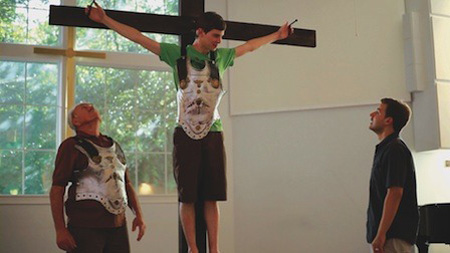 15. The Wise Kids (Stephen Cone, 18 points)
— Stephen Cone’s debut is a rare bird in American indie cinema: a
micro-budget feature without a trace of irony or cynicism. Centered
mostly around a group of evangelical teenagers at the end of their high
school days, The Wise Kids sparkles with the
hopes and fears of adolescence. There isn’t a false note in it. Cone
treats his characters with an honest, tender touch, never once judging
them for their beliefs. A film about acceptance, about doubt and
questioning as a part of the human experience. Everyone listen up and
take this lesson to heart: Love your characters, love your characters,
love your characters… (Zach Clark) ***WATCH IT: DVD
15. The Wise Kids (Stephen Cone, 18 points)
— Stephen Cone’s debut is a rare bird in American indie cinema: a
micro-budget feature without a trace of irony or cynicism. Centered
mostly around a group of evangelical teenagers at the end of their high
school days, The Wise Kids sparkles with the
hopes and fears of adolescence. There isn’t a false note in it. Cone
treats his characters with an honest, tender touch, never once judging
them for their beliefs. A film about acceptance, about doubt and
questioning as a part of the human experience. Everyone listen up and
take this lesson to heart: Love your characters, love your characters,
love your characters… (Zach Clark) ***WATCH IT: DVD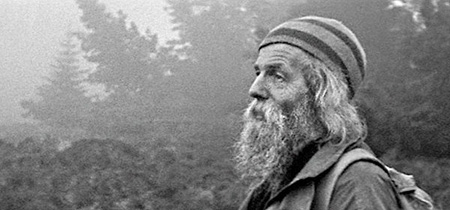 14. Two Years At Sea (UK, Ben Rivers, 87m, 7:30pm)
— Winner of a FIPRESCI prize at Venice, the first feature by renowned
short filmmaker/installation artist Ben Rivers is a staggering
accomplishment of low budget filmmaking. The placement in ‘Views from
the Avant Garde’ section in the New York Film Festival might scare
people away, daunted as they are by a 90-minute feature that features
only one human on screen and not one single line of spoken dialogue,
but the film is no less approachable than any late Tarkovsky or Albert
Serra. Shot in anamorphic on Rivers’ favorite soon-to-be-discontinued
black-and-white Kodak film stock and hand-developed in a ragtag manner
befitting the patchwork lifestyle of the subject, Two Years at Sea
showcases an impressive command of space, creating a wholly alien yet
familiar landscape out of a remote cabin and the area surrounding it,
where a solitary and robustly bearded man lives with his cats. Rivers
steps almost as far back as possible, allowing many takes to linger for
five, six minutes, even more, forcing the viewer to study the old man
as he confronts inhuman objects, such as his record player, a handmade
boat, or some unexplained apparatus that lifts his small trailer high
into the trees. Rivers’ use of the widescreen format to illustrate the
vastness of the forest and the miniscule presence of mankind within is
outstanding, making this unmissable as a theatrical experience. (Alex Ross Perry)
14. Two Years At Sea (UK, Ben Rivers, 87m, 7:30pm)
— Winner of a FIPRESCI prize at Venice, the first feature by renowned
short filmmaker/installation artist Ben Rivers is a staggering
accomplishment of low budget filmmaking. The placement in ‘Views from
the Avant Garde’ section in the New York Film Festival might scare
people away, daunted as they are by a 90-minute feature that features
only one human on screen and not one single line of spoken dialogue,
but the film is no less approachable than any late Tarkovsky or Albert
Serra. Shot in anamorphic on Rivers’ favorite soon-to-be-discontinued
black-and-white Kodak film stock and hand-developed in a ragtag manner
befitting the patchwork lifestyle of the subject, Two Years at Sea
showcases an impressive command of space, creating a wholly alien yet
familiar landscape out of a remote cabin and the area surrounding it,
where a solitary and robustly bearded man lives with his cats. Rivers
steps almost as far back as possible, allowing many takes to linger for
five, six minutes, even more, forcing the viewer to study the old man
as he confronts inhuman objects, such as his record player, a handmade
boat, or some unexplained apparatus that lifts his small trailer high
into the trees. Rivers’ use of the widescreen format to illustrate the
vastness of the forest and the miniscule presence of mankind within is
outstanding, making this unmissable as a theatrical experience. (Alex Ross Perry)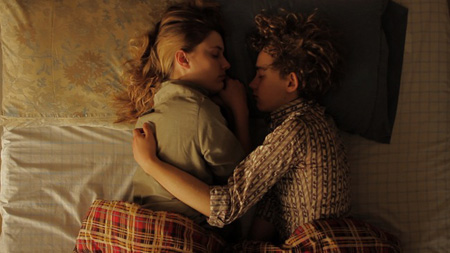 13. The Dish & The Spoon (Alison Bagnall, 20 points)
— Though Greta Gerwig and Ollie Alexander take turns stealing scenes,
the main credit for the success of this film goes to director Bagnall,
who honed her skills in Buffalo ’66 (which
she co-wrote) and which she has perfected here. She perches her
characters precariously at the top of a cliff and nudges them
slightly, letting their own inertia send them hurtling downward
towards a certain inevitability. It’s worth drawing another parallel
between these two films, as both feature improbable couplings of a man
and woman thrown together by virtue of their own bad decisions and
held together by some kind of Machiavellian fate. In this odd manner,
Bagnall compels us to root for Rose and Boy, despite knowing that, on
many levels, it’s foolish that they should even find themselves
together in the first place. (Vinay Singh) Read The Full HTN Review ***WATCH IT: DVD
13. The Dish & The Spoon (Alison Bagnall, 20 points)
— Though Greta Gerwig and Ollie Alexander take turns stealing scenes,
the main credit for the success of this film goes to director Bagnall,
who honed her skills in Buffalo ’66 (which
she co-wrote) and which she has perfected here. She perches her
characters precariously at the top of a cliff and nudges them
slightly, letting their own inertia send them hurtling downward
towards a certain inevitability. It’s worth drawing another parallel
between these two films, as both feature improbable couplings of a man
and woman thrown together by virtue of their own bad decisions and
held together by some kind of Machiavellian fate. In this odd manner,
Bagnall compels us to root for Rose and Boy, despite knowing that, on
many levels, it’s foolish that they should even find themselves
together in the first place. (Vinay Singh) Read The Full HTN Review ***WATCH IT: DVD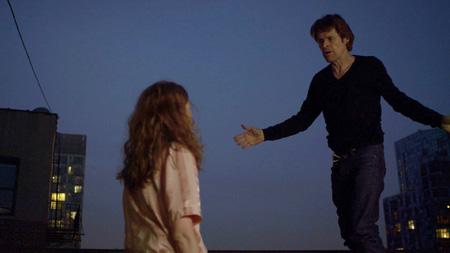 11. 4:44 Last Day On Earth (Abel Ferrara, 21 points/4 mentions)
— A number of recent films have collectively suggested that the more
global, or even cosmic, the crisis, the more intimate the response. This
was done most recently in Perfect Sense but also last summer’s Another Earth and, to a lesser extent, The Tree of Life, about which it might be more accurate to say that the cosmic is crafted from the intimate. (Melancholia breaks
from this trend somewhat, and its cold remove is part of what makes it
so disconcerting a film.) This art-house apocalypse continues in
Ferrara’s 4:44 Last Day on Earth, one of whose
touchstones is a close-up on two lovers’ bodies as they sleep
together: this, the longtime writer-director says repeatedly, is how we
console ourselves in times of crisis. And yet, as a viewing
experience, what comfort this lavishly titled, austerely shot film
brings is mostly cold. Its largely confined setting of a single New
York City apartment restricts our knowledge to that of the characters;
there’s no omniscience to be found from either within or without. (Michael Nordine) Read The Full HTN Review ***WATCH IT: DVD
11. 4:44 Last Day On Earth (Abel Ferrara, 21 points/4 mentions)
— A number of recent films have collectively suggested that the more
global, or even cosmic, the crisis, the more intimate the response. This
was done most recently in Perfect Sense but also last summer’s Another Earth and, to a lesser extent, The Tree of Life, about which it might be more accurate to say that the cosmic is crafted from the intimate. (Melancholia breaks
from this trend somewhat, and its cold remove is part of what makes it
so disconcerting a film.) This art-house apocalypse continues in
Ferrara’s 4:44 Last Day on Earth, one of whose
touchstones is a close-up on two lovers’ bodies as they sleep
together: this, the longtime writer-director says repeatedly, is how we
console ourselves in times of crisis. And yet, as a viewing
experience, what comfort this lavishly titled, austerely shot film
brings is mostly cold. Its largely confined setting of a single New
York City apartment restricts our knowledge to that of the characters;
there’s no omniscience to be found from either within or without. (Michael Nordine) Read The Full HTN Review ***WATCH IT: DVD 11. Natural Selection (Robbie Pickering, 21 points/3 mentions)
— This debut feature provides laugh-out-loud comedy coupled with deep,
detailed characters that are fresh and compelling. Pickering’s picture
of a woman’s journey to fulfill her dying husband’s last wish paints
universal strokes with heartwarming earnestness. Nun and preacher porn,
creepy gas station flashers, dirt bikes, and an impressively delicate
approach to female desire add up to a fun, yet profound, ride. (Alexandra Roxo) Read A Conversation With Robbie Pickering, Rachael Harris, and Matt O’Leary ***WATCH IT: DVD
11. Natural Selection (Robbie Pickering, 21 points/3 mentions)
— This debut feature provides laugh-out-loud comedy coupled with deep,
detailed characters that are fresh and compelling. Pickering’s picture
of a woman’s journey to fulfill her dying husband’s last wish paints
universal strokes with heartwarming earnestness. Nun and preacher porn,
creepy gas station flashers, dirt bikes, and an impressively delicate
approach to female desire add up to a fun, yet profound, ride. (Alexandra Roxo) Read A Conversation With Robbie Pickering, Rachael Harris, and Matt O’Leary ***WATCH IT: DVD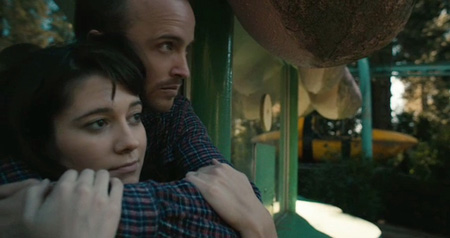 10. Smashed (James Ponsoldt, 23 points) — I was initially drawn to Smashed
by its cast. Mary Elizabeth Winstead, Nick Offerman, Megan Mullally,
Octavia Spencer, Aaron Paul: this is substantial talent with an
impressive range (though in truth I’d watch Aaron Paul read the phone
book). As Katie Hannah, an alcoholic trying to get sober, Winstead gives
the anchoring performance, but Ponsoldt’s film really is an ensemble
piece, deftly making the most of even the smaller characters and scenes.
There’s a giddy, anticipatory enjoyment in seeing top-tier television
actors take on film roles, a pleasure the director seems to share with
his audience. Working off the restrained, elegant screenplay by
Ponsoldt and Susan Burke, the cast said they felt little need to
improvise. I attribute this to Ponsoldt’s balanced direction, and his
almost musical instincts for the tonal shifts of a scene. Addiction is
inherently dramatic, and stories centered on it can easily devolve into
miserablism or hot mess histrionics. Smashed
pulls back from that drama in favor of a milder, much more realistic
tone. It’s also very funny without being Apatow-ish. This shines
through in Winstead’s immersive performance as Katie, a young woman
stumbling, painfully, toward responsibility. It’s her honesty that wins
our sympathies, and distinguishes Smashed from more conventional stories of addiction. (Susanna Locascio) Read The Full HTN Review ***WATCH IT: Still in Theaters, DVD
10. Smashed (James Ponsoldt, 23 points) — I was initially drawn to Smashed
by its cast. Mary Elizabeth Winstead, Nick Offerman, Megan Mullally,
Octavia Spencer, Aaron Paul: this is substantial talent with an
impressive range (though in truth I’d watch Aaron Paul read the phone
book). As Katie Hannah, an alcoholic trying to get sober, Winstead gives
the anchoring performance, but Ponsoldt’s film really is an ensemble
piece, deftly making the most of even the smaller characters and scenes.
There’s a giddy, anticipatory enjoyment in seeing top-tier television
actors take on film roles, a pleasure the director seems to share with
his audience. Working off the restrained, elegant screenplay by
Ponsoldt and Susan Burke, the cast said they felt little need to
improvise. I attribute this to Ponsoldt’s balanced direction, and his
almost musical instincts for the tonal shifts of a scene. Addiction is
inherently dramatic, and stories centered on it can easily devolve into
miserablism or hot mess histrionics. Smashed
pulls back from that drama in favor of a milder, much more realistic
tone. It’s also very funny without being Apatow-ish. This shines
through in Winstead’s immersive performance as Katie, a young woman
stumbling, painfully, toward responsibility. It’s her honesty that wins
our sympathies, and distinguishes Smashed from more conventional stories of addiction. (Susanna Locascio) Read The Full HTN Review ***WATCH IT: Still in Theaters, DVD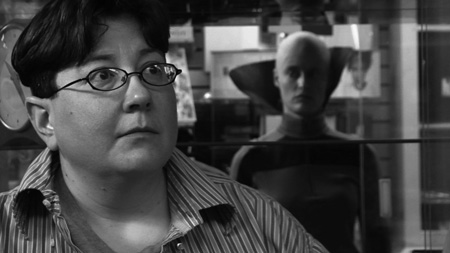 9. Codependent Lesbian Space Alien Seeks Same (Madeleine Olnek, 25 points)
— While Madeleine Olnek can brilliantly maneuver a script that both
slices and entertains in a satirical breath, there are moments of pure,
unfettered comedy in her first feature, from the absurd to the
slapstick, that feel classic and even quotable. Like most movie aliens,
Olnek’s have a childlike fascination with Earth’s most pedestrian
innovations: a revolving dessert case is true love incarnate, a
commercial clothes dryer better than psychedelics. As the aliens move
with great difficulty through their new lives in New York City, their
wit is so sharp that the original concepts and jokes become even
funnier as the movie progresses. Olnek’s grasp of her comedic arc is
enviable. She sustains, and even pushes the laughs further, with each
successive one-liner. (Holly Herrick) Read The Full HTN Review and A Conversation With Madeleine Olnek ***WATCH IT: DVD
9. Codependent Lesbian Space Alien Seeks Same (Madeleine Olnek, 25 points)
— While Madeleine Olnek can brilliantly maneuver a script that both
slices and entertains in a satirical breath, there are moments of pure,
unfettered comedy in her first feature, from the absurd to the
slapstick, that feel classic and even quotable. Like most movie aliens,
Olnek’s have a childlike fascination with Earth’s most pedestrian
innovations: a revolving dessert case is true love incarnate, a
commercial clothes dryer better than psychedelics. As the aliens move
with great difficulty through their new lives in New York City, their
wit is so sharp that the original concepts and jokes become even
funnier as the movie progresses. Olnek’s grasp of her comedic arc is
enviable. She sustains, and even pushes the laughs further, with each
successive one-liner. (Holly Herrick) Read The Full HTN Review and A Conversation With Madeleine Olnek ***WATCH IT: DVD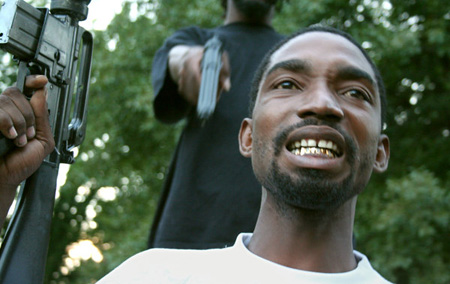 8.Snow On Tha Bluff (Damon Russell, 33 points)
— The premise is simple, and inspired. Curtis Snow, a drug dealer in
Atlanta’s The Bluff neighborhood, steals a video camera from some
college kids, and records his daily life and that of his crew. Snow on tha Bluff
is the movie that results. Seemingly random incidents (crack sales,
shootouts with rivals, family drama, a spell in prison) gradually cohere
into a story arc—but how much of what we see is real? According to
Snow and director Russell, some scenes are pure documentary, others
are staged re-enactments or inventions; most of the time, viewers will
be hard pressed to tell the difference. Snow
succeeds as shocking, sad, scary-funny entertainment and a deadly
serious piece of reportage on the human cost of American urban blight;
it’s also one of the strongest contributions yet to the growing
sub-genre of fact-fiction hybrids that question conventional notions of
narrative form, performance, and truth-in-cinema. (Nelson Kim) ***WATCH IT: DVD
8.Snow On Tha Bluff (Damon Russell, 33 points)
— The premise is simple, and inspired. Curtis Snow, a drug dealer in
Atlanta’s The Bluff neighborhood, steals a video camera from some
college kids, and records his daily life and that of his crew. Snow on tha Bluff
is the movie that results. Seemingly random incidents (crack sales,
shootouts with rivals, family drama, a spell in prison) gradually cohere
into a story arc—but how much of what we see is real? According to
Snow and director Russell, some scenes are pure documentary, others
are staged re-enactments or inventions; most of the time, viewers will
be hard pressed to tell the difference. Snow
succeeds as shocking, sad, scary-funny entertainment and a deadly
serious piece of reportage on the human cost of American urban blight;
it’s also one of the strongest contributions yet to the growing
sub-genre of fact-fiction hybrids that question conventional notions of
narrative form, performance, and truth-in-cinema. (Nelson Kim) ***WATCH IT: DVD 7. Green (Sophia Takal, 34 points)
— The most well-known female directors are those who express themselves
through the plot/dialogue driven TV/radio format (ala Nora Ephron,
Nancy Meyers, Lynn Shelton, etc). Green is
unique in that its female perspective emerges visually by allowing
desire’s anxiety, danger and mystery to emerge naturally from the
setting, acting, framing and editing. The themes this film explores are
in many ways beyond verbal and it takes us into that strange
unbalanced world through Takal’s control over the plastics of the medium
in combination with a stunning Kate Lyn Shiel perfomance in the lead
role. (Mike S. Ryan) Read A Conversation With Sophia Takal, Lawrence Levine, and Kate Lyn Shiel ***WATCH IT: Amazon Instant
7. Green (Sophia Takal, 34 points)
— The most well-known female directors are those who express themselves
through the plot/dialogue driven TV/radio format (ala Nora Ephron,
Nancy Meyers, Lynn Shelton, etc). Green is
unique in that its female perspective emerges visually by allowing
desire’s anxiety, danger and mystery to emerge naturally from the
setting, acting, framing and editing. The themes this film explores are
in many ways beyond verbal and it takes us into that strange
unbalanced world through Takal’s control over the plastics of the medium
in combination with a stunning Kate Lyn Shiel perfomance in the lead
role. (Mike S. Ryan) Read A Conversation With Sophia Takal, Lawrence Levine, and Kate Lyn Shiel ***WATCH IT: Amazon Instant************************************************************************************************************************************************************************
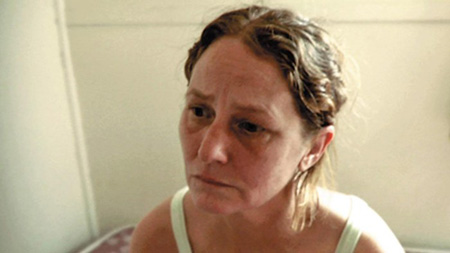 6. Francine (Brian M. Cassidy and Melanie Shatzky, 37 points) — In an intense yet nuanced performance, Academy Award winner, Purchase graduate, and Homocide: Life on the Street
alum Melissa Leo is the title character, an ex-con desperate to reclaim
life from the grim realities of the seen-better-days upstate New York
lake town she surfaces in after getting out of the big bird cage. Unable
to maintain a job or build significant human relationships, Francine
does little talking; almost everything you need to know about what this
woman is going through registers in the film’s searing close-ups on
Leo’s face. What close-ups they are! A scene where she takes in an
impromptu, outdoors thrash metal show in a parking lot is like something
out of Vivre Sa Vie. Directors Shatzky and
Cassidy keep the camera at eye level and provide no exposition. Pretty
solid strategy when you have someone like Ms. Leo in your corner. (Brandon Harris) Read A Conversation With Brian M. Cassidy and Melanie Shatzky and 12 Quick ?s ***WATCH IT: Still in Theaters, Amazon Instant
6. Francine (Brian M. Cassidy and Melanie Shatzky, 37 points) — In an intense yet nuanced performance, Academy Award winner, Purchase graduate, and Homocide: Life on the Street
alum Melissa Leo is the title character, an ex-con desperate to reclaim
life from the grim realities of the seen-better-days upstate New York
lake town she surfaces in after getting out of the big bird cage. Unable
to maintain a job or build significant human relationships, Francine
does little talking; almost everything you need to know about what this
woman is going through registers in the film’s searing close-ups on
Leo’s face. What close-ups they are! A scene where she takes in an
impromptu, outdoors thrash metal show in a parking lot is like something
out of Vivre Sa Vie. Directors Shatzky and
Cassidy keep the camera at eye level and provide no exposition. Pretty
solid strategy when you have someone like Ms. Leo in your corner. (Brandon Harris) Read A Conversation With Brian M. Cassidy and Melanie Shatzky and 12 Quick ?s ***WATCH IT: Still in Theaters, Amazon Instant 5. Starlet (Sean Baker, 41 points) — Sean Baker is no stranger to intimate studies of characters on the margins of society; his films Take Out and Prince of Broadway examined the lives of men toiling in the shadow of the American dream. With Starlet,
Baker shifts to the blazing sunlight of California, but his concerns
remain as vital as ever; his tale of the unlikely friendship between a
curmudgeonly widow (Besedka Johnson) and an up-and-coming adult film
star (Dree Hemingway) provided not only two of the year’s best
performances, but a continuation of Baker’s exploration of how the
hustle for money corrupts and transforms our social bonds. (Tom Hall) Read A Conversation With Sean Baker and Dree Hemingway ***Still In Theaters***
5. Starlet (Sean Baker, 41 points) — Sean Baker is no stranger to intimate studies of characters on the margins of society; his films Take Out and Prince of Broadway examined the lives of men toiling in the shadow of the American dream. With Starlet,
Baker shifts to the blazing sunlight of California, but his concerns
remain as vital as ever; his tale of the unlikely friendship between a
curmudgeonly widow (Besedka Johnson) and an up-and-coming adult film
star (Dree Hemingway) provided not only two of the year’s best
performances, but a continuation of Baker’s exploration of how the
hustle for money corrupts and transforms our social bonds. (Tom Hall) Read A Conversation With Sean Baker and Dree Hemingway ***Still In Theaters***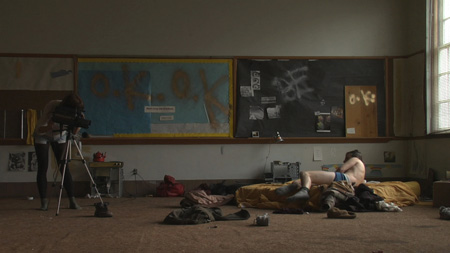 3. Bad Fever (Dustin Guy Defa, 55 points/9 mentions)
— For those viewers with a deep-seated fondness for the character-based
New Hollywood dramas that were churned out in the 1970s, Bad Fever
will feel like a welcome return to that glorious past (I should know,
as I am guilty of said deep-seated fondness). From the spare opening
title card—complete with a copyright tag at the bottom!—to its placing
of atmosphere and character firmly in the foreground, Bad Fever
recalls films from the past more than it does those it brushed up
alongside in film festival programs over the course of the past year.
Yet, to be clear, Bad Fever isn’t some hip
exercise in retro coolness. Defa’s film is a darkly funny, ultimately
crushing portrait of a lost soul who is unable to forge the type of
connection he so desperately wants. (MT) Read The Full HTN Review and A Conversation With Dustin Guy Defa ***WATCH IT: Amazon Instant
3. Bad Fever (Dustin Guy Defa, 55 points/9 mentions)
— For those viewers with a deep-seated fondness for the character-based
New Hollywood dramas that were churned out in the 1970s, Bad Fever
will feel like a welcome return to that glorious past (I should know,
as I am guilty of said deep-seated fondness). From the spare opening
title card—complete with a copyright tag at the bottom!—to its placing
of atmosphere and character firmly in the foreground, Bad Fever
recalls films from the past more than it does those it brushed up
alongside in film festival programs over the course of the past year.
Yet, to be clear, Bad Fever isn’t some hip
exercise in retro coolness. Defa’s film is a darkly funny, ultimately
crushing portrait of a lost soul who is unable to forge the type of
connection he so desperately wants. (MT) Read The Full HTN Review and A Conversation With Dustin Guy Defa ***WATCH IT: Amazon Instant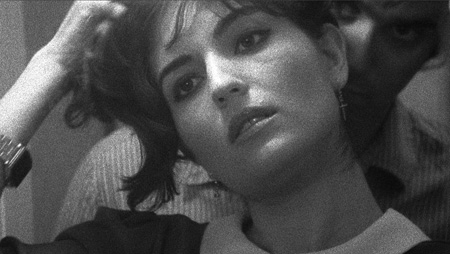 3. The Color Wheel (Alex Ross Perry, 55 points, 9 mentions) — What sets The Color Wheel
apart from its contemporaries in American independent cinema is its
multifaceted examination of the conflict between the democratic ideal of
self-invention and vacuous scaffolding of the society that surrounds
it. Family, career, social class, even the parameters of personal
imagination: Perry sets the desperate need for connection squarely
against the deep limitations of choice and freedom. In The Color Wheel,
the dawning disappointments of adulthood can be squarely pinned to the
moment when we recognize our own acquiescence to role-playing, to the
expectation of others that we inhibit our true selves, our dream
selves, in favor of something far less than we had hoped we might be. (TH) Read The Full HTN Review and A Conversation With Alex Ross Perry ***WATCH IT: Amazon Instant
3. The Color Wheel (Alex Ross Perry, 55 points, 9 mentions) — What sets The Color Wheel
apart from its contemporaries in American independent cinema is its
multifaceted examination of the conflict between the democratic ideal of
self-invention and vacuous scaffolding of the society that surrounds
it. Family, career, social class, even the parameters of personal
imagination: Perry sets the desperate need for connection squarely
against the deep limitations of choice and freedom. In The Color Wheel,
the dawning disappointments of adulthood can be squarely pinned to the
moment when we recognize our own acquiescence to role-playing, to the
expectation of others that we inhibit our true selves, our dream
selves, in favor of something far less than we had hoped we might be. (TH) Read The Full HTN Review and A Conversation With Alex Ross Perry ***WATCH IT: Amazon Instant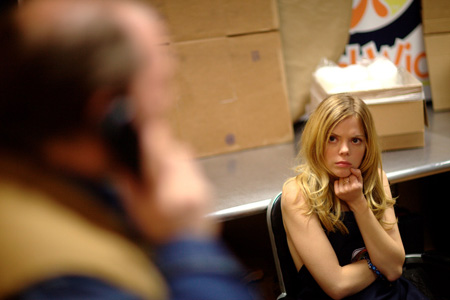 2. Compliance (Craig Zobel, 72 points) — Compliance
is essentially a docudrama, but it moves with such analytical drive
that it more closely resembles a police procedural. In this case,
however, rather than watching how a crime is solved, we are watching a
crime being committed as well as, through Zobel’s crafty writing and
direction, an analysis of how that crime came to be and why it was
committed. It’s a deceptively simple film, and both the lazy and the
prickly, easily offended viewer will seek ways to escape the
experience, either through accusations of misogyny or simply through
the false interpretation that it has no other objective except to
titillate and exploit. But the fact remains: this film should be
required viewing. (MSR) Read The Full HTN Review ***WATCH IT: DVD
2. Compliance (Craig Zobel, 72 points) — Compliance
is essentially a docudrama, but it moves with such analytical drive
that it more closely resembles a police procedural. In this case,
however, rather than watching how a crime is solved, we are watching a
crime being committed as well as, through Zobel’s crafty writing and
direction, an analysis of how that crime came to be and why it was
committed. It’s a deceptively simple film, and both the lazy and the
prickly, easily offended viewer will seek ways to escape the
experience, either through accusations of misogyny or simply through
the false interpretation that it has no other objective except to
titillate and exploit. But the fact remains: this film should be
required viewing. (MSR) Read The Full HTN Review ***WATCH IT: DVD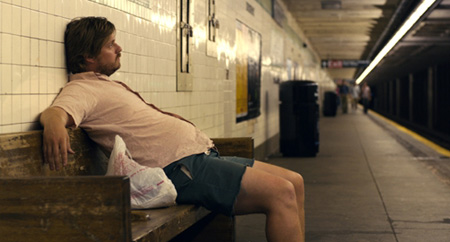 1. The Comedy (Rick Alverson, 77 points)
— The issue of the quarter-life crisis creeping ever closer to middle
age is one largely associated with men, and yet despite the fact that The Comedy’s
face needed to be Male, needed to be White, it speaks to a feeling
that may not be an epidemic, though it certainly is a virus, which is
applicable to many different people in different circumstances. Tim
Heidecker brings wit, consideration and pathos to Swanson, displaying an
arc—though slight—of a person searching for his own self-ness, for a
self that goes beyond itself, for his own ability to be human. The
bullying, the tirades, the endless jokes, the apathy, it’s Swanson’s
process to redeem himself as a hopeful, giving adult, in a cynical,
taking world. He needs to tear it all down before he can start building
it back up. Alverson’s film isn’t easy viewing. It’s a give and take.
But if you are looking for challenging cinema that speaks uncomfortable
truths, look no further than right here. (Jesse Klein) Read The HTN Review and A Conversation With Rick Alverson ***WATCH IT: Amazon Instant
1. The Comedy (Rick Alverson, 77 points)
— The issue of the quarter-life crisis creeping ever closer to middle
age is one largely associated with men, and yet despite the fact that The Comedy’s
face needed to be Male, needed to be White, it speaks to a feeling
that may not be an epidemic, though it certainly is a virus, which is
applicable to many different people in different circumstances. Tim
Heidecker brings wit, consideration and pathos to Swanson, displaying an
arc—though slight—of a person searching for his own self-ness, for a
self that goes beyond itself, for his own ability to be human. The
bullying, the tirades, the endless jokes, the apathy, it’s Swanson’s
process to redeem himself as a hopeful, giving adult, in a cynical,
taking world. He needs to tear it all down before he can start building
it back up. Alverson’s film isn’t easy viewing. It’s a give and take.
But if you are looking for challenging cinema that speaks uncomfortable
truths, look no further than right here. (Jesse Klein) Read The HTN Review and A Conversation With Rick Alverson ***WATCH IT: Amazon InstantOther Films Receiving Votes (In Alphabetical Order):
The Do-Deca Pentathlon (Jay and Mark Duplass)
First Winter (Benjamin Dickinson) [HTN Review]
For Ellen (So Yong Kim)
Gayby (Jonathan Lisecki) [A Conversation With Jonathan Lisecki]
Hello I Must Be Going (Todd Louiso)
Jack and Diane (Bradley Rust Gray)
Jess + Moss (Clay Jeter) [HTN review]
The Loneliest Planet (Julia Loktev) [HTN review and A Conversation With Julia Loktev]
Middle of Nowhere (Ava DuVernay)
New Jerusalem (Rick Alverson) [HTN review]
Nobody Walks (Ry Russo-Young)
Now, Forager (Jason Cortlund and Julia Halperin)
Redlegs (Brandon Harris)
Return (Liza Johnson) [A Conversation With Liza Johnson]
Richard’s Wedding (Onur Tukel) [HTN review]
Scalene (Zack Parker) [HTN review]
V/H/S (Adam Wingard, David Bruckner, Ti West, Glenn McQuaid, Joe Swanberg, Radio Silence)
You Hurt My Feelings (Steve Collins)
Your Sister’s Sister (Lynn Shelton) [HTN review]
An Imperfect List of Films That Premiered in 2012 But Have Yet To Receive Some Form Of Release (If We Have Missed Anything Please Let Us Know In The Comments Section—We Aren’t Perfect!):
Bindlestiffs (Andrew Edison) [HTN review]
Black Rock (Katie Aselton)
Crazy and Thief (Cory McAbee)
Dead Man’s Burden (Jared Moshe)
The End of Love (Mark Webber)
Exit Elena (Nathan Silver) [HTN review]
Fourplay (Kyle Henry) [HTN reviews of Fourplay: Tampa and Fourplay: San Francisco and A Conversation With Kyle Henry and Paul Soileau]
Gimme The Loot (Adam Leon)
I Am Not A Hipster (Destin Daniel Cretton)
KID-THING (David Zellner) [HTN review and 12 Quick ?s]
Nancy, Please (Andrew Semans)
OK, Good (Daniel Martinico) [HTN review]
An Oversimplification Of Her Beauty (Terence Nance) [HTN review and A Conversation With Terence Nance]
Pavilion (Tim Sutton) [HTN review]
The Perception Of Moving Targets (Weston Currie)
Pilgrim Song (Martha Stephens)
Red Flag (Alex Karpovsky)
Rubberneck (Alex Karpovsky)
Simon Killer (Antonio Campos)
Somebody Up There Likes Me (Bob Byington)
Sparrows Dance (Noah Buschel)
Sun Don’t Shine (Amy Seimetz) [HTN review]
Tiger Tail in Blue (Frank V. Ross)
Una Noche (Lucy Mulloy) [HTN review]
The Unspeakable Act (Dan Sallitt)
(Contributors: Zach Clark, Dustin Guy Defa, Tom Hall, Brandon Harris, Holly Herrick, Nelson Kim, Jesse Klein, Susanna Locascio, Michael Nordine, Alex Ross Perry, Alexandra Roxo, Mike S. Ryan, Michael Tully)
CINEMATIC NONFICTION 2012
Ten years into this renaissance in documentary culture that began, arguably (in America), with the release and success of Spellbound in 2002 and continued through such milestones as the birth of boundary-pushing film festivals such as True/False and CPH:DOX, as well as the founding in 2008 of the first documentary-only awards ceremony, Cinema Eye Honors,
nonfiction cinema is at a crossroads. Two worlds have emerged: on one
side we have an explosion of films, filmmakers and micro-movements that
are pushing nonfiction cinematic form, creating immersive, expressive,
genre-bending films that bristle with ideas and energy. On the other
side, we have a film critic culture, well-versed in fictional narrative
art cinema, completely missing the boat.
I like to situate my own films as a part of this renaissance, so I’m obviously not an impartial voice when discussing what I see as a critical failing. But how else do you explain The New York Times’ Manohla Dargis, a gifted and beloved movie critic, writing the following sentences in her review of one of the year’s best films, Only The Young?
Later, in her year-end review, Dargis cited with due excitement the “aesthetic expansiveness of American movies” then went on to mention such formally uninventive films as Brooklyn Castle and Ai Wei Wei: Never Sorry as her favorite documentaries of the year. And of course Dargis—a critic I genuinely respect, mind you—is not the only one. It’s not hard to be disappointed by most film critics if you’re a fan of groundbreaking nonfiction.
What are they missing? Well, almost no one is talking seriously about the collapsing walls between fiction, nonfiction and art cinema. Nonfiction cinema would best be described as a way of seeing and less a rigid and prescriptive “genre.” The most interesting documentaries push narrative bounds, re-shoot situations (as opposed to the somewhat tired practice of reenactment), play with the idea of performance, etc. They break the rules. Most interesting fiction, to me, is rooted in the observational camera, staging the action with the soul of cinema verité. How do so-called fiction and nonfiction films speak to each other? How do the stories being told or the situations being captured change according to approach? No one is asking these questions.
Meanwhile, there is a clear bias against discussing documentaries as movies first. If a film like the great Ballroom Dancer was fiction, critics would be fawning over its canny mix of melodrama and restraint. If the characters in Only The Young weren’t real people, no one would be asking them to discuss politics.
So I’ve decided to take a shot myself and offer a sort of corrective.
In that spirit, here is my list of some of the best rule-breaking, genre-busting or otherwise important/brilliant/moving nonfiction of the year. You’ll notice I don’t particularly worry about release dates or a film’s eligibility and my definition of “nonfiction” would certainly be called “expansive.”
We need a revolution in documentary criticism. I am a filmmaker, not a critic. But let’s try to light a fire anyway.
 25. Traveling Light (Gina Telaroli)
— A playful, experimental film journey on a train, loose and evocative,
structurally open and in love with, well, light. You are taken in by
the actively in-the-moment documentary camera before the beautiful
hipsters start showing up. Then Telaroli’s film becomes something like a
mystery without a plot or maybe a moving performance without drama.
Either way, as a piece of nonfiction, it is a work of lovely
impressionism.
25. Traveling Light (Gina Telaroli)
— A playful, experimental film journey on a train, loose and evocative,
structurally open and in love with, well, light. You are taken in by
the actively in-the-moment documentary camera before the beautiful
hipsters start showing up. Then Telaroli’s film becomes something like a
mystery without a plot or maybe a moving performance without drama.
Either way, as a piece of nonfiction, it is a work of lovely
impressionism.
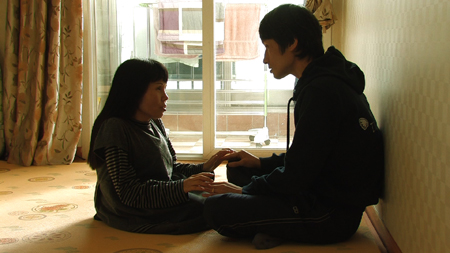 24. Planet of Snail (Yi Seung-jun)
— So it turns out that watching a gangly, blind-deaf poet and his tiny,
sweet, supportive wife make their way through the world in their
necessarily particular way can pretty much confirm the existence of love
in the universe.
24. Planet of Snail (Yi Seung-jun)
— So it turns out that watching a gangly, blind-deaf poet and his tiny,
sweet, supportive wife make their way through the world in their
necessarily particular way can pretty much confirm the existence of love
in the universe.
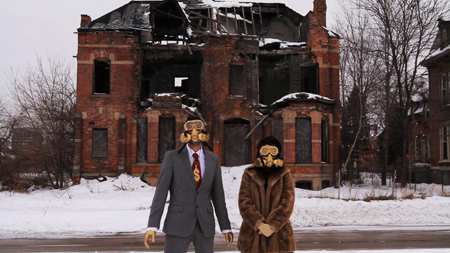 23. Detropia (Rachel Grady and Heidi Ewing)
— Although I wouldn’t have minded someone with the Ross Brothers’
aesthetic delivering this much-needed symphony of that great, embattled
American symbol of decline called Detroit, Ewing and Grady are quite
capable themselves. Detropia does everything
“right” and while sometimes it may feel a little too tried-and-true, the
film remains full of distinctive cinematic flourishes that elevate the
slightly predictable material. Meanwhile, the love of the place that the
filmmakers clearly feel comes through vividly in every frame. Viva the
Motor City!
23. Detropia (Rachel Grady and Heidi Ewing)
— Although I wouldn’t have minded someone with the Ross Brothers’
aesthetic delivering this much-needed symphony of that great, embattled
American symbol of decline called Detroit, Ewing and Grady are quite
capable themselves. Detropia does everything
“right” and while sometimes it may feel a little too tried-and-true, the
film remains full of distinctive cinematic flourishes that elevate the
slightly predictable material. Meanwhile, the love of the place that the
filmmakers clearly feel comes through vividly in every frame. Viva the
Motor City!
 22. The Queen of Versailles (Lauren Greenfield)
— When one of the film’s stars, David Siegel (the billionaire owner of
Westgate Resorts), filed a lawsuit against director Lauren Greenfield,
his lawyer claimed that “The Queen of Versailles
is a fraud – more fictional than real… a staged theatrical production,
albeit using nonprofessionals in the starring roles (as themselves).”
Well if that doesn’t make you want to see it, how about this: you know
how you watch a reality TV show and it’s kind of good but you really
wish the hilarious, crazy, oh-my-god stuff you’re seeing could be in a
real movie, handled by a real filmmaker? Well that’s The Queen of Versailles.
22. The Queen of Versailles (Lauren Greenfield)
— When one of the film’s stars, David Siegel (the billionaire owner of
Westgate Resorts), filed a lawsuit against director Lauren Greenfield,
his lawyer claimed that “The Queen of Versailles
is a fraud – more fictional than real… a staged theatrical production,
albeit using nonprofessionals in the starring roles (as themselves).”
Well if that doesn’t make you want to see it, how about this: you know
how you watch a reality TV show and it’s kind of good but you really
wish the hilarious, crazy, oh-my-god stuff you’re seeing could be in a
real movie, handled by a real filmmaker? Well that’s The Queen of Versailles.
 21. Abendland (Nikolaus Geyrhalter) — Set at night and relying on Austrian formalist Geyrhalter’s signature structuralist style, Abendland
is full of potent observations about the secret lives of Europeans.
These kinds of rigorously composed, image-first films can sometimes feel
a bit one-note, but Abendland succeeds by finding moments in spaces that communicate clearly the way people really live.
21. Abendland (Nikolaus Geyrhalter) — Set at night and relying on Austrian formalist Geyrhalter’s signature structuralist style, Abendland
is full of potent observations about the secret lives of Europeans.
These kinds of rigorously composed, image-first films can sometimes feel
a bit one-note, but Abendland succeeds by finding moments in spaces that communicate clearly the way people really live.
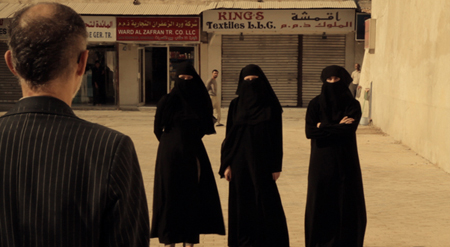 20. The Sheik and I (Caveh Zahedi) / The Ambassador (Mads Brügger) — Forget the Errol Morris-meets-crime show aesthetic and hermetically-sealed narrative of The Imposter and instead check out these fakers. Troublemaker Caveh Zahedi’s much-discussed The Sheik and I
is every bit as morally prickly as you’ve heard in its
take-no-prisoners and leave-none-unannoyed approach. The film is crazy
entertaining, but I liked it most as a tale of two opposing religions:
fundamentalist Islam and the Me-First/Art-For-Its-Own-Sake Church of New
York City.
20. The Sheik and I (Caveh Zahedi) / The Ambassador (Mads Brügger) — Forget the Errol Morris-meets-crime show aesthetic and hermetically-sealed narrative of The Imposter and instead check out these fakers. Troublemaker Caveh Zahedi’s much-discussed The Sheik and I
is every bit as morally prickly as you’ve heard in its
take-no-prisoners and leave-none-unannoyed approach. The film is crazy
entertaining, but I liked it most as a tale of two opposing religions:
fundamentalist Islam and the Me-First/Art-For-Its-Own-Sake Church of New
York City.
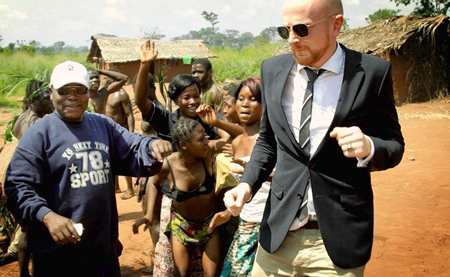 Then you have Mads Brügger’s dense and almost unbelievable follow-up to The Red Chapel,
where the Danish filmmaker/journalist goes full gonzo in impersonating a
European ambassador to Africa. The level of danger and corruption
uncovered is as jaw-dropping as you’d expect. Though both films are
flawed, the bravery it took to get them made should be praised wildly
and the cheap digital tools used to capture their unmistakable images
point to the future of stunt-performance movies to come.
Then you have Mads Brügger’s dense and almost unbelievable follow-up to The Red Chapel,
where the Danish filmmaker/journalist goes full gonzo in impersonating a
European ambassador to Africa. The level of danger and corruption
uncovered is as jaw-dropping as you’d expect. Though both films are
flawed, the bravery it took to get them made should be praised wildly
and the cheap digital tools used to capture their unmistakable images
point to the future of stunt-performance movies to come.
 19. The Patron Saints (Brian M. Cassidy and Melanie Shatzky) — Foregoing all the niceties we normally associate with films about the elderly, The Patron Saints
isn’t afraid to go bleak in its depiction of an unnamed nursing home.
It’s a disturbing film to say the least, but in refusing to hide from
the darkness, Cassidy and Shatzky achieve a hard-fought sweetness that
wins the day. In its negative review of the film, The Hollywood Reporter writes, “the film exists in the agonizing present tense.” I can’t think of a better compliment than that.
19. The Patron Saints (Brian M. Cassidy and Melanie Shatzky) — Foregoing all the niceties we normally associate with films about the elderly, The Patron Saints
isn’t afraid to go bleak in its depiction of an unnamed nursing home.
It’s a disturbing film to say the least, but in refusing to hide from
the darkness, Cassidy and Shatzky achieve a hard-fought sweetness that
wins the day. In its negative review of the film, The Hollywood Reporter writes, “the film exists in the agonizing present tense.” I can’t think of a better compliment than that.
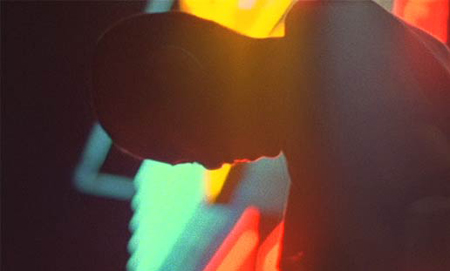 18. Kuichisan (Maiko Endo)
— I had a small role in helping this curious whatsit get finished, my
friend and collaborator Sean Price Williams photographed the picture,
and I know Maiko very well, but this movie still feels like it fell from
the sky fully formed. It’s a post-apocalyptic punk vision, shot as a
16mm documentary, about identity and youth and nationality in Okinawa,
Japan. Just see it.
18. Kuichisan (Maiko Endo)
— I had a small role in helping this curious whatsit get finished, my
friend and collaborator Sean Price Williams photographed the picture,
and I know Maiko very well, but this movie still feels like it fell from
the sky fully formed. It’s a post-apocalyptic punk vision, shot as a
16mm documentary, about identity and youth and nationality in Okinawa,
Japan. Just see it.
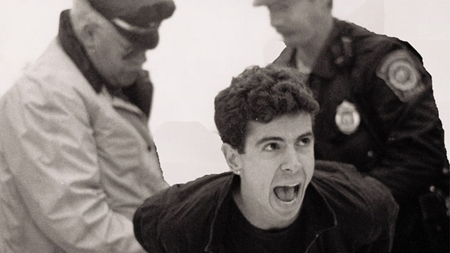 17. How To Survive A Plague (David France)
— Essential viewing. The AIDS epidemic and the heroic response by the
LGBT community is delivered as a present-tense struggle against
political irrelevancy and death. Like a war film that makes the viewer
feel the bullets whizzing overhead, How To Survive A Plague
places you firmly in the present-tense confusion of this
incomprehensible nightmare. France builds his structure with amazing
archival material, but the way he uses talking heads to create something
of a twist in the narrative is truly inventive. Powerful stuff.
17. How To Survive A Plague (David France)
— Essential viewing. The AIDS epidemic and the heroic response by the
LGBT community is delivered as a present-tense struggle against
political irrelevancy and death. Like a war film that makes the viewer
feel the bullets whizzing overhead, How To Survive A Plague
places you firmly in the present-tense confusion of this
incomprehensible nightmare. France builds his structure with amazing
archival material, but the way he uses talking heads to create something
of a twist in the narrative is truly inventive. Powerful stuff.
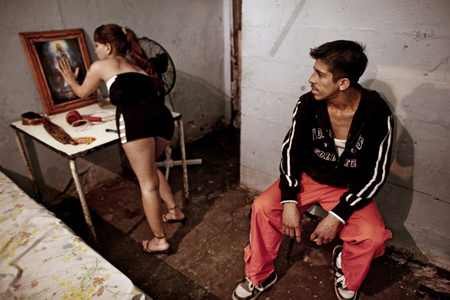 16. Whore’s Glory (Michael Glawogger)
— A film that obliterates the wall between fiction and nonfiction with
ease. Celebrated Austrian auteur Glawogger is concerned with how global,
abstracted systems (work, living conditions, and in this case, the
world’s “oldest profession”) affect and are affected by actual human
beings. He’s an aesthete and a stylist, but he gives as much attention
to the rhythms of real conversation as he does the mise en scène. This
is a film about sex as a commodity, sex as a source of power/oppression,
and how bodies and cultures interact.
16. Whore’s Glory (Michael Glawogger)
— A film that obliterates the wall between fiction and nonfiction with
ease. Celebrated Austrian auteur Glawogger is concerned with how global,
abstracted systems (work, living conditions, and in this case, the
world’s “oldest profession”) affect and are affected by actual human
beings. He’s an aesthete and a stylist, but he gives as much attention
to the rhythms of real conversation as he does the mise en scène. This
is a film about sex as a commodity, sex as a source of power/oppression,
and how bodies and cultures interact.
 15. Me @ The Zoo (Chris Moukarbel and Valerie Veatch)
— The rise and fall of internet hyper-celebrity Chris Crocker, known by
everyone as the “Leave Britney Alone” guy, is more effective than most
This is How We Live on the Internet Now movies because its primary
concern is understanding Crocker, not in understanding everyone who
watched his videos. With a visually quick-witted style and the same
bare-everything-now aesthetic as its star, Me @ The Zoo arrives with energy and delivers a truly amazing tale.
15. Me @ The Zoo (Chris Moukarbel and Valerie Veatch)
— The rise and fall of internet hyper-celebrity Chris Crocker, known by
everyone as the “Leave Britney Alone” guy, is more effective than most
This is How We Live on the Internet Now movies because its primary
concern is understanding Crocker, not in understanding everyone who
watched his videos. With a visually quick-witted style and the same
bare-everything-now aesthetic as its star, Me @ The Zoo arrives with energy and delivers a truly amazing tale.
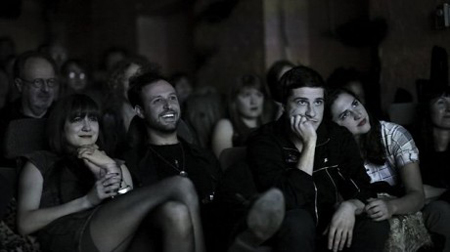 14. Open Five 2 (Kentucker Audley) — My pal Kentucker Audley appeared in another movie this year that could have made this list, Joe Swanberg’s meta-trick The Zone,
which deserves praise for its sexy layering of fiction and nonfiction.
But for his own work, Audley buries the meta and maximizes the intimacy
to lovely effect. Playing himself along side his real-life girlfriend
Caroline White, Audley recreates real events, lets chance have its say
and builds towards a subtle, emotional climax that is completely rooted
in lived-in observation. He would never call his work documentary, but
there’s no difference to me.
14. Open Five 2 (Kentucker Audley) — My pal Kentucker Audley appeared in another movie this year that could have made this list, Joe Swanberg’s meta-trick The Zone,
which deserves praise for its sexy layering of fiction and nonfiction.
But for his own work, Audley buries the meta and maximizes the intimacy
to lovely effect. Playing himself along side his real-life girlfriend
Caroline White, Audley recreates real events, lets chance have its say
and builds towards a subtle, emotional climax that is completely rooted
in lived-in observation. He would never call his work documentary, but
there’s no difference to me.
 13. Family Nightmare (Dustin Guy Defa) / Grimes’ “Oblivion“ (Emily Kai Bock) — Two short, vital pieces that make the case for the expansion of nonfiction technique. Dustin Guy Defa’s masterful Family Nightmare
gets my vote for scariest movie of the year by simply dubbing creepy
voices over truly disturbing home videos to gut-wrenching effect.
13. Family Nightmare (Dustin Guy Defa) / Grimes’ “Oblivion“ (Emily Kai Bock) — Two short, vital pieces that make the case for the expansion of nonfiction technique. Dustin Guy Defa’s masterful Family Nightmare
gets my vote for scariest movie of the year by simply dubbing creepy
voices over truly disturbing home videos to gut-wrenching effect.
Meanwhile the video for Canadian pop star Grimes’ song “Oblivion” plays with documentary by having the singer interact with real situations in playful and surprising ways. The result is a doc/music video hybrid full of pathos and joy.
 12. The Waiting Room (Peter Nicks)
— A deeply political film, mixing a Wiseman-like focus on the nuance of
institutions with a powerful humanism to deliver a portrait of an
Oakland hospital. The film wants to tell stories, wants to observe the
damage wrought by a flawed health care/economic system and succeeds with
a rough hand-made quality that adds to the immediacy of the emotional
portraits. Necessary viewing.
12. The Waiting Room (Peter Nicks)
— A deeply political film, mixing a Wiseman-like focus on the nuance of
institutions with a powerful humanism to deliver a portrait of an
Oakland hospital. The film wants to tell stories, wants to observe the
damage wrought by a flawed health care/economic system and succeeds with
a rough hand-made quality that adds to the immediacy of the emotional
portraits. Necessary viewing.
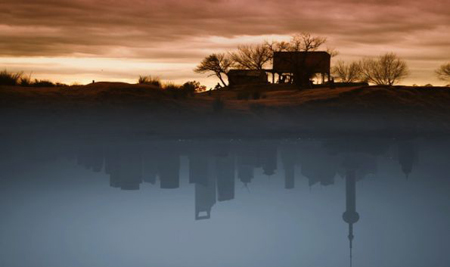 11. ¡Vivan Las Antipodas! (Victor Kossakovsky)
— This tricky, mysterious study of antipodes—places on Earth located
diametrically opposite to each other—by Russian master Victor
Kossakovsky (who was virtually unknown in this country until True/False
gave him their 2012 “True Vision Award”) is a cinematic carnival ride
of visual ideas and wonder, but it is equally adept at bringing to life
the people and places its gliding camera rests on.
11. ¡Vivan Las Antipodas! (Victor Kossakovsky)
— This tricky, mysterious study of antipodes—places on Earth located
diametrically opposite to each other—by Russian master Victor
Kossakovsky (who was virtually unknown in this country until True/False
gave him their 2012 “True Vision Award”) is a cinematic carnival ride
of visual ideas and wonder, but it is equally adept at bringing to life
the people and places its gliding camera rests on.
 10. Argentinian Lesson (Wojciech Staron)
— Swoon alert. Alive at every moment, this film is at once out-of-time
and happening-as-you-watch. Starring the Polish filmmaker’s own
seven-year-old son Janek as he adjusts to a new place in a foreign land,
Argentinian Lesson is full of tiny,
perfectly-rendered observations and an undeniable poetry that turns
daily routines and practical life-lessons into cinematic bliss.
10. Argentinian Lesson (Wojciech Staron)
— Swoon alert. Alive at every moment, this film is at once out-of-time
and happening-as-you-watch. Starring the Polish filmmaker’s own
seven-year-old son Janek as he adjusts to a new place in a foreign land,
Argentinian Lesson is full of tiny,
perfectly-rendered observations and an undeniable poetry that turns
daily routines and practical life-lessons into cinematic bliss.
 9. Tchoupitoulas (Bill and Turner Ross) — Criticized in some corners for compressing nine months of shooting into one glorious New Orleans night, Tchoupitoulas
should instead be lauded for draping itself in its dreamy cinematic
artifice and wearing its construction as a movie proudly. More
importantly, though, (full disclosure: my friends) the Ross brothers
have quickly become our most reliable documenters of place. Each new
film of theirs moving forward should be treated as an event.
9. Tchoupitoulas (Bill and Turner Ross) — Criticized in some corners for compressing nine months of shooting into one glorious New Orleans night, Tchoupitoulas
should instead be lauded for draping itself in its dreamy cinematic
artifice and wearing its construction as a movie proudly. More
importantly, though, (full disclosure: my friends) the Ross brothers
have quickly become our most reliable documenters of place. Each new
film of theirs moving forward should be treated as an event.
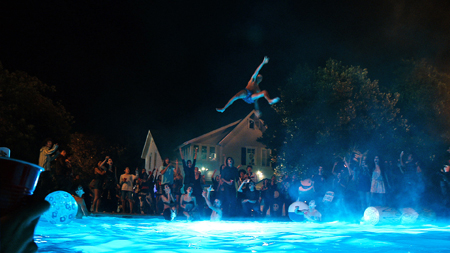 8. Project X (Nima Nourizadeh)
— This polarizing piece of high trash is just one of the fiction films
that play with a documentary aesthetic (the devotion to the iPhone
premise in King Kelly and the thrilling flight scene in Chronicle were also pretty great), but no other movie bent the rules so gleefully. Obviously fictional and silly, Project X
was still apparently made like a documentary—that’s a real party and
those are real cameras capturing legit mayhem. Nerd teen sex fantasies
are nothing new, but by going immersive and using nonfiction techniques,
with actors “playing” themselves, Project X goes beyond lusty hedonism as it devolves, by the end, into something close to a pure rush of nihilism.
8. Project X (Nima Nourizadeh)
— This polarizing piece of high trash is just one of the fiction films
that play with a documentary aesthetic (the devotion to the iPhone
premise in King Kelly and the thrilling flight scene in Chronicle were also pretty great), but no other movie bent the rules so gleefully. Obviously fictional and silly, Project X
was still apparently made like a documentary—that’s a real party and
those are real cameras capturing legit mayhem. Nerd teen sex fantasies
are nothing new, but by going immersive and using nonfiction techniques,
with actors “playing” themselves, Project X goes beyond lusty hedonism as it devolves, by the end, into something close to a pure rush of nihilism.
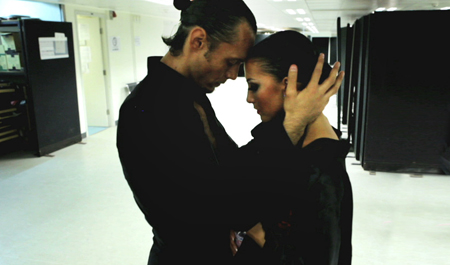 7. Ballroom Dancer (Christian Bonke and Andreas Koefoed)
— From the exciting Danish documentary movement comes this emotionally
gripping verité portrait of former World Latin Dance Champion Slavik
Kryklyvyy and his girlfriend and partner, Anna Melnikova. A story of
artistic and athletic obsession becomes a tale of love lost, with each
melodramatic note balanced by an attentive camera and a potent editorial
restraint.
7. Ballroom Dancer (Christian Bonke and Andreas Koefoed)
— From the exciting Danish documentary movement comes this emotionally
gripping verité portrait of former World Latin Dance Champion Slavik
Kryklyvyy and his girlfriend and partner, Anna Melnikova. A story of
artistic and athletic obsession becomes a tale of love lost, with each
melodramatic note balanced by an attentive camera and a potent editorial
restraint.
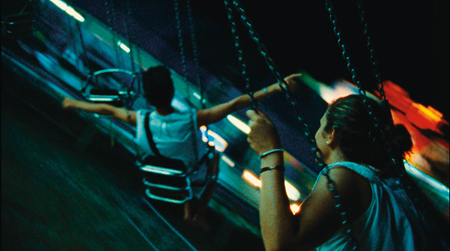 6. Summer of Giacomo (Alessandro Comodin)
— A film so pure in its portrayal of youth and love, so immediate in
its capturing of light and bodies, that it effortlessly wiggles free of
any documentary vs. fiction constraints.
6. Summer of Giacomo (Alessandro Comodin)
— A film so pure in its portrayal of youth and love, so immediate in
its capturing of light and bodies, that it effortlessly wiggles free of
any documentary vs. fiction constraints.
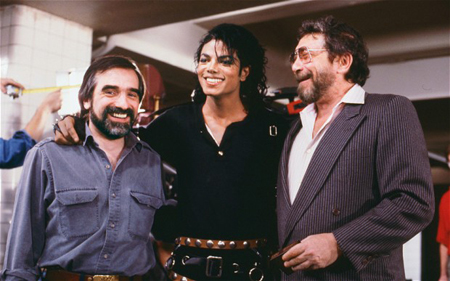 5. Bad 25 (Spike Lee)
— Finally we have the definitive Michael Jackson film. In his
particular pop-doc style, Spike Lee gets at the cultural icon’s vast
influence by going narrow and focusing on the wildly popular (though
often derided) Bad album. From this
song-to-song hyper-focus a stunning portrait emerges of an
African-American artist at his highest peak. “Man in the Mirror” as the
finale is masterfully devastating.
5. Bad 25 (Spike Lee)
— Finally we have the definitive Michael Jackson film. In his
particular pop-doc style, Spike Lee gets at the cultural icon’s vast
influence by going narrow and focusing on the wildly popular (though
often derided) Bad album. From this
song-to-song hyper-focus a stunning portrait emerges of an
African-American artist at his highest peak. “Man in the Mirror” as the
finale is masterfully devastating.
 4. Two Years At Sea (Ben Rivers) — A film full of magic, where light leaks merge with the environment at the surface of the image. Genre-defying at its core, Two Years At Sea
is about myths and loss and growing old and movies, where experience
and process converge and one man’s experience is rendered universal.
4. Two Years At Sea (Ben Rivers) — A film full of magic, where light leaks merge with the environment at the surface of the image. Genre-defying at its core, Two Years At Sea
is about myths and loss and growing old and movies, where experience
and process converge and one man’s experience is rendered universal.
 3. This Is Not A Film (Jafar Panahi and Mojtaba Mirtahmasb)
— This stunning film is not only the next logical step in Iranian
meta-cinema, but a brave act of political defiance. As a documentary,
being labeled “not a film” is not simply a legal maneuver but a freeing
act of expression, bringing the weight of the present tense to the
forefront and creating an almost unprecedented immediacy. The last scene
of the movie, a random trip down an elevator with a trash collector
that leads to a shocking history-as-it-happens moment, is maybe the best
10 minutes of pure cinema this year.
3. This Is Not A Film (Jafar Panahi and Mojtaba Mirtahmasb)
— This stunning film is not only the next logical step in Iranian
meta-cinema, but a brave act of political defiance. As a documentary,
being labeled “not a film” is not simply a legal maneuver but a freeing
act of expression, bringing the weight of the present tense to the
forefront and creating an almost unprecedented immediacy. The last scene
of the movie, a random trip down an elevator with a trash collector
that leads to a shocking history-as-it-happens moment, is maybe the best
10 minutes of pure cinema this year.
 2. Only The Young (Elizabeth Mims and Jason Tippet) — A nearly perfect film about youth. Only The Young
is a subtle and beguiling portrait of three Southern California
teenagers that unfolds with such ease that one might not immediately
recognize how exact every frame is or how perfectly calibrated is each
moment. The film’s unhurried, non-judgmental style is an antidote to the
desperate need-to-entertain-and-explain compulsion that you find in
most documentaries based around interviews. There have been some great
films made about the lives of teenagers and Only The Young has claimed its spot as one of the best.
2. Only The Young (Elizabeth Mims and Jason Tippet) — A nearly perfect film about youth. Only The Young
is a subtle and beguiling portrait of three Southern California
teenagers that unfolds with such ease that one might not immediately
recognize how exact every frame is or how perfectly calibrated is each
moment. The film’s unhurried, non-judgmental style is an antidote to the
desperate need-to-entertain-and-explain compulsion that you find in
most documentaries based around interviews. There have been some great
films made about the lives of teenagers and Only The Young has claimed its spot as one of the best.
 1. Leviathan (Véréna Paravel and Lucien Castaing-Taylor)
— From the near-revolutionary Sensory Ethnography Lab at Harvard comes
one of the most important documentaries ever made. By pushing their
immersive verité portrait of a Maine fishing boat and its crew past the
point of observation and into pure abstraction, co-directors
Castaing-Taylor and Paravel have created a new type of experiential
cinema and have drawn the map to the future. There is no going back
after a masterwork like Leviathan. The game has changed.
1. Leviathan (Véréna Paravel and Lucien Castaing-Taylor)
— From the near-revolutionary Sensory Ethnography Lab at Harvard comes
one of the most important documentaries ever made. By pushing their
immersive verité portrait of a Maine fishing boat and its crew past the
point of observation and into pure abstraction, co-directors
Castaing-Taylor and Paravel have created a new type of experiential
cinema and have drawn the map to the future. There is no going back
after a masterwork like Leviathan. The game has changed.
Girl Walk // All Day
Low & Clear
Off Label
Beauty is Embarrassing
The Clock
Into The Abyss
Kumare
The Law In These Parts
An Oversimplification of Her Beauty
Reconversão
Room 237
Shut Up And Play The Hits
Stories We Tell
The Vanishing Spring Light
The Imposter
The Invisible War
Jiro Dreams of Sushi
Searching For Sugar Man
— Robert Greene
Welcome to the second annual Hammer to Nail Awards!
The ever-increasing torrent of end-of-the-year lists and trophies can
become an overwhelming blur, which is just one of the reasons why we
here at HTN have made a commitment to do something
different with our own contribution to the fray. As with last year, we
are focusing our attention on AMERICAN NARRATIVES THAT WERE PRODUCED FOR ONE MILLION DOLLARS OR LESS.
If you revisit the 2008 Hammer to Nail Awards post, you might see some overlap with a few of this year’s titles. I take full responsibility for that, as I was still trying to figure out the best plan of attack for this complicated endeavor. Now that we’ve been through the rigamarole once, we have come to settle on the following overriding guideline: A FILM IS ELIGIBLE IF IT RECEIVED SOME FORM OF PUBLIC RELEASE, WHETHER IT BE THEATRICAL, VOD, OR STRAIGHT-TO-DVD, IN SAID CALENDAR YEAR. Last year, we were counting festival premieres, which is unfair to filmmakers, as many of our contributors hadn’t been able to catch up with that work until it received an even somewhat legitimate release. This is the main reason for taking this approach, which can seem less timely but, in the grander scheme, makes the most overall sense. We are confident that all of these films—especially the cream of the crop—will eventually find a public release (see last year’s Prince of Broadway, which won’t technically become eligible until next year!—or this year’s Number 3, which we were worried might never see the light of day).
As for the voting process, that has remained the same. Each main HTN contributor (see bottom of post for this year’s voters) was asked to submit their Top 10 Films of 2009. Ten points were assigned to each number one, nine points were assigned to the number two, and on down the line. These results were tallied into the list you see below. In the case of ties, the film that appeared on the most ballots received the edge.
One final note: NO ONE WAS ALLOWED TO VOTE FOR A FILM IN WHICH THEY RECEIVED A CREW CREDIT.
Thanks so much for reading and supporting our mission at Hammer to Nail. Times are tight, but we’re determined to keep moving forward and carefully curating your viewing experience, whether it be in a theater, on television, on your computer, or on something even smaller than that. And now, onto the main event…
THE GOLDEN HAMMER AWARD:
The indie film industry has imploded, due to reduced demand, the decline of DVD sales, the folding of theatrical distributors, and the drying up of funding sources caused by the economic crash. The industry as we once knew it has in effect vanished. However, that statement is applicable only toward your own take on the term. If your definition of ‘indie film’ starts with Sex, Lies, and Videotape, Spike Lee and Kevin Smith, then yes, that industry has died. The sale of Steven Soderbergh’s 1989 breakout hit inspired the major studios to create “indie sub-companies,” some of which were distributors and some of which were content developers. Over the years, between Sex, Lies and Hamlet 2 (the last eight-figure Sundance deal), the indie industry grew to embody not maverick ideas and techniques but instead tepid warmed over sub-par industry drivel. Fueled by the box office success of films like Napoleon Dynamite and Little Miss Sunshine, the American indie film movement ossified into the indie-quirk-pseudo-grunge-alt-maverick business defined by such recent films as Sunshine Cleaning and Arlen Faber (aka The Answer Man). As we step toward the first Sundance without Geoff Gilmore all I can say is:
THE AMERICAN INDIE FILM INDUSTRY IS DEAD… HALLELUJAH!
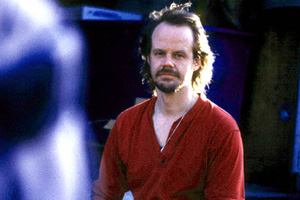 While
all that hullabaloo was going on over at Sundance, while people made
more and more money and the films got blander and more ‘commercial,’
there was a toothless NYC curmudgeon toiling in the shadows of the East
Village. Amazing feature after feature, like Habit and Wendigo,
blew my mind with their classical yet aggressively pointed spins on the
horror genre. It was clear to me, and most everyone who saw the work of
Larry Fessenden, that there was a fully accomplished
voice working within the genre, saying something significant about what
it means to be alive today.
While
all that hullabaloo was going on over at Sundance, while people made
more and more money and the films got blander and more ‘commercial,’
there was a toothless NYC curmudgeon toiling in the shadows of the East
Village. Amazing feature after feature, like Habit and Wendigo,
blew my mind with their classical yet aggressively pointed spins on the
horror genre. It was clear to me, and most everyone who saw the work of
Larry Fessenden, that there was a fully accomplished
voice working within the genre, saying something significant about what
it means to be alive today.
It was always clear to me that though Larry works in the horror genre, his voice is as authentic and as passionate as the first pioneers of true indie cinema, people like Oscar Micheaux, John Cassavetes and Kenneth Anger. The fact that these earlier films of his never played in the Midnight section at Sundance is criminal. Late night after late night I sat in the Egyptian theater watching some bland Tarantino wannabe or some slick piece of crap like Donkey Punch wondering, “Why isn’t Larry Fessenden here?”
Well, that period of indie film, marked by those go-go Sundance years, is gone. I say good riddance. I hope some of the ’stars’ of that period have returned to selling real estate, because it was their drive to make money that sidetracked the authentic indie film spirit. I’m glad their game has gone bust. In its wake will rise true independent visions, films made by people who have something to say, and all the soulless LA sub-companies of the Hollywood industrial entertainment mind-melt industry can go to blazes as they watch the future rise out of the gutter. It’s great that the ‘industry’ is dead because maybe now the crap that these companies forced onto the small screens will go away and true indie film companies like GLASS EYE PIX will rise to the foreground.
 In the past few years GLASS EYE PIX—and now Fessenden’s low-budget horror banner SCAREFLIX—has
been responsible for some of this past decade’s best work, from the
films of Kelly Reichardt (that was Larry acting in her first film River of Grass as well as her most recent Wendy and Lucy) to the Ti West mindbenders The Roost and The House of the Devil, to Larry’s own The Last Winter.
This year alone has seen an amazing batch of new releases, including
Graham Reznick’s startling one-two punch of the camping trip-gone-awry
feature I Can See You and the amazing hand-made true 3D short The Viewer.
In the past few years GLASS EYE PIX—and now Fessenden’s low-budget horror banner SCAREFLIX—has
been responsible for some of this past decade’s best work, from the
films of Kelly Reichardt (that was Larry acting in her first film River of Grass as well as her most recent Wendy and Lucy) to the Ti West mindbenders The Roost and The House of the Devil, to Larry’s own The Last Winter.
This year alone has seen an amazing batch of new releases, including
Graham Reznick’s startling one-two punch of the camping trip-gone-awry
feature I Can See You and the amazing hand-made true 3D short The Viewer.
My favorite 2009 effort from the GLASS EYE PIX stable, however, is Glenn McQuaid’s I Sell The Dead, a film savvy journey through horror history that gleefully combines a graveyard robbing Hammer film from the mid-1960s with a brash high contrast classic lurid Zombie movie of the ‘80s. Wrapped up in dark humor and creepy shocks, I Sell the Dead has it all. But Larry and his collaborators do more than just make excellent films on micro-budgets. They hype the heck out of them, with great viral and old-fashioned three-dimensional merchandising tactics (playing cards, comic books, posters, etc.).
A company like GLASS EYE PIX—and, in turn, SCAREFLIX—is the future of indie cinema, a small, individually run force, driven by passion and an aesthetic vision that can embrace both pure character driven pieces like Wendy and Lucy, as well as informed, intelligent genre films such as The House of the Devil and I Sell The Dead. Mark my words, this is a company that will eventually have a Paranormal Activity-level breakout hit. In the meantime, keep track of their releases and get stunned, rocked, shocked, and transported. Welcome to the new world, where GLASS EYE PIX is the model. For all of these reasons, for being such an inspiring force in the industry, we give Larry Fessenden the 2009 GOLDEN HAMMER AWARD. He’s the past, present, and future combined. He is American Independent Cinema. — Mike S. Ryan
THE SILVER NAIL AWARD:
Every so often, a vision emerges from directly behind the camera that feels as important as—or more important than—the person who’s sitting in the director’s chair. From the very first frame of Antonio Campos’ Afterschool, it’s immediately clear that whoever is shooting this picture is good. And as the film goes on, it’s hard to suppress the feeling that one is watching a master cinematographer at work. Months before experiencing Afterschool on the big screen at the New York Film Festival in the fall of 2008, I had a strangely similar reaction to a film that couldn’t have been more different. As I watched Matt Wolf’s Wild Combination: A Portrait of Arthur Russell at the 2008 Sarasota Film Festival, I found myself awed by the imagery. And not just the beautifully grainy recreations that were shot on film. Something about the video interviews had a warmth and tenderness that felt much more cinematic than I was used to seeing in this type of project. Without question, in this instance the cinematography had made a good movie great.
 It turns out the same person was responsible for the imagery in both of these films. His name: Jody Lee Lipes.
Though not yet thirty, and with only these two features under his belt
(though much more work was being done along the way: videos,
commercials, shorts, etc.), Lipes exhibited a technical range,
intelligence, and care that reached far beyond his years. This year,
with the premiere of his own documentary, Brock Enright: Good Times Will Never Be The Same, at the 2009 South by Southwest Film Festival, Lipes confirmed what I suspected: he’s a great director too.
It turns out the same person was responsible for the imagery in both of these films. His name: Jody Lee Lipes.
Though not yet thirty, and with only these two features under his belt
(though much more work was being done along the way: videos,
commercials, shorts, etc.), Lipes exhibited a technical range,
intelligence, and care that reached far beyond his years. This year,
with the premiere of his own documentary, Brock Enright: Good Times Will Never Be The Same, at the 2009 South by Southwest Film Festival, Lipes confirmed what I suspected: he’s a great director too.
Like Afterschool, Brock Enright has elicited fiercely passionate reactions from both yaysayers and naysayers. But in my experience, what people “hate” about Brock Enright has nothing to do with the point Lipes is actually making. As in, he didn’t set out to make a “point.” A bracingly intimate portrait of controversial New York City artist Brock Enright as he travels out west with his girlfriend Kirsten Deirup to work on a new gallery commission on her parents’ land in the Upstate California woods, BE:GTWNBTS feels downright revolutionary. Whereas most no-budget filmmakers are running around trying to make their lazily unscripted narrative features feel like sloppy documentaries, Lipes filmed his real situations to look and feel like a European art film. The effect is mesmerizing.
 As
his deadline approaches and Deirup continues to grill him about their
mounting bills back in Brooklyn, Enright begins to succumb to the
pressure. And when the director of the Perry Rubenstein Gallery visits
the compound to check up on Brock, the situation spins all the way out
of control. The unsettling nature of the content, mixed with Lipes’
innovative approach to shooting his material, is undoubtedly the reason
for so much viewer discomfort (i.e., discomfort = dissatisfaction). But
for someone who yearns to see a universal story—the mounting pressures
of a twenty-something couple—told in such a fresh way, there is no
discomfort. There is only exhilaration. Though BE:GTWNBTS
has not yet been picked up for distribution, that will happen. But more
importantly, Lipes continues to work both behind the camera and from
the director’s chair. In some cases, as with the upcoming NY Export: Opus Jazz, he’s doing both.
As
his deadline approaches and Deirup continues to grill him about their
mounting bills back in Brooklyn, Enright begins to succumb to the
pressure. And when the director of the Perry Rubenstein Gallery visits
the compound to check up on Brock, the situation spins all the way out
of control. The unsettling nature of the content, mixed with Lipes’
innovative approach to shooting his material, is undoubtedly the reason
for so much viewer discomfort (i.e., discomfort = dissatisfaction). But
for someone who yearns to see a universal story—the mounting pressures
of a twenty-something couple—told in such a fresh way, there is no
discomfort. There is only exhilaration. Though BE:GTWNBTS
has not yet been picked up for distribution, that will happen. But more
importantly, Lipes continues to work both behind the camera and from
the director’s chair. In some cases, as with the upcoming NY Export: Opus Jazz, he’s doing both.
For his creativity, startling execution, and daring work on Brock Enright: Good Times Will Never Be The Same and Afterschool (which finally made its way into theaters in 2009), for truly straddling the line between fiction and nonfiction, erasing those boundaries in a way that should have both camps rejoicing—especially you documentary advocates, wake up, people!—Jody Lee Lipes earns our 2009 SILVER NAIL AWARD. — Michael Tully
THE BEST FILM OF 2009:
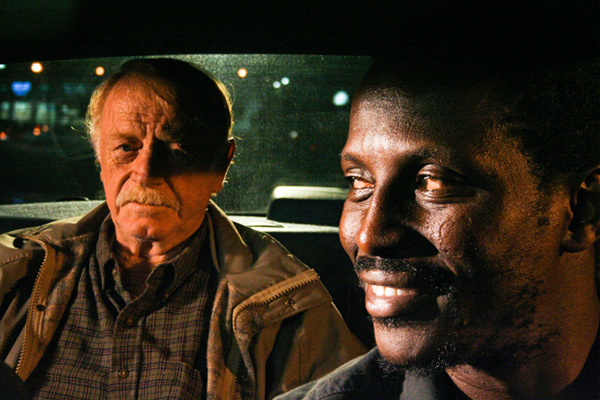
Goodbye Solo (Ramin Bahrani) — Who needs a big budget when you’ve got great storytelling? Though his first two features, Man Push Cart and Chop Shop, established Ramin Bahrani as a talented new American filmmaker in the tradition of the Neo-Realist masters of yore, with Goodbye Solo, he officially joined their ranks. Set in Bahrani’s hometown of Winston-Salem, North Carolina, the film tells the tale of two figures whose paths cross incidentally when a Senegalese cab driver, Solo (Souleymayne Sy Savane), receives a strange proposition from a fare, William (Red West). Solo understands what this proposition really means, yet rather than simply ignoring the signs as would be expected in these increasingly selfish, hurried times and letting William drift away, he latches on to this bitter man and won’t let go. As portrayed by Savane, Solo has a tireless spirit that can’t be extinguished. Yet as the film builds to its quietly transcendent climax, he learns that some people’s pain is simply too much to bear. For saying so much with so little, for being simultaneously sobering and uplifting, for capturing the true multi-cultural spirit of 21st century America, and, most importantly, for receiving the most votes, Goodbye Solo is our Best Film of 2009. — MT
(Click on the titles below to read their official HTN reviews, and click on the names to read our HTN conversations with these extremely talented directors.)
THE TOP 13 FILMS OF 2009:
1. Goodbye Solo (Ramin Bahrani)
2. The House of the Devil (Ti West)
3. Munyurangabo (Lee Isaac Chung)
4. Medicine for Melancholy (Barry Jenkins)
4. Treeless Mountain (So Yong Kim)
6. Humpday (Lynn Shelton)
7. That Evening Sun (Scott Teems)
8. Sita Sings the Blues (Nina Paley)
8. Severed Ways: The Norse Discovery of America (Tony Stone)
10. Afterschool (Antonio Campos)
11. Children of Invention (Tze Chun)
12. Stingray Sam (Cory McAbee)
13. Weapons (Adam Bhala Lough)
Other Films Receiving Votes (in alphabetical order):
Beeswax (Andrew Bujalski)
Big Fan (Robert Siegel)
Christmas on Mars (Wayne Coyne)
Confessionsofa Ex-Doofus-ItchyFooted Mutha (Melvin Van Peebles)
Everything Strange and New (Frazer Bradshaw)
Half-Life (Jennifer Phang)
Harmony and Me (Bob Byington)
I Sell the Dead (Glenn McQuaid)
It Is Fine. Everything Is Fine! (Crispin Glover)
Loren Cass (Chris Fuller)
The New Year Parade (Tom Quinn)
Paper Covers Rock (Joe Maggio)
The Princess of Nebraska (Wayne Wang)
The Toe Tactic (Emily Hubley)
White on Rice (Dave Boyle)
(Contributors: Pamela Cohn, Cullen Gallagher, Tom Hall, Brandon Harris, Ted Hope, Holly Herrick, Nelson Kim, Michael Lerman, Evan Louison, David Lowery, Mike S. Ryan, Michael Tully)
We started Hammer to Nail at the beginning of 2008 with
one goal in mind: to champion the most adventurous, ambitious,
provocative, and exciting low-budget American narrative cinema of the
very moment. And though we have broadened our horizons to cover
exceptional films of all shapes, sizes, and ages, that primary purpose
remains the same. To prove our commitment to this cause, we present to
you the inaugural Hammer to Nail Awards.
In order to get the fairest and most comprehensive result possible, we asked H2N’s current roster of expert contributors to submit their own top ten lists that fit within the following parameters: American narratives (shorts or features) made for under one million dollars that either premiered or received some form of a theatrical release in 2008. These results were weighed, measured, and combined to produce a democratic final tally.
This process can get complicated. What about those titles that premiered towards the end of the year and have had minimal screenings up to this point (such as So Yong Kim’s Treeless Mountain or Ramin Bahrani’s Goodbye Solo)? Or what about those 2007 premieres that weren’t seen by many and never found distribution in 2008 (such as Lee Isaac Chung’s criminally overlooked Munyurangabo)? After much deliberation, we have removed films such as these from contention. Our hope is that, moving forward in the years to come, no more gems will slip through the cracks.
Looking over the final list, it is screamingly clear that outside-the-system, low-budget American independent cinema isn’t just alive and well; it’s thriving. While it’s too early to determine, we feel strongly that 2008 has been a banner year and will stand the test of time. But what makes the situation even more unique is that these films have emerged just when the distribution landscape is rapidly shrinking. Though the movies are better than ever, it is incredibly difficult to get them shown. Imagine what it would be like if there were real opportunities for these films to be seen by wider audiences. That’s why we started this site, and that’s why we’re handing out these awards. We applaud the following filmmakers for inspiring us, and we hope they receive the attention and acclaim they so rightly deserve. And now, without further ado…
THE GOLDEN HAMMER AWARD
Lance Hammer — The 2008 Sundance Film Festival began with a whimper. There was much grumbling in that opening weekend as press screening after press screening unveiled work that varied from mediocre to worse. And then came Ballast, which felt like a master songwriter stepping on stage at the end of a particularly amateurish open mic night. Lance Hammer’s directorial debut didn’t feel like a debut at all. It had a command of tone that most experienced directors only dream of achieving. With grace and intelligence—and gorgeous natural light 35mm cinematography—Hammer found the poetic tenderness inside a cold, harsh, somber Mississippi Delta landscape. Ballast took home two awards at the festival—Dramatic Directing and Excellence in Cinematography—and distributors came calling. Yet after a flirtation with IFC Films, Hammer decided to retain the film’s rights and forge his own distribution path. It is for both of these reasons—making an extraordinary film the old-fashioned way yet distributing it the new-fashioned way—that Lance Hammer is the recipient of our first ever Golden Hammer Award.
THE SILVER NAIL AWARD
Sean Baker — We wanted to give an award to the filmmaker who did the most with the least. Sean Baker shattered that concept by delivering two films for the price of barely-even-one. Though Take Out (co-directed with Shih-Ching Tsou) debuted in 2004, it didn’t receive a proper theatrical release until this year (reviews were unanimously positive). Shortly after that, Baker world-premiered his next feature, Prince of Broadway, at the Los Angeles Film Festival, where it won the coveted Target Filmmaker Award. Separately, these films are micro-budget digital cinema of the highest order, yet when placed next to one another, they become something much more important. This isn’t just the work of an on-the-margins filmmaker with a video camera. It’s the work of one of America’s most vital social realists transcending his limitations to present worlds that pulse with documentary-like realism and throb with humanity. And so, for proving that budget doesn’t matter in delivering the finest one-two punch of 2008, we present Sean Baker with our Silver Nail Award.
THE BEST FILM OF 2008
Frownland (Ronald Bronstein) — For most of us, the Frownland revelation came in 2007, either at its SXSW world premiere (where it won a Special Jury Award for Singularity of Vision) or during its subsequent festival run. But 2008 is when the film found its way into actual theaters, albeit on a sadly limited basis (it didn’t win a “Best Film Not Playing At A Theater Near You” Gotham Award for nothing). Still, these one-week, self-booked runs were enough to catch the attention of two of America’s most revered critics—Manohla Dargis and Roger Ebert—who both recognized the mad genius on display. But we knew that already. Not only did Frownland receive the most points in our poll, it received the most number one votes as well, making it a shoo-in for the top spot. While this year’s list is overflowing with brave and adventurous acts of personal creative expression, Frownland is a universe unto itself. It’s what Hammer to Nail is all about.
(Click on the titles below to read their official H2N reviews.)
THE TOP 13 FILMS OF 2008
1. Frownland (Ronald Bronstein)
2. Momma’s Man (Azazel Jacobs)
3. Ballast (Lance Hammer)
4. Wendy and Lucy (Kelly Reichardt)
5. The Pleasure of Being Robbed (Joshua Safdie)
6. Shotgun Stories (Jeff Nichols)
7. Prince of Broadway (Sean Baker)
8. Take Out (Sean Baker and Shih-Ching Tsou)
9. The Pool (Chris Smith)
10. Afterschool (Antonio Campos)
11. Glory at Sea (Benh Zeitlin)
12. Chop Shop (Ramin Bahrani)
13. Medicine For Melancholy (Barry Jenkins)
Other Films Receiving Votes (in alphabetical order)
The Acquaintances of a Lonely John (Benny Safdie)
The Adventure (Mike Brune)
Baghead (The Duplass Brothers)
Confessionsofa Ex-Doofus-Itchyfooted Mutha (Melvin van Peebles)
Goliath (The Zellner Brothers)
The Foot Fist Way (Jody Hill)
A Good Day to Be Black and Sexy (Dennis Dortch)
Half-Life (Jennifer Phang)
Hug (Khary Jones)
I am so proud of you (Don Hertzfeldt)
Idiots and Angels (Bill Plympton)
My Effortless Brilliance (Lynn Shelton)
The New Year Parade (Tom Quinn)
Nights and Weekends (Joe Swanberg and Greta Gerwig)
Pop Foul (Moon Molson)
Present Company (Frank V. Ross)
The Second Line (John Magary)
Sita Sings the Blues (Nina Paley)
Small Apartment (Andrew Thomas Betzer)
Wellness (Jake Mahaffy)
Woodpecker (Alex Karpovsky)
Yeast (Mary Bronstein)
(Contributors: Lena Dunham, Cullen Gallagher, Tom Hall, Brandon Harris, Ted Hope, Holly Herrick, Nelson Kim, Michael Lerman, David Lowery, Mike S. Ryan, Michael Tully)
And just like that, the game appears to be changing, as the once
wholly loveable Netflix doesn’t seem to care just how quickly it’s about
to fall out of favor with a group of passionate movie lovers such as
ourselves. No, I’m not referring to the new pricing plan. In fact, my
memory is that in the early days of Netflix, my tab landed at around 15
dollars each month for a subscription (for 3 discs out at a time, I seem
to recall it being 19 dollars?). Back then, that number didn’t seem
outrageous to me. To be honest, as a filmmaker, the shrinking monthly
rate for streaming everywhere seems like a dangerous proposition, for it
alerts me to the fact that films aren’t being accounted for on a
stream-by-stream basis. Which, if one does some even basic mathematics,
has the filmmaker coming up shorter than ever. But that’s for another
article that someone far more informed than myself will hopefully write (this one certainly provides valuable insight).
It’s not the monthly fee that has me so disappointed. It’s that I didn’t just think Netflix used to be a big supporter of the little guys, I knew they were (this was based on statistical data relayed to me by distributor friends and associates). Yet not anymore. Rather than building and maintaining as comprehensive a library as possible and using their assets to their advantage, Netflix is instead abandoning this concept in favor of a more streamlined approach: i.e., concentrating predominantly on TELEVISION and BIG STUDIO PRODUCT. Obviously—you will get no argument from me here—this is where the real money exists, and it’s what has helped Netflix to become such a business juggernaut. But part of what made Netflix so special is that they were using their position of power to acquire smaller titles to the point where it seemed like that was part of their overriding mission. Perhaps this was never the case. Either way, reality has arrived.
We’ve never had any official partnership with Netflix. When we started up our ongoing “Netflix Hidden Gems” column, we did it out of appreciation for what they were doing. Who knows, maybe we’re jumping the gun here. But it sure doesn’t seem like it. The situation with Criterion provided the first chink in their armor, and now, it seems like the tower is beginning to crumble. For now, we are renaming this column “Hidden Gems” so that we can include other sites that provide services similar to Netflix but who are more interested in ambitious cinema than television. ***Let it be known that I personally realize that we should have been doing this all along, and for that I apologize.***
Soon, I am planning to post a trusted, as-comprehensive-as-possible guide to alert you to all the other exciting options that are out there, though this post is a good way to get that ball rolling. Though this Netflix development is a disappointing one, it certainly isn’t the end of the world. Hopefully, it will turn out to be the beginning of an even brighter home video future for all of us. As usual, only time will tell…
HIDDEN GEMS – SUMMER MEGAMIX
The New York Ripper (1982) — This is Lucio Fulci’s dazzilingly stylish, gruesomely gritty, and totally outlandish slasher flick. A killer is stalking the Big Apple, slicing up beautiful young women with sharp knives and broken bottles. The only clue? The killer quacks like a duck. As absurd as it is frightening, The New York Ripper is fueled by an existentialist drive that boils the essence of terror to its primal fears and desires. Plus, the on-location shooting is superb, including a late-night chase through the Hoyt-Schermerhorn subway station! (Cullen Gallagher)
NETFLIX: Stream
GREENCINE: Rent
FACETS: Rent
Up Tight! (1968) — Unavailable on DVD and effectively suppressed after its brief release, Up Tight!, a terse and melancholic 1968 thriller from Jules Dassin (Rififi) is suddenly available on Netflix Instant! An odd piece of socio-cultural history, it’s a Hollywood film which offers, despite its genre trappings, the most eloquent dramatization of the tensions that ultimately fractured the Civil Rights Movement. Dassin’s remake of John Ford’s The Informer—set amongst warring black nationals and liberal integrationists in the impoverished Hough district of Cleveland—is informed very much by its northeastern Ohio setting and the historical moment. Co-scripted by stars Julien Mayfield and Ruby Dee, the film features Mayfield as a doomed black nationalist ostracized for his drunkenness and ineptitude, who turns snitch for the cops. The great cinematographer Boris Kaufman makes Hough into a shadowy and nightmarish post-industrial wasteland, albeit one punctuated by illusive moments of beauty. (Brandon Harris)
NETFLIX: Stream
Paid in Full (2002) — Charles Stone III’s underrated gangster drama set in 1980s Harlem is genre filmmaking of a high order: what in lesser hands would come across as a retread of clichés instead takes on a nearly classical grandeur. Even the most inventive contemporary crime movies, like the work of Tarantino and the Coens, sometimes seem to be taking place in a world disconnected from recognizable social reality. Stone, in his first feature film (he went on to make the crowd-pleaser Drumline), yanks the genre out of its closed loop of ever-more-baroque film-geek flourishes, and jolts it full of life. Paid in Full restores a sense of tragic consequence to its heroes’ downfall, and many viewers will be left shaken and appalled as the film arcs its way to its conclusion. Most mainstream reviewers ignored the film upon its release, and its distributor, Miramax/Dimension, treated it as just another disposable ‘hood shoot-’em-up. But people will go on rediscovering it on video and talking about it for years to come. (Read Nelson Kim’s full review here.)
NETFLIX: Stream/Rent
HULU PLUS: Stream
Dominick Dunne: After the Party (2008) — Dominick Dunne said things so other people didn’t have to. His lauded Vanity Fair articles show his commitment to revealing the ugliness in power, the unspoken lies of Hollywood. In After the Party directors Kristy de Garis and Timothy Jolley show an aged, sage Dunne looking back on his life, one that could stand in for the post-war American journey. Chronicling the Phil Spector trial while recounting stories with Hollywood legends, Dunne shows us the thin line between celebrity and tragedy. (Jesse Klein)
NETFLIX: Stream
GREENCINE: Rent
HULU: Free Stream!
AMAZON INSTANT: Stream
ITUNES: Rent
Rockers (1978) — The perfect summer jam. Greek director Ted Bafaloukos spent two years in Jamaica “casting” the reggae musicians who largely play themselves in his sunny, rasta version of The Bicycle Thief. The plot is thin, but who cares? The search for a stolen motorbike is a reason to follow drummer Leroy “Horsemouth” Wallace around his Jamaica, a 1970s haze of color, smoke, style, and beats. Horsemouth and his Dreads are tricksters, carried by hustle, quick wit, and only occasional violence. Mostly they goof, run records, and brush off their women, inspiring generations of rolling stones with the idea that home is just a place to change your shirt. The slang is so thick you need subtitles, but the music (Jacob Miller, Burning Spear, Gregory Isaacs) is loud and clear. (Susanna Locascio)
NETFLIX: Stream/Rent
GREENCINE: Rent
FACETS: Rent
ITUNES: Rent
Gone With The Wind (1939) — If you didn’t get the weekend beach invite and can’t bear the sight of Prospect or McCarren park on another Saturday, than call whomever you know with a hearty AC unit and a decent couch* and make a day of watching Gone With the Wind, a recent addition to Netflix Instant. Since the film is roughly four hours long, if you plan it right you can miss the hottest part of the day, especially if you bookend the film with meals and/or drinks. *Or use Rhett and Scarlet’s amorous banter to take you and your summer fling to the next level in a comfy bed. (Alexandra Roxo)
NETFLIX: Stream/Rent
GREENCINE: Rent
FACETS: Rent
AMAZON INSTANT: Stream
ITUNES: Rent
The Man In The Net (1959) – This is one of those bizarre films that got made in the bustling studio heyday that makes you ask “what the hell were they thinking?” It stars Alan Ladd as an introspective NYC painter who has retired to the country to pursue his artistic dreams. He spends his days in the fields painting happy country children at play while his younger city slicker wife, Carolyn Jones (Morticia on the original Addams Family), hits the bottle hard and flirts with the square-jawed local cop. The first few scenes have the couple battling it out like Who’s Afraid of Virginia Woolf?, except Ladd’s tight-lipped steady eddy calm demeanor is like Liz Taylor facing off against a Richard Burton loaded up on Prozac. That spins off into a murder mystery when he returns from a trip to the city to find the raving wife gone and his paintings all slashed to shreds. Then those children of the fields become key players in Ladd’s plot to save himself and find his wife’s true killer. The kids are those types of overly emotive ‘50s era stage kids that come off as super-creepy-too-perfect and director Michael Curtiz (Casablanca) dotes on them a bit too much. A truly strange off kilter film that may have been motivated by writer Reginald Roses’ (12 Angry Men) interest in larger issues like those surrounding the themes of class, race and art versus commerce, but in the end boils down to an overwrought freaky hybrid where the NYC stage meets a whodunnit in a low-budget Children of the Damned. (Mike S. Ryan)
NETFLIX: Stream
Mamachas del Ring (2009) — Set in the surreal and spectacular world of cholita wrestling, in which indigenous Bolivian women fight each other WWF-style dressed in traditional petticoats and bowler hats, Betty M. Park’s doc follows Carmen Rosa la Campeona, a force of nature and the sport’s biggest star, as she fights back against godfather-like impresario Don Juan Mamani, organizing her own tour after he kicks her out of his league. Park goes deep into Carmen Rosa’s troubled psyche, as she stands up to the apathy and betrayals of her comrades—and mounting pressure from her family to give up her passion for wrestling. (Paul Sbrizzi)
INDIEPIX UNLIMITED: Stream
Trouble the Water (2008) — In the aftermath of Hurricane Katrina, co-directors Tia Lessin and Carl Deal went to New Orleans to make a film about U.S. forces returning from Iraq to their new deployment in an underwater city. What they found instead—or what found them—was Katrina survivor Kimberly Rivers Roberts, a self-proclaimed “street hustler” and rapper looking to broadcast the footage she shot during the storm. “This needs to be worldwide,” she told the filmmakers. “Ain’t nobody got what I got.” That sense of urgency pervades all of the footage she shot during the hurricane. The result is Trouble The Water, a riveting documentary comprised of Roberts’ footage, broadcast material, and 16mm shot by Lessin and Deal. (Daniel Scott)
NETFLIX: Streaming/Rental
GREENCINE: Rent
FACETS: Rent
David Holzman’s Diary (1967) — Recently at Fandor‘s Keyframe blog, I wrote an essay about my own personal connection to Jim McBride’s seminal debut feature. This is the opening excerpt: “Like most folks who weren’t raised in cinematically enlightened environments, I discovered Jim McBride’s David Holzman’s Diary while in film school (this was the early 1990s). It really spun me. McBride’s concept was so smartly executed that even though I knew it was a work of fiction and understood that my teacher’s main purpose in presenting it to us was to spark a discussion about the film’s fiction/nonfiction ethics, I couldn’t get past my visceral reaction of wondering what could possibly make this David Holzman guy think that pointing the camera at himself and filming his own boring life was an even somewhat good idea. Having just revisited it for the first time since then, 15 or so years later, David Holzman’s Diary has revealed itself to be an even more indelible work.” Read the rest of it here. (Michael Tully)
FANDOR: Stream
GREENCINE: Rent (available August 16, 2011)
I like to situate my own films as a part of this renaissance, so I’m obviously not an impartial voice when discussing what I see as a critical failing. But how else do you explain The New York Times’ Manohla Dargis, a gifted and beloved movie critic, writing the following sentences in her review of one of the year’s best films, Only The Young?
The movie is the feature directing
debut of Jason Tippet and Elizabeth Mims, who were in their 20s when
they started shooting. The two had recently graduated from the
California Institute of the Arts, in Southern California, when a pair of
teenagers, Garrison Saenz and Kevin Conway, skateboarded up to them
and gave the budding filmmakers a subject. That meeting isn’t in the movie, which begins abruptly, with none of the usual documentary preliminary markers. [Emphasis mine]
What in the holy hell is that sentence doing in a review of a major
film by a major film critic? Is Dargis implying the meeting of the
filmmakers and the stars should have been in the movie? If she reviewed Sixteen Candles,
would she have wanted to see script meetings between John Hughes and
Molly Ringwald? Dargis is well-known as being a bit tone-deaf when it
comes to documentaries, but that sentence was simply absurd, a
frustrating part of a frustrating review that misunderstood the basic
ideas at work in the film.Later, in her year-end review, Dargis cited with due excitement the “aesthetic expansiveness of American movies” then went on to mention such formally uninventive films as Brooklyn Castle and Ai Wei Wei: Never Sorry as her favorite documentaries of the year. And of course Dargis—a critic I genuinely respect, mind you—is not the only one. It’s not hard to be disappointed by most film critics if you’re a fan of groundbreaking nonfiction.
What are they missing? Well, almost no one is talking seriously about the collapsing walls between fiction, nonfiction and art cinema. Nonfiction cinema would best be described as a way of seeing and less a rigid and prescriptive “genre.” The most interesting documentaries push narrative bounds, re-shoot situations (as opposed to the somewhat tired practice of reenactment), play with the idea of performance, etc. They break the rules. Most interesting fiction, to me, is rooted in the observational camera, staging the action with the soul of cinema verité. How do so-called fiction and nonfiction films speak to each other? How do the stories being told or the situations being captured change according to approach? No one is asking these questions.
Meanwhile, there is a clear bias against discussing documentaries as movies first. If a film like the great Ballroom Dancer was fiction, critics would be fawning over its canny mix of melodrama and restraint. If the characters in Only The Young weren’t real people, no one would be asking them to discuss politics.
So I’ve decided to take a shot myself and offer a sort of corrective.
In that spirit, here is my list of some of the best rule-breaking, genre-busting or otherwise important/brilliant/moving nonfiction of the year. You’ll notice I don’t particularly worry about release dates or a film’s eligibility and my definition of “nonfiction” would certainly be called “expansive.”
We need a revolution in documentary criticism. I am a filmmaker, not a critic. But let’s try to light a fire anyway.
THE TOP 25 CINEMATIC NONFICTION FILMS OF 2012
 25. Traveling Light (Gina Telaroli)
— A playful, experimental film journey on a train, loose and evocative,
structurally open and in love with, well, light. You are taken in by
the actively in-the-moment documentary camera before the beautiful
hipsters start showing up. Then Telaroli’s film becomes something like a
mystery without a plot or maybe a moving performance without drama.
Either way, as a piece of nonfiction, it is a work of lovely
impressionism.
25. Traveling Light (Gina Telaroli)
— A playful, experimental film journey on a train, loose and evocative,
structurally open and in love with, well, light. You are taken in by
the actively in-the-moment documentary camera before the beautiful
hipsters start showing up. Then Telaroli’s film becomes something like a
mystery without a plot or maybe a moving performance without drama.
Either way, as a piece of nonfiction, it is a work of lovely
impressionism. 24. Planet of Snail (Yi Seung-jun)
— So it turns out that watching a gangly, blind-deaf poet and his tiny,
sweet, supportive wife make their way through the world in their
necessarily particular way can pretty much confirm the existence of love
in the universe.
24. Planet of Snail (Yi Seung-jun)
— So it turns out that watching a gangly, blind-deaf poet and his tiny,
sweet, supportive wife make their way through the world in their
necessarily particular way can pretty much confirm the existence of love
in the universe. 23. Detropia (Rachel Grady and Heidi Ewing)
— Although I wouldn’t have minded someone with the Ross Brothers’
aesthetic delivering this much-needed symphony of that great, embattled
American symbol of decline called Detroit, Ewing and Grady are quite
capable themselves. Detropia does everything
“right” and while sometimes it may feel a little too tried-and-true, the
film remains full of distinctive cinematic flourishes that elevate the
slightly predictable material. Meanwhile, the love of the place that the
filmmakers clearly feel comes through vividly in every frame. Viva the
Motor City!
23. Detropia (Rachel Grady and Heidi Ewing)
— Although I wouldn’t have minded someone with the Ross Brothers’
aesthetic delivering this much-needed symphony of that great, embattled
American symbol of decline called Detroit, Ewing and Grady are quite
capable themselves. Detropia does everything
“right” and while sometimes it may feel a little too tried-and-true, the
film remains full of distinctive cinematic flourishes that elevate the
slightly predictable material. Meanwhile, the love of the place that the
filmmakers clearly feel comes through vividly in every frame. Viva the
Motor City! 22. The Queen of Versailles (Lauren Greenfield)
— When one of the film’s stars, David Siegel (the billionaire owner of
Westgate Resorts), filed a lawsuit against director Lauren Greenfield,
his lawyer claimed that “The Queen of Versailles
is a fraud – more fictional than real… a staged theatrical production,
albeit using nonprofessionals in the starring roles (as themselves).”
Well if that doesn’t make you want to see it, how about this: you know
how you watch a reality TV show and it’s kind of good but you really
wish the hilarious, crazy, oh-my-god stuff you’re seeing could be in a
real movie, handled by a real filmmaker? Well that’s The Queen of Versailles.
22. The Queen of Versailles (Lauren Greenfield)
— When one of the film’s stars, David Siegel (the billionaire owner of
Westgate Resorts), filed a lawsuit against director Lauren Greenfield,
his lawyer claimed that “The Queen of Versailles
is a fraud – more fictional than real… a staged theatrical production,
albeit using nonprofessionals in the starring roles (as themselves).”
Well if that doesn’t make you want to see it, how about this: you know
how you watch a reality TV show and it’s kind of good but you really
wish the hilarious, crazy, oh-my-god stuff you’re seeing could be in a
real movie, handled by a real filmmaker? Well that’s The Queen of Versailles. 21. Abendland (Nikolaus Geyrhalter) — Set at night and relying on Austrian formalist Geyrhalter’s signature structuralist style, Abendland
is full of potent observations about the secret lives of Europeans.
These kinds of rigorously composed, image-first films can sometimes feel
a bit one-note, but Abendland succeeds by finding moments in spaces that communicate clearly the way people really live.
21. Abendland (Nikolaus Geyrhalter) — Set at night and relying on Austrian formalist Geyrhalter’s signature structuralist style, Abendland
is full of potent observations about the secret lives of Europeans.
These kinds of rigorously composed, image-first films can sometimes feel
a bit one-note, but Abendland succeeds by finding moments in spaces that communicate clearly the way people really live. 20. The Sheik and I (Caveh Zahedi) / The Ambassador (Mads Brügger) — Forget the Errol Morris-meets-crime show aesthetic and hermetically-sealed narrative of The Imposter and instead check out these fakers. Troublemaker Caveh Zahedi’s much-discussed The Sheik and I
is every bit as morally prickly as you’ve heard in its
take-no-prisoners and leave-none-unannoyed approach. The film is crazy
entertaining, but I liked it most as a tale of two opposing religions:
fundamentalist Islam and the Me-First/Art-For-Its-Own-Sake Church of New
York City.
20. The Sheik and I (Caveh Zahedi) / The Ambassador (Mads Brügger) — Forget the Errol Morris-meets-crime show aesthetic and hermetically-sealed narrative of The Imposter and instead check out these fakers. Troublemaker Caveh Zahedi’s much-discussed The Sheik and I
is every bit as morally prickly as you’ve heard in its
take-no-prisoners and leave-none-unannoyed approach. The film is crazy
entertaining, but I liked it most as a tale of two opposing religions:
fundamentalist Islam and the Me-First/Art-For-Its-Own-Sake Church of New
York City. Then you have Mads Brügger’s dense and almost unbelievable follow-up to The Red Chapel,
where the Danish filmmaker/journalist goes full gonzo in impersonating a
European ambassador to Africa. The level of danger and corruption
uncovered is as jaw-dropping as you’d expect. Though both films are
flawed, the bravery it took to get them made should be praised wildly
and the cheap digital tools used to capture their unmistakable images
point to the future of stunt-performance movies to come.
Then you have Mads Brügger’s dense and almost unbelievable follow-up to The Red Chapel,
where the Danish filmmaker/journalist goes full gonzo in impersonating a
European ambassador to Africa. The level of danger and corruption
uncovered is as jaw-dropping as you’d expect. Though both films are
flawed, the bravery it took to get them made should be praised wildly
and the cheap digital tools used to capture their unmistakable images
point to the future of stunt-performance movies to come. 19. The Patron Saints (Brian M. Cassidy and Melanie Shatzky) — Foregoing all the niceties we normally associate with films about the elderly, The Patron Saints
isn’t afraid to go bleak in its depiction of an unnamed nursing home.
It’s a disturbing film to say the least, but in refusing to hide from
the darkness, Cassidy and Shatzky achieve a hard-fought sweetness that
wins the day. In its negative review of the film, The Hollywood Reporter writes, “the film exists in the agonizing present tense.” I can’t think of a better compliment than that.
19. The Patron Saints (Brian M. Cassidy and Melanie Shatzky) — Foregoing all the niceties we normally associate with films about the elderly, The Patron Saints
isn’t afraid to go bleak in its depiction of an unnamed nursing home.
It’s a disturbing film to say the least, but in refusing to hide from
the darkness, Cassidy and Shatzky achieve a hard-fought sweetness that
wins the day. In its negative review of the film, The Hollywood Reporter writes, “the film exists in the agonizing present tense.” I can’t think of a better compliment than that. 18. Kuichisan (Maiko Endo)
— I had a small role in helping this curious whatsit get finished, my
friend and collaborator Sean Price Williams photographed the picture,
and I know Maiko very well, but this movie still feels like it fell from
the sky fully formed. It’s a post-apocalyptic punk vision, shot as a
16mm documentary, about identity and youth and nationality in Okinawa,
Japan. Just see it.
18. Kuichisan (Maiko Endo)
— I had a small role in helping this curious whatsit get finished, my
friend and collaborator Sean Price Williams photographed the picture,
and I know Maiko very well, but this movie still feels like it fell from
the sky fully formed. It’s a post-apocalyptic punk vision, shot as a
16mm documentary, about identity and youth and nationality in Okinawa,
Japan. Just see it. 17. How To Survive A Plague (David France)
— Essential viewing. The AIDS epidemic and the heroic response by the
LGBT community is delivered as a present-tense struggle against
political irrelevancy and death. Like a war film that makes the viewer
feel the bullets whizzing overhead, How To Survive A Plague
places you firmly in the present-tense confusion of this
incomprehensible nightmare. France builds his structure with amazing
archival material, but the way he uses talking heads to create something
of a twist in the narrative is truly inventive. Powerful stuff.
17. How To Survive A Plague (David France)
— Essential viewing. The AIDS epidemic and the heroic response by the
LGBT community is delivered as a present-tense struggle against
political irrelevancy and death. Like a war film that makes the viewer
feel the bullets whizzing overhead, How To Survive A Plague
places you firmly in the present-tense confusion of this
incomprehensible nightmare. France builds his structure with amazing
archival material, but the way he uses talking heads to create something
of a twist in the narrative is truly inventive. Powerful stuff. 16. Whore’s Glory (Michael Glawogger)
— A film that obliterates the wall between fiction and nonfiction with
ease. Celebrated Austrian auteur Glawogger is concerned with how global,
abstracted systems (work, living conditions, and in this case, the
world’s “oldest profession”) affect and are affected by actual human
beings. He’s an aesthete and a stylist, but he gives as much attention
to the rhythms of real conversation as he does the mise en scène. This
is a film about sex as a commodity, sex as a source of power/oppression,
and how bodies and cultures interact.
16. Whore’s Glory (Michael Glawogger)
— A film that obliterates the wall between fiction and nonfiction with
ease. Celebrated Austrian auteur Glawogger is concerned with how global,
abstracted systems (work, living conditions, and in this case, the
world’s “oldest profession”) affect and are affected by actual human
beings. He’s an aesthete and a stylist, but he gives as much attention
to the rhythms of real conversation as he does the mise en scène. This
is a film about sex as a commodity, sex as a source of power/oppression,
and how bodies and cultures interact. 15. Me @ The Zoo (Chris Moukarbel and Valerie Veatch)
— The rise and fall of internet hyper-celebrity Chris Crocker, known by
everyone as the “Leave Britney Alone” guy, is more effective than most
This is How We Live on the Internet Now movies because its primary
concern is understanding Crocker, not in understanding everyone who
watched his videos. With a visually quick-witted style and the same
bare-everything-now aesthetic as its star, Me @ The Zoo arrives with energy and delivers a truly amazing tale.
15. Me @ The Zoo (Chris Moukarbel and Valerie Veatch)
— The rise and fall of internet hyper-celebrity Chris Crocker, known by
everyone as the “Leave Britney Alone” guy, is more effective than most
This is How We Live on the Internet Now movies because its primary
concern is understanding Crocker, not in understanding everyone who
watched his videos. With a visually quick-witted style and the same
bare-everything-now aesthetic as its star, Me @ The Zoo arrives with energy and delivers a truly amazing tale. 14. Open Five 2 (Kentucker Audley) — My pal Kentucker Audley appeared in another movie this year that could have made this list, Joe Swanberg’s meta-trick The Zone,
which deserves praise for its sexy layering of fiction and nonfiction.
But for his own work, Audley buries the meta and maximizes the intimacy
to lovely effect. Playing himself along side his real-life girlfriend
Caroline White, Audley recreates real events, lets chance have its say
and builds towards a subtle, emotional climax that is completely rooted
in lived-in observation. He would never call his work documentary, but
there’s no difference to me.
14. Open Five 2 (Kentucker Audley) — My pal Kentucker Audley appeared in another movie this year that could have made this list, Joe Swanberg’s meta-trick The Zone,
which deserves praise for its sexy layering of fiction and nonfiction.
But for his own work, Audley buries the meta and maximizes the intimacy
to lovely effect. Playing himself along side his real-life girlfriend
Caroline White, Audley recreates real events, lets chance have its say
and builds towards a subtle, emotional climax that is completely rooted
in lived-in observation. He would never call his work documentary, but
there’s no difference to me. 13. Family Nightmare (Dustin Guy Defa) / Grimes’ “Oblivion“ (Emily Kai Bock) — Two short, vital pieces that make the case for the expansion of nonfiction technique. Dustin Guy Defa’s masterful Family Nightmare
gets my vote for scariest movie of the year by simply dubbing creepy
voices over truly disturbing home videos to gut-wrenching effect.
13. Family Nightmare (Dustin Guy Defa) / Grimes’ “Oblivion“ (Emily Kai Bock) — Two short, vital pieces that make the case for the expansion of nonfiction technique. Dustin Guy Defa’s masterful Family Nightmare
gets my vote for scariest movie of the year by simply dubbing creepy
voices over truly disturbing home videos to gut-wrenching effect.Meanwhile the video for Canadian pop star Grimes’ song “Oblivion” plays with documentary by having the singer interact with real situations in playful and surprising ways. The result is a doc/music video hybrid full of pathos and joy.
 12. The Waiting Room (Peter Nicks)
— A deeply political film, mixing a Wiseman-like focus on the nuance of
institutions with a powerful humanism to deliver a portrait of an
Oakland hospital. The film wants to tell stories, wants to observe the
damage wrought by a flawed health care/economic system and succeeds with
a rough hand-made quality that adds to the immediacy of the emotional
portraits. Necessary viewing.
12. The Waiting Room (Peter Nicks)
— A deeply political film, mixing a Wiseman-like focus on the nuance of
institutions with a powerful humanism to deliver a portrait of an
Oakland hospital. The film wants to tell stories, wants to observe the
damage wrought by a flawed health care/economic system and succeeds with
a rough hand-made quality that adds to the immediacy of the emotional
portraits. Necessary viewing. 11. ¡Vivan Las Antipodas! (Victor Kossakovsky)
— This tricky, mysterious study of antipodes—places on Earth located
diametrically opposite to each other—by Russian master Victor
Kossakovsky (who was virtually unknown in this country until True/False
gave him their 2012 “True Vision Award”) is a cinematic carnival ride
of visual ideas and wonder, but it is equally adept at bringing to life
the people and places its gliding camera rests on.
11. ¡Vivan Las Antipodas! (Victor Kossakovsky)
— This tricky, mysterious study of antipodes—places on Earth located
diametrically opposite to each other—by Russian master Victor
Kossakovsky (who was virtually unknown in this country until True/False
gave him their 2012 “True Vision Award”) is a cinematic carnival ride
of visual ideas and wonder, but it is equally adept at bringing to life
the people and places its gliding camera rests on. 10. Argentinian Lesson (Wojciech Staron)
— Swoon alert. Alive at every moment, this film is at once out-of-time
and happening-as-you-watch. Starring the Polish filmmaker’s own
seven-year-old son Janek as he adjusts to a new place in a foreign land,
Argentinian Lesson is full of tiny,
perfectly-rendered observations and an undeniable poetry that turns
daily routines and practical life-lessons into cinematic bliss.
10. Argentinian Lesson (Wojciech Staron)
— Swoon alert. Alive at every moment, this film is at once out-of-time
and happening-as-you-watch. Starring the Polish filmmaker’s own
seven-year-old son Janek as he adjusts to a new place in a foreign land,
Argentinian Lesson is full of tiny,
perfectly-rendered observations and an undeniable poetry that turns
daily routines and practical life-lessons into cinematic bliss. 9. Tchoupitoulas (Bill and Turner Ross) — Criticized in some corners for compressing nine months of shooting into one glorious New Orleans night, Tchoupitoulas
should instead be lauded for draping itself in its dreamy cinematic
artifice and wearing its construction as a movie proudly. More
importantly, though, (full disclosure: my friends) the Ross brothers
have quickly become our most reliable documenters of place. Each new
film of theirs moving forward should be treated as an event.
9. Tchoupitoulas (Bill and Turner Ross) — Criticized in some corners for compressing nine months of shooting into one glorious New Orleans night, Tchoupitoulas
should instead be lauded for draping itself in its dreamy cinematic
artifice and wearing its construction as a movie proudly. More
importantly, though, (full disclosure: my friends) the Ross brothers
have quickly become our most reliable documenters of place. Each new
film of theirs moving forward should be treated as an event. 8. Project X (Nima Nourizadeh)
— This polarizing piece of high trash is just one of the fiction films
that play with a documentary aesthetic (the devotion to the iPhone
premise in King Kelly and the thrilling flight scene in Chronicle were also pretty great), but no other movie bent the rules so gleefully. Obviously fictional and silly, Project X
was still apparently made like a documentary—that’s a real party and
those are real cameras capturing legit mayhem. Nerd teen sex fantasies
are nothing new, but by going immersive and using nonfiction techniques,
with actors “playing” themselves, Project X goes beyond lusty hedonism as it devolves, by the end, into something close to a pure rush of nihilism.
8. Project X (Nima Nourizadeh)
— This polarizing piece of high trash is just one of the fiction films
that play with a documentary aesthetic (the devotion to the iPhone
premise in King Kelly and the thrilling flight scene in Chronicle were also pretty great), but no other movie bent the rules so gleefully. Obviously fictional and silly, Project X
was still apparently made like a documentary—that’s a real party and
those are real cameras capturing legit mayhem. Nerd teen sex fantasies
are nothing new, but by going immersive and using nonfiction techniques,
with actors “playing” themselves, Project X goes beyond lusty hedonism as it devolves, by the end, into something close to a pure rush of nihilism. 7. Ballroom Dancer (Christian Bonke and Andreas Koefoed)
— From the exciting Danish documentary movement comes this emotionally
gripping verité portrait of former World Latin Dance Champion Slavik
Kryklyvyy and his girlfriend and partner, Anna Melnikova. A story of
artistic and athletic obsession becomes a tale of love lost, with each
melodramatic note balanced by an attentive camera and a potent editorial
restraint.
7. Ballroom Dancer (Christian Bonke and Andreas Koefoed)
— From the exciting Danish documentary movement comes this emotionally
gripping verité portrait of former World Latin Dance Champion Slavik
Kryklyvyy and his girlfriend and partner, Anna Melnikova. A story of
artistic and athletic obsession becomes a tale of love lost, with each
melodramatic note balanced by an attentive camera and a potent editorial
restraint. 6. Summer of Giacomo (Alessandro Comodin)
— A film so pure in its portrayal of youth and love, so immediate in
its capturing of light and bodies, that it effortlessly wiggles free of
any documentary vs. fiction constraints.
6. Summer of Giacomo (Alessandro Comodin)
— A film so pure in its portrayal of youth and love, so immediate in
its capturing of light and bodies, that it effortlessly wiggles free of
any documentary vs. fiction constraints. 5. Bad 25 (Spike Lee)
— Finally we have the definitive Michael Jackson film. In his
particular pop-doc style, Spike Lee gets at the cultural icon’s vast
influence by going narrow and focusing on the wildly popular (though
often derided) Bad album. From this
song-to-song hyper-focus a stunning portrait emerges of an
African-American artist at his highest peak. “Man in the Mirror” as the
finale is masterfully devastating.
5. Bad 25 (Spike Lee)
— Finally we have the definitive Michael Jackson film. In his
particular pop-doc style, Spike Lee gets at the cultural icon’s vast
influence by going narrow and focusing on the wildly popular (though
often derided) Bad album. From this
song-to-song hyper-focus a stunning portrait emerges of an
African-American artist at his highest peak. “Man in the Mirror” as the
finale is masterfully devastating. 4. Two Years At Sea (Ben Rivers) — A film full of magic, where light leaks merge with the environment at the surface of the image. Genre-defying at its core, Two Years At Sea
is about myths and loss and growing old and movies, where experience
and process converge and one man’s experience is rendered universal.
4. Two Years At Sea (Ben Rivers) — A film full of magic, where light leaks merge with the environment at the surface of the image. Genre-defying at its core, Two Years At Sea
is about myths and loss and growing old and movies, where experience
and process converge and one man’s experience is rendered universal. 3. This Is Not A Film (Jafar Panahi and Mojtaba Mirtahmasb)
— This stunning film is not only the next logical step in Iranian
meta-cinema, but a brave act of political defiance. As a documentary,
being labeled “not a film” is not simply a legal maneuver but a freeing
act of expression, bringing the weight of the present tense to the
forefront and creating an almost unprecedented immediacy. The last scene
of the movie, a random trip down an elevator with a trash collector
that leads to a shocking history-as-it-happens moment, is maybe the best
10 minutes of pure cinema this year.
3. This Is Not A Film (Jafar Panahi and Mojtaba Mirtahmasb)
— This stunning film is not only the next logical step in Iranian
meta-cinema, but a brave act of political defiance. As a documentary,
being labeled “not a film” is not simply a legal maneuver but a freeing
act of expression, bringing the weight of the present tense to the
forefront and creating an almost unprecedented immediacy. The last scene
of the movie, a random trip down an elevator with a trash collector
that leads to a shocking history-as-it-happens moment, is maybe the best
10 minutes of pure cinema this year. 2. Only The Young (Elizabeth Mims and Jason Tippet) — A nearly perfect film about youth. Only The Young
is a subtle and beguiling portrait of three Southern California
teenagers that unfolds with such ease that one might not immediately
recognize how exact every frame is or how perfectly calibrated is each
moment. The film’s unhurried, non-judgmental style is an antidote to the
desperate need-to-entertain-and-explain compulsion that you find in
most documentaries based around interviews. There have been some great
films made about the lives of teenagers and Only The Young has claimed its spot as one of the best.
2. Only The Young (Elizabeth Mims and Jason Tippet) — A nearly perfect film about youth. Only The Young
is a subtle and beguiling portrait of three Southern California
teenagers that unfolds with such ease that one might not immediately
recognize how exact every frame is or how perfectly calibrated is each
moment. The film’s unhurried, non-judgmental style is an antidote to the
desperate need-to-entertain-and-explain compulsion that you find in
most documentaries based around interviews. There have been some great
films made about the lives of teenagers and Only The Young has claimed its spot as one of the best. 1. Leviathan (Véréna Paravel and Lucien Castaing-Taylor)
— From the near-revolutionary Sensory Ethnography Lab at Harvard comes
one of the most important documentaries ever made. By pushing their
immersive verité portrait of a Maine fishing boat and its crew past the
point of observation and into pure abstraction, co-directors
Castaing-Taylor and Paravel have created a new type of experiential
cinema and have drawn the map to the future. There is no going back
after a masterwork like Leviathan. The game has changed.
1. Leviathan (Véréna Paravel and Lucien Castaing-Taylor)
— From the near-revolutionary Sensory Ethnography Lab at Harvard comes
one of the most important documentaries ever made. By pushing their
immersive verité portrait of a Maine fishing boat and its crew past the
point of observation and into pure abstraction, co-directors
Castaing-Taylor and Paravel have created a new type of experiential
cinema and have drawn the map to the future. There is no going back
after a masterwork like Leviathan. The game has changed.
Near Misses (in alphabetical order)
CaniculaGirl Walk // All Day
Low & Clear
Off Label
Did Not See But Could Likely Have Made The List (in alphabetical order)
5 Broken CamerasBeauty is Embarrassing
The Clock
Into The Abyss
Kumare
The Law In These Parts
An Oversimplification of Her Beauty
Reconversão
Room 237
Shut Up And Play The Hits
Stories We Tell
The Vanishing Spring Light
Not On The List For A Reason (in alphabetical order)
BullyThe Imposter
The Invisible War
Jiro Dreams of Sushi
Searching For Sugar Man
— Robert Greene
THE TOP 25 FILMS OF THE DECADE (2000-2009)
The first nine years of the 21st century ushered in an official
digital revolution in independent filmmaking. Sparked by the improbable
success of The Blair Witch Project, filmmakers
began to fully embrace the more efficient—and affordable—technologies
that were being presented to them at a breakneck pace. These startlingly
high quality consumer-grade video cameras helped to level the playing
field and allowed new voices to emerge. But this revolution wasn’t
relegated to the indie sphere. By 2009, some of Hollywood’s most
powerful figures—David Fincher, Michael Mann, Steven Soderbergh, David
Lynch—had fully embraced a digital aesthetic. As we write this now, the Red
camera appears to be dramatically changing the landscape once again.
Who knows what will happen in the coming years, but if things keep
moving in this direction, by the end of 2019, 35mm and 16mm will have
gone the way of Super 8.
Which is funny when you consider the following list. As with our 2008 and 2009 Hammer to Nail Awards, we decided to separate ourselves from the pack by using a stricter guideline than most. We think this works in two ways: 1) It gives us a different purpose; and 2) It shines a valuable spotlight on work that otherwise might get lost in the shuffle. Eligible films include:
AMERICAN NARRATIVES THAT WERE PRODUCED FOR ONE MILLION DOLLARS OR LESS.
If you think 25 films seems like a large number for such a specific niche, let it be known that we could have made it a very worthwhile 50. On a subjective note, I’d like to say that, to my disappointment, a few of my own personal favorites did not make the cut. The same can be said for all of our contributors.
When it comes to those that did tally enough points, something immediately jumps out. Out of the first 24 films, only one was shot on video. While this certainly wasn’t a conscious choice, if anything, it speaks to the type of ambition that made us launch this site in the first place. That said, if we’re still doing this in 2019, I can pretty much guarantee that subsequent lists won’t be so celluloid-centric.
I won’t bore you with details of the voting process itself (if you’re interested, take a look at our 2009 Awards for an equivalent explanation). However, I do feel compelled to offer two notes of clarification to remind readers that we did our best to remove directly personal connections from the equation. Though that creates its own perhaps unfairly negative ramifications for some of these filmmakers and films, we ultimately decided that this was a more ethically sound approach to take. Here are those notes:
1. NO ONE WAS ALLOWED TO VOTE FOR A FILM IN WHICH THEY WERE CREDITED AS A CAST/CREW MEMBER.
2. TO NIP THIS POSSIBLE GRIPE IN THE BUD, AND AS AN EXAMPLE, I WOULD LIKE TO STATE THAT I, MICHAEL TULLY, DID NOT ATTRIBUTE ONE TINY POINT TO THE NUMBER 1 FILM. THIS ALSO APPLIES TO MIKE S. RYAN WITH REGARDS TO NUMBERS 8, 10, AND 24. ET CETERA.
One more quick point. In the case of ties, we opted against having any re-votes, simply assigning those films matching numbers and listing them alphabetically.
Okay, enough disclaiming. We’d like to congratulate and thank the following filmmakers for rising to the challenge, for depleting their own hearts, minds, and wallets, for defying the odds, to create such inspiring, moving works. For anyone who’s considering going to film school, I suggest a cheaper alternative: Buy these 25 films on DVD and study them closely. Many valuable lessons are contained within. — Michael Tully

25. Sita Sings the Blues (Nina Paley, 2008, 59 points)
On paper, Nina Paley’s animated spectacle sounds like a lesson in pretension, but in execution, it’s one of the more exhilarating and original motion pictures of this young century. In fusing the classic Indian myth Ramayana with the late-1920s vocal stylings of jazz singer Annette Hanshaw, Paley doesn’t just perform a creative personal exorcism of the pain inflicted upon her when her husband dumped her by email. Against all odds, Sita Sings the Blues soars as a poignant statement on the universality and timelessness of female suffering. Oh yeah, it also happens to be laugh-out-loud funny and an all around giddy delight. (MT) ***BUY IT ON DVD ***
***
****************************************************************************************************************************************************************
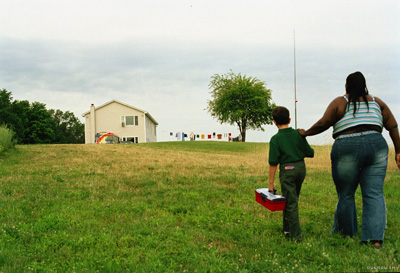
24. Palindromes (Todd Solondz, 2004, 62 points)
Todd Solondz’s films seem to be made from the head rather than the heart, but Palindromes has moments that so effectively sear themselves into your brain with their tender strangeness that you create your own emotional memories around them. Provocation and shock value aside, Palindromes conjures a fractured reflection of the innocence of a single child whose only desire is to make another child in her own image. As the name hypothesizes, this movie does turn out to be a compelling and uncanny puzzle. Is this one of the best films of the decade or just the most bizarre? In either case, it’s unforgettable and not to be missed. (Holly Herrick) ***BUY IT ON DVD ***
***
****************************************************************************************************************************************************************
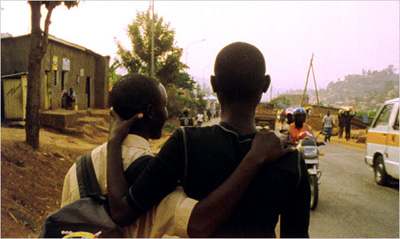
23. Munyurangabo (Lee Isaac Chung, 2007, 63 points)
Munyurangabo represents the decade’s finest example of a new type of emerging American independent cinema, one that eschews the regional and narrative conventions that have defined our movies for decades in favor of a creative and aesthetic engagement with the world beyond our national borders. In the case of the breathtaking Munyurangabo, this newfound engagement comes in the form of reconciliation with the ghosts of the Rwandan genocide, each given a voice in the native Kirwanda language. Every moment of Lee Issac Chung’s film is transformative, and as a narrative and a standard-bearer for filmmaking, Munyurangabo is the beginning of something powerful and new. (Tom Hall) ***BUY IT ON DVD ***
***
****************************************************************************************************************************************************************

20. Raising Victor Vargas (Peter Sollett, 2002, 67 points)
If some titles on this list demonstrate how independent filmmaking can push the boundaries of expression and show us things we’ve never seen before, Raising Victor Vargas offers the kinds of pleasures mainstream movies are supposed to deliver but rarely do. This small miracle of a film about teenage love on the Lower East Side is perfectly accessible, and perfectly delightful, for anyone with eyes and ears and a beating heart. Peter Sollett, co-writer Eva Vives, DP Tim Orr, and a luminous cast of novice actors get everything right, from the shimmering haze that hovers above NYC sidewalks in deep summer to the way these hard-shelled youths open themselves up to feeling like a fist slowly unclenching. (Nelson Kim) ***BUY IT ON DVD ***
***
****************************************************************************************************************************************************************
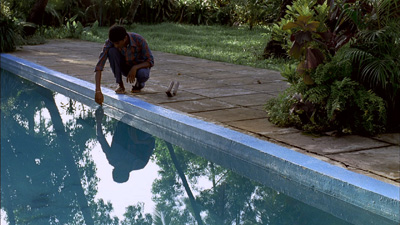
20. The Pool (Chris Smith, 2007, 67 points)
Chris Smith’s return to fiction storytelling after a decade-long sidetrack into documentary land was worth the wait and then some. Part of the magic of The Pool is that it doesn’t feel like an ethnographic exercise of an American director working in an exotic locale; it doesn’t feel like it was made by an American filmmaker, period. Though this story could have just as easily been told in small town Wisconsin, Smith’s decision to travel to India to shoot it in an unfamiliar language produces something much richer and more rewarding, a tender coming-of-age tale that will resonate with viewers no matter what language they speak. (MT) ***NOT YET AVAILABLE ON DVD***
****************************************************************************************************************************************************************

20. Funny Ha Ha (Andrew Bujalski, 2002, 67 points)
Whether or not you appreciate the films it has been lumped together with, Andrew Bujalski’s Funny Ha Ha stands on its own pigeon-toed feet as a witty, tender character study that is clearly film-history literate while remaining utterly itself. Freshman year of college, during a month of mono-mandated bed rest, I found Funny Ha Ha on the shelf at the video store and watched it three times in 24 hours, transfixed by Kate Dollenmayer’s deliciously amateur performance. I was also desperate to understand what this movie was. I rewound the ending again and again, trying to discern the film’s final marbles-in-mouth line. (Lena Dunham) ***BUY IT ON DVD ***
***
****************************************************************************************************************************************************************
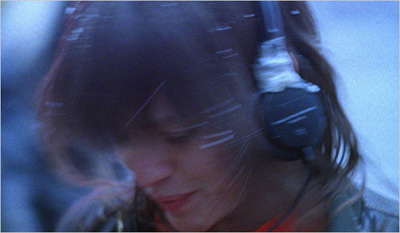
18. The Pleasure of Being Robbed (Joshua Safdie, 2008, 68 points)
I was at a film festival in Greece last month and ran into Josh Safdie. He told me about a job he recently took back home in New York, working on the crew of a corporate video, holding a boom pole all day. Many independent filmmakers are familiar with this type of temp work, and know how stultifying and creatively draining it can be—it’s dangerous, is what it is, and Josh countered it thusly: when another crew member asked him a question, he shrugged and responded in French. As far as everyone on that shoot was and is concerned, Josh Safdie is the sound guy who didn’t speak a lick of English. And that, moreso than any literal review, pretty much sums up the particular je ne sai quoi of his first feature film. (David Lowery) ***COMING SOON TO DVD ***
***
****************************************************************************************************************************************************************

18. Afterschool (Antonio Campos, 2008, 68 points)
Directed, written and edited by Antonio Campos, and gorgeously lensed and framed by Jody Lee Lipes (recipient of this year’s Silver Nail Award), this debut feature premiered at the Cannes Film Festival to great acclaim. A dark, edgy story of a young man’s voyeuristic adventures at a privileged boarding school, Afterschool provokes a complex array of sensations in the viewer. Tough-minded and polarizing, it marks the emergence of an exciting and challenging new voice in American cinema. (Pamela Cohn) ***NOT YET AVAILABLE ON DVD***
****************************************************************************************************************************************************************
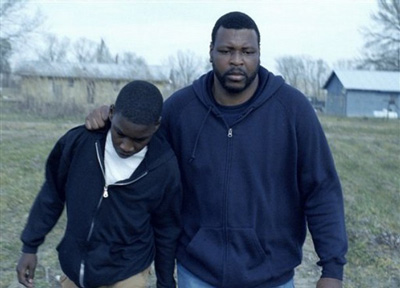
17. Ballast (Lance Hammer, 2008, 78 points)
When Lance Hammer’s debut feature premiered in competition at the 2008 Sundance Film Festival, it felt like a master had accidentally walked into a roomful of rookies. Shot on handheld 35mm using available light by cinematographer Lol Crawley, Ballast is an authentic and grittily poetic drama about one family’s grieving process during a gray, bleak Mississippi Delta winter. And while Hammer pays as much attention to the somber aura of the landscape as he does his melancholy narrative, Ballast ultimately reveals itself to be a hopeful tale of reconciliation. (MT) ***BUY IT ON DVD OR BLU-RAY
OR BLU-RAY ***
***
****************************************************************************************************************************************************************
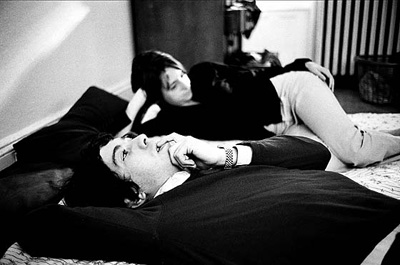
16. Mutual Appreciation (Andrew Bujalski, 2005, 79 points)
Andrew Bujalski’s follow-up to Funny Ha Ha gets funnier, warmer, and deeper every time you see it. The long mid-film back-to-back parties sequence, which has little to do with the official “plot”, first seems like a pointless digression; in fact, it reveals itself to be the heart of the film in terms of character, structure, and theme. Mutual Appreciation isn’t just a comedy about the romantic entanglements of men and women. It’s a probing examination of gender identity, self-identity, and how we define and present ourselves to the world. (Tom Russell) ***BUY IT ON DVD ***
***
****************************************************************************************************************************************************************
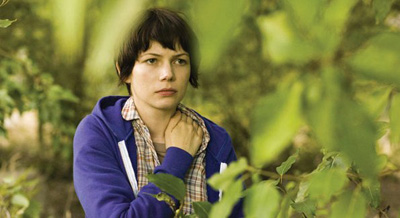
14. Wendy and Lucy (Kelly Reichardt, 2008, 81 points)
Kelly Reichardt followed up Old Joy, her lyrical Northwest bromance, with a different kind of love story: Wendy and Lucy chronicles the star-crossed connection between a boyish drifter and her sand-colored mutt. A timely meditation on the tiny injustices that conspire to send a person off the map and into poverty, Wendy and Lucy is heartbreaking in its modesty as we follow Wendy’s wordless descent. And who needs dialogue since Michelle Williams, all tattered shorts and lank, greasy bowl cut, can get the job done using only her eyes. (LD) ***BUY IT ON DVD ***
***
****************************************************************************************************************************************************************
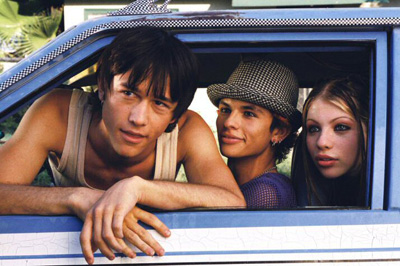
14. Mysterious Skin (Gregg Araki, 2004, 81 points)
Once in while, just when you think you’ve got a filmmaker figured out, he blows you away with a completely different turn. Who would have thought that the flip, cinematically casual director of The Doom Generation was capable of bringing actual tears to my eyes through a straightforward story of a dreamer and a fighter facing off against the cruel world? Mysterious Skin is proof that as filmmakers get older they can actually become better artists, once they live through and move on past their youthful flash. Beautiful, smart, stunning things can actually come out of a wizened middle age. (Mike S. Ryan) ***BUY IT ON DVD ***
***
****************************************************************************************************************************************************************
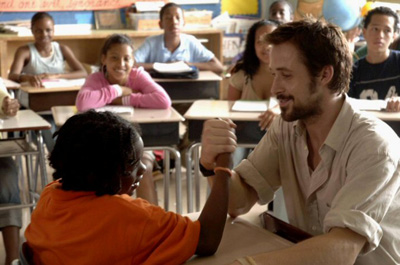
13. Half Nelson (Ryan Fleck, 2006, 82 points)
Written by the dynamic duo Ryan Fleck and Anna Boden, Half Nelson tells the story of an inner-city junior high school teacher with a bad drug habit (the superb Ryan Gosling, in an Oscar-nominated role) and the unlikely friendship that blossoms when one of his students discovers his secret (Shareeka Epps, in a real head-turning performance). As directed by Fleck and edited by Boden (who has some of the best cutting instincts around), the film achieves a thrilling level of emotional intensity. Audiences were buzzing about it after its premiere at the 2006 Sundance Film Festival, and it received the same attention when it was released theatrically in August of that same year. (PC) ***BUY IT ON DVD ***
***
****************************************************************************************************************************************************************
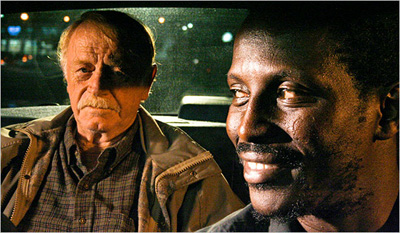
12. Goodbye Solo (Ramin Bahrani, 2008, 87 points)
After making a name for himself as a New York City filmmaker with the critically acclaimed social realist dramas Man Push Cart and Chop Shop, Ramin Bahrani returned to his small town roots for his third feature. Though the backdrop might have changed, Bahrani’s devotion to characters that have been otherwise marginalized by society did not. In Winston-Salem, North Carolina, Solo, a Senegalese cab driver, and William, a despondent Southerner, forge an unlikely bond when Solo catches on to William’s plan to take his own life. By the time Goodbye Solo reaches its quietly transcendent climax, Bahrani has shown us, with great skill and care, a profoundly humane vision of a New America. (MT) ***BUY IT ON DVD ***
***
****************************************************************************************************************************************************************
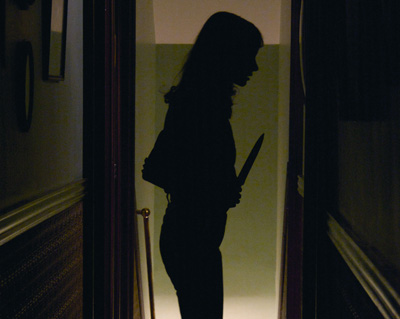
11. The House of the Devil (Ti West, 2009, 94 points)
A zoom lens is a tricky thing. It brings its subject into variable perspective, but on a different visual plane than, say, a dolly, which moves the camera through physical space. A zoom lens has nothing to do with space; rather, it’s about discernment. It allows a director to control what part of an image the audience is looking at without actually changing the intrinsic nature of that image, to tell us what to focus on in the same way our own consciousness tells our eyes what to we want to pay attention to in everyday life. In short, it’s a tool of manipulation. With The House of the Devil, so full of zoom ins and zoom outs that—along with the ’80s couture and Satan-worshipping antagonists that fill the frame—never tip the film into cheesy territory, Ti West reveals himself as a master manipulator. This is great horror filmmaking, and great filmmaking, period. (DL) ***COMING SOON TO DVD AND BLU-RAY
AND BLU-RAY ***
***
****************************************************************************************************************************************************************
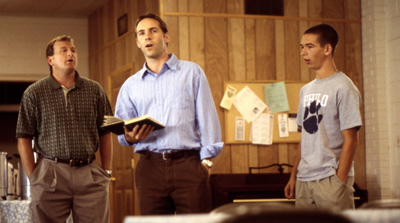
10. Junebug (Phil Morrison, 2005, 97 points)
It’s been four and a half years since I first saw Phil Morrison’s Junebug. I’ve probably watched it another ten times since then. No other film captures, in such a subtle, humorous and heartbreaking way, the central fissures of American life in the first decade of the 21st century. How to reconcile the urban with the rural, the halfheartedly Progressive with the uncompromisingly Conservative, our doubts with our faith? Is there any salve for the cultural alienation that grows between family members in vastly different social and professional spheres? How do we go home again? Junebug is a truly special film. (Note: Props to HTN contributor Mike S. Ryan for being a part of this masterpiece!) (Brandon Harris) ***BUY IT ON DVD ***
***
****************************************************************************************************************************************************************
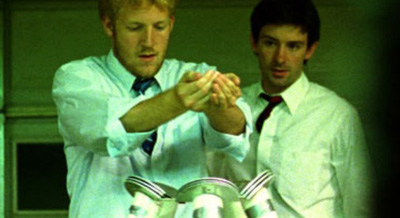
9. Primer (Shane Carruth, 2004, 99 points)
Made for the price of a good used car and with enough ingenuity to fuel ten films, Shane Carruth’s surprise Sundance winner came out of nowhere and disappeared just as fast. Not like anyone was going to figure out how to market this heady little DIY time travel movie to the masses, but in Primer we find the conceptual vision that’s missing from so many indie films made for ten and a hundred and a thousand times as much. You might need an advanced degree in Physics to wrap your head around Carruth’s narrative about the spiritual implications of metaphysical doubling, accidentally discovering how to go backwards in time in your garage, and ultimately—and most troublingly—how ethics so often get pushed aside in the name of progress. This is part of the fun. To embrace Primer’s endless complexity is to give in to its essential charm and its great gift. If you seek to be pacified and reassured, walk through another door. (BH) ***BUY IT ON DVD ***
***
****************************************************************************************************************************************************************
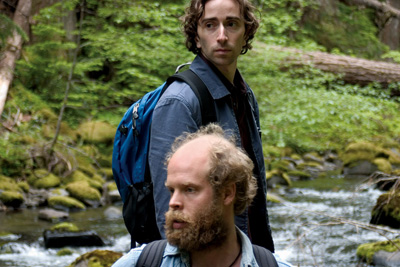
8. Old Joy (Kelly Reichardt, 2006, 104 points)
Kelly Reichardt perfected her personal craft of short story filmmaking with Old Joy, a minimalist portrait of a weekend camping trip shared by two 30-somethings in the Pacific Northwest. As the reunited friends amble through a misted wood, the constant, brooding tension between the two signals their painful realization of an imminent rupture. What ultimately makes Old Joy so complex and beautiful is what simmers beneath the surface, as each man—suffering from the political apathy of leftist America—searches in vain for the shadow of a past self who would certainly know how to connect to the other. (HH) ***BUY IT ON DVD ***
***
****************************************************************************************************************************************************************
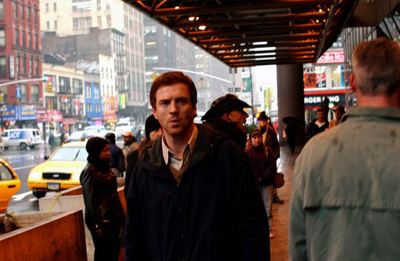
7. Keane (Lodge Kerrigan, 2004, 105 points)
A man passes through the Port Authority. A stranger, calling out, “Excuse me sir, have you seen this girl? This is my daughter…” No one seems to find the time to listen to, or even hear, the question. The crowd passes him by. Millions of eyes staring at him, voices thousands and nameless and muttering. Searching with all of them echoing within him. She will not appear. His thoughts so loud we can hear them ourselves. His family name, repeated: “My name is Keane. Keane. K – E – A – N – E…” We say it with him. Was she real? Could she still be breathing? If she was a dream, then wherever she is she must know: she may as well have never existed at all, save for him. It is no dream. (Evan Louison) ***BUY IT ON DVD ***
***
****************************************************************************************************************************************************************
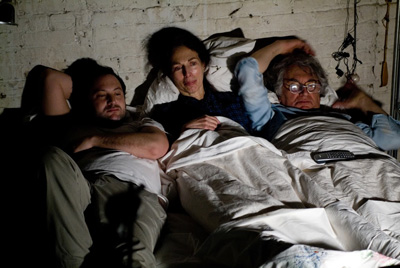
6. Momma’s Man (Azazel Jacobs, 2008, 109 points)
Just when you thought the overgrown-child-returns-home genre had officially worn out its welcome, along comes Azazel Jacobs to inject it with a breathtaking amount of heart. More than just an understated comic portrait of a new husband and father’s temporary quarter-life crisis, Momma’s Man is also a deeply touching love letter to Jacobs’ parents (painter Flo and experimental filmmaker Ken, who act in the film), their staggeringly jam-packed Tribeca loft, and a fading New York City spirit. This, my friends, is how you make the personal universal, how you turn your own little life into a work of gracious art. (MT) ***BUY IT ON DVD ***
***
****************************************************************************************************************************************************************
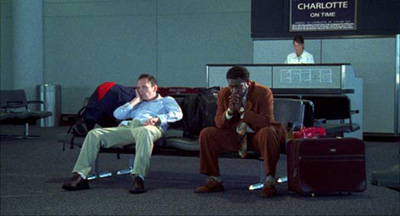
5. Great World of Sound (Craig Zobel, 2007, 115 points)
Craig Zobel’s Great World of Sound is a perceptive yet human—and often humorous—look at contemporary American culture and its exploitation of talent and hope. Pat Healy and Kene Holiday are con-artist record producers, scoping the American landscape for naïve souls looking for their big break (something all too common in the world of modern television). What makes the film so special isn’t just Healy and Holiday’s revelations or their sobering taste of reality, but those wonderful, endearing documentary clips of real people auditioning, whose talent and charm give the film a necessary dose of optimism. (Cullen Gallagher) ***BUY IT ON DVD ***
***
****************************************************************************************************************************************************************
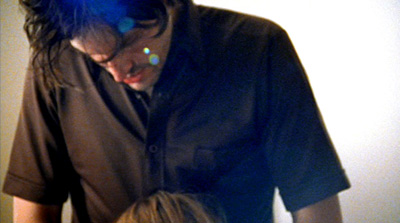
4. The Brown Bunny (Vincent Gallo, 2003, 116 points)
Miles down the road and all I need is a heaven. A place to go where I can really be. Ghosts appear like flowers from dirt. Forget all of her, leave memories behind, before they made me run. No matter how hard I try, I know if I stop for too long, I’ll remember her: Someone I lost, back there, and keep losing, over and over again. Try to keep it from happening again and again but I can’t. The windshield and the rain, the heat on the highway. Desert plain of the horizon. The road ahead of me, strangers with names the same as flowers. They remind me we all have to wilt and die like the rest of it. Trying to keep going but I’m alone. Afraid of never knowing where to stop. And it just goes on. (EL) ***BUY IT ON DVD ***
***
****************************************************************************************************************************************************************
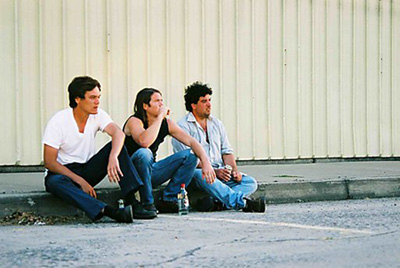
3. Shotgun Stories (Jeff Nichols, 2007, 132 points)
As a firm believer in the concept that more money doesn’t bring better films, Shotgun Stories stands as the penultimate example of how classical brilliance is attainable on a no/low budget. The writing and directing here announces a talent so immense that one can only scratch one’s head in bewilderment as to why Jeff Nichols hasn’t yet directed a studio picture. Blame it perhaps on a don’t-give-a-damn agent (CAA) or perhaps the bad advice of friends, but can someone please give this man some material—his is a talent that far surpasses his peers. (MR) ***BUY IT ON DVD ***
***
****************************************************************************************************************************************************************
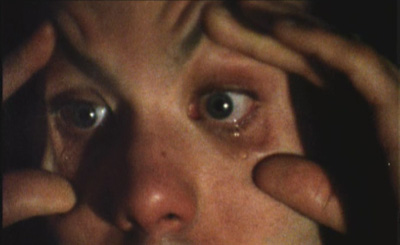
2. Frownland (Ronald Bronstein, 2007, 152 points)
Emerson defined genius as having the courage to declare that “what is true for you in your private heart is true for all men.” By that standard, Ronald Bronstein’s bleakly hilarious debut feature is manifestly a work of genius. Here is a movie for the troll lurking inside all of us, the little monster that tells us we’re ugly, doomed to failure, and undeserving of love or mercy. If we’re lucky, that inner voice takes up only a small percentage of our headspace, a small amount of the time, and quiets down as we age. Frownland cranks up the volume on that voice until it drowns out every other sound in the room. This is a challenging, often aggressively unpleasant, but strangely exhilarating viewing experience, and a triumph of DIY filmmaking. (NK) ***BUY IT ON DVD ***
***
****************************************************************************************************************************************************************
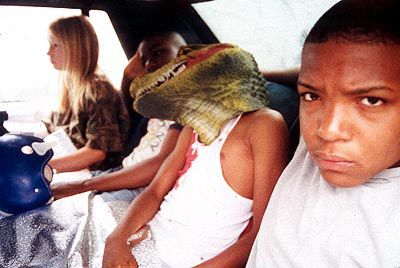
1. George Washington (David Gordon Green, 2000, 158 points)
Summer is fleeting, yet the days last forever… A reticent, rural symphony, David Gordon Green’s George Washington strikes that rare tonal balance between location, character, and story. Led by a strong ensemble cast and Tim Orr’s opulent yet naturalistic photography, the film evocatively captures the rich atmosphere of the North Carolina countryside over the course of a summer. Comparisons to Terrence Malick’s Days of Heaven (and, in turn, Nestor Almendros and Haskell Wexler’s cinematography) only reinforce the impact the film has made, and the stature it has attained, since its release in 2000. (CG) ***BUY IT ON DVD ***
***
****************************************************************************************************************************************************************
(Contributors: Pamela Cohn, Lena Dunham, Cullen Gallagher, Tom Hall, Brandon Harris, Ted Hope, Holly Herrick, Nelson Kim, Evan Louison, David Lowery, Mike S. Ryan, Michael Tully)
Which is funny when you consider the following list. As with our 2008 and 2009 Hammer to Nail Awards, we decided to separate ourselves from the pack by using a stricter guideline than most. We think this works in two ways: 1) It gives us a different purpose; and 2) It shines a valuable spotlight on work that otherwise might get lost in the shuffle. Eligible films include:
AMERICAN NARRATIVES THAT WERE PRODUCED FOR ONE MILLION DOLLARS OR LESS.
If you think 25 films seems like a large number for such a specific niche, let it be known that we could have made it a very worthwhile 50. On a subjective note, I’d like to say that, to my disappointment, a few of my own personal favorites did not make the cut. The same can be said for all of our contributors.
When it comes to those that did tally enough points, something immediately jumps out. Out of the first 24 films, only one was shot on video. While this certainly wasn’t a conscious choice, if anything, it speaks to the type of ambition that made us launch this site in the first place. That said, if we’re still doing this in 2019, I can pretty much guarantee that subsequent lists won’t be so celluloid-centric.
I won’t bore you with details of the voting process itself (if you’re interested, take a look at our 2009 Awards for an equivalent explanation). However, I do feel compelled to offer two notes of clarification to remind readers that we did our best to remove directly personal connections from the equation. Though that creates its own perhaps unfairly negative ramifications for some of these filmmakers and films, we ultimately decided that this was a more ethically sound approach to take. Here are those notes:
1. NO ONE WAS ALLOWED TO VOTE FOR A FILM IN WHICH THEY WERE CREDITED AS A CAST/CREW MEMBER.
2. TO NIP THIS POSSIBLE GRIPE IN THE BUD, AND AS AN EXAMPLE, I WOULD LIKE TO STATE THAT I, MICHAEL TULLY, DID NOT ATTRIBUTE ONE TINY POINT TO THE NUMBER 1 FILM. THIS ALSO APPLIES TO MIKE S. RYAN WITH REGARDS TO NUMBERS 8, 10, AND 24. ET CETERA.
One more quick point. In the case of ties, we opted against having any re-votes, simply assigning those films matching numbers and listing them alphabetically.
Okay, enough disclaiming. We’d like to congratulate and thank the following filmmakers for rising to the challenge, for depleting their own hearts, minds, and wallets, for defying the odds, to create such inspiring, moving works. For anyone who’s considering going to film school, I suggest a cheaper alternative: Buy these 25 films on DVD and study them closely. Many valuable lessons are contained within. — Michael Tully
HAMMER TO NAIL’S TOP 25 FILMS OF THE DECADE

25. Sita Sings the Blues (Nina Paley, 2008, 59 points)
On paper, Nina Paley’s animated spectacle sounds like a lesson in pretension, but in execution, it’s one of the more exhilarating and original motion pictures of this young century. In fusing the classic Indian myth Ramayana with the late-1920s vocal stylings of jazz singer Annette Hanshaw, Paley doesn’t just perform a creative personal exorcism of the pain inflicted upon her when her husband dumped her by email. Against all odds, Sita Sings the Blues soars as a poignant statement on the universality and timelessness of female suffering. Oh yeah, it also happens to be laugh-out-loud funny and an all around giddy delight. (MT) ***BUY IT ON DVD
****************************************************************************************************************************************************************

24. Palindromes (Todd Solondz, 2004, 62 points)
Todd Solondz’s films seem to be made from the head rather than the heart, but Palindromes has moments that so effectively sear themselves into your brain with their tender strangeness that you create your own emotional memories around them. Provocation and shock value aside, Palindromes conjures a fractured reflection of the innocence of a single child whose only desire is to make another child in her own image. As the name hypothesizes, this movie does turn out to be a compelling and uncanny puzzle. Is this one of the best films of the decade or just the most bizarre? In either case, it’s unforgettable and not to be missed. (Holly Herrick) ***BUY IT ON DVD
****************************************************************************************************************************************************************

23. Munyurangabo (Lee Isaac Chung, 2007, 63 points)
Munyurangabo represents the decade’s finest example of a new type of emerging American independent cinema, one that eschews the regional and narrative conventions that have defined our movies for decades in favor of a creative and aesthetic engagement with the world beyond our national borders. In the case of the breathtaking Munyurangabo, this newfound engagement comes in the form of reconciliation with the ghosts of the Rwandan genocide, each given a voice in the native Kirwanda language. Every moment of Lee Issac Chung’s film is transformative, and as a narrative and a standard-bearer for filmmaking, Munyurangabo is the beginning of something powerful and new. (Tom Hall) ***BUY IT ON DVD
****************************************************************************************************************************************************************

20. Raising Victor Vargas (Peter Sollett, 2002, 67 points)
If some titles on this list demonstrate how independent filmmaking can push the boundaries of expression and show us things we’ve never seen before, Raising Victor Vargas offers the kinds of pleasures mainstream movies are supposed to deliver but rarely do. This small miracle of a film about teenage love on the Lower East Side is perfectly accessible, and perfectly delightful, for anyone with eyes and ears and a beating heart. Peter Sollett, co-writer Eva Vives, DP Tim Orr, and a luminous cast of novice actors get everything right, from the shimmering haze that hovers above NYC sidewalks in deep summer to the way these hard-shelled youths open themselves up to feeling like a fist slowly unclenching. (Nelson Kim) ***BUY IT ON DVD
****************************************************************************************************************************************************************

20. The Pool (Chris Smith, 2007, 67 points)
Chris Smith’s return to fiction storytelling after a decade-long sidetrack into documentary land was worth the wait and then some. Part of the magic of The Pool is that it doesn’t feel like an ethnographic exercise of an American director working in an exotic locale; it doesn’t feel like it was made by an American filmmaker, period. Though this story could have just as easily been told in small town Wisconsin, Smith’s decision to travel to India to shoot it in an unfamiliar language produces something much richer and more rewarding, a tender coming-of-age tale that will resonate with viewers no matter what language they speak. (MT) ***NOT YET AVAILABLE ON DVD***
****************************************************************************************************************************************************************

20. Funny Ha Ha (Andrew Bujalski, 2002, 67 points)
Whether or not you appreciate the films it has been lumped together with, Andrew Bujalski’s Funny Ha Ha stands on its own pigeon-toed feet as a witty, tender character study that is clearly film-history literate while remaining utterly itself. Freshman year of college, during a month of mono-mandated bed rest, I found Funny Ha Ha on the shelf at the video store and watched it three times in 24 hours, transfixed by Kate Dollenmayer’s deliciously amateur performance. I was also desperate to understand what this movie was. I rewound the ending again and again, trying to discern the film’s final marbles-in-mouth line. (Lena Dunham) ***BUY IT ON DVD
****************************************************************************************************************************************************************

18. The Pleasure of Being Robbed (Joshua Safdie, 2008, 68 points)
I was at a film festival in Greece last month and ran into Josh Safdie. He told me about a job he recently took back home in New York, working on the crew of a corporate video, holding a boom pole all day. Many independent filmmakers are familiar with this type of temp work, and know how stultifying and creatively draining it can be—it’s dangerous, is what it is, and Josh countered it thusly: when another crew member asked him a question, he shrugged and responded in French. As far as everyone on that shoot was and is concerned, Josh Safdie is the sound guy who didn’t speak a lick of English. And that, moreso than any literal review, pretty much sums up the particular je ne sai quoi of his first feature film. (David Lowery) ***COMING SOON TO DVD
****************************************************************************************************************************************************************

18. Afterschool (Antonio Campos, 2008, 68 points)
Directed, written and edited by Antonio Campos, and gorgeously lensed and framed by Jody Lee Lipes (recipient of this year’s Silver Nail Award), this debut feature premiered at the Cannes Film Festival to great acclaim. A dark, edgy story of a young man’s voyeuristic adventures at a privileged boarding school, Afterschool provokes a complex array of sensations in the viewer. Tough-minded and polarizing, it marks the emergence of an exciting and challenging new voice in American cinema. (Pamela Cohn) ***NOT YET AVAILABLE ON DVD***
****************************************************************************************************************************************************************

17. Ballast (Lance Hammer, 2008, 78 points)
When Lance Hammer’s debut feature premiered in competition at the 2008 Sundance Film Festival, it felt like a master had accidentally walked into a roomful of rookies. Shot on handheld 35mm using available light by cinematographer Lol Crawley, Ballast is an authentic and grittily poetic drama about one family’s grieving process during a gray, bleak Mississippi Delta winter. And while Hammer pays as much attention to the somber aura of the landscape as he does his melancholy narrative, Ballast ultimately reveals itself to be a hopeful tale of reconciliation. (MT) ***BUY IT ON DVD
****************************************************************************************************************************************************************

16. Mutual Appreciation (Andrew Bujalski, 2005, 79 points)
Andrew Bujalski’s follow-up to Funny Ha Ha gets funnier, warmer, and deeper every time you see it. The long mid-film back-to-back parties sequence, which has little to do with the official “plot”, first seems like a pointless digression; in fact, it reveals itself to be the heart of the film in terms of character, structure, and theme. Mutual Appreciation isn’t just a comedy about the romantic entanglements of men and women. It’s a probing examination of gender identity, self-identity, and how we define and present ourselves to the world. (Tom Russell) ***BUY IT ON DVD
****************************************************************************************************************************************************************

14. Wendy and Lucy (Kelly Reichardt, 2008, 81 points)
Kelly Reichardt followed up Old Joy, her lyrical Northwest bromance, with a different kind of love story: Wendy and Lucy chronicles the star-crossed connection between a boyish drifter and her sand-colored mutt. A timely meditation on the tiny injustices that conspire to send a person off the map and into poverty, Wendy and Lucy is heartbreaking in its modesty as we follow Wendy’s wordless descent. And who needs dialogue since Michelle Williams, all tattered shorts and lank, greasy bowl cut, can get the job done using only her eyes. (LD) ***BUY IT ON DVD
****************************************************************************************************************************************************************

14. Mysterious Skin (Gregg Araki, 2004, 81 points)
Once in while, just when you think you’ve got a filmmaker figured out, he blows you away with a completely different turn. Who would have thought that the flip, cinematically casual director of The Doom Generation was capable of bringing actual tears to my eyes through a straightforward story of a dreamer and a fighter facing off against the cruel world? Mysterious Skin is proof that as filmmakers get older they can actually become better artists, once they live through and move on past their youthful flash. Beautiful, smart, stunning things can actually come out of a wizened middle age. (Mike S. Ryan) ***BUY IT ON DVD
****************************************************************************************************************************************************************

13. Half Nelson (Ryan Fleck, 2006, 82 points)
Written by the dynamic duo Ryan Fleck and Anna Boden, Half Nelson tells the story of an inner-city junior high school teacher with a bad drug habit (the superb Ryan Gosling, in an Oscar-nominated role) and the unlikely friendship that blossoms when one of his students discovers his secret (Shareeka Epps, in a real head-turning performance). As directed by Fleck and edited by Boden (who has some of the best cutting instincts around), the film achieves a thrilling level of emotional intensity. Audiences were buzzing about it after its premiere at the 2006 Sundance Film Festival, and it received the same attention when it was released theatrically in August of that same year. (PC) ***BUY IT ON DVD
****************************************************************************************************************************************************************

12. Goodbye Solo (Ramin Bahrani, 2008, 87 points)
After making a name for himself as a New York City filmmaker with the critically acclaimed social realist dramas Man Push Cart and Chop Shop, Ramin Bahrani returned to his small town roots for his third feature. Though the backdrop might have changed, Bahrani’s devotion to characters that have been otherwise marginalized by society did not. In Winston-Salem, North Carolina, Solo, a Senegalese cab driver, and William, a despondent Southerner, forge an unlikely bond when Solo catches on to William’s plan to take his own life. By the time Goodbye Solo reaches its quietly transcendent climax, Bahrani has shown us, with great skill and care, a profoundly humane vision of a New America. (MT) ***BUY IT ON DVD
****************************************************************************************************************************************************************

11. The House of the Devil (Ti West, 2009, 94 points)
A zoom lens is a tricky thing. It brings its subject into variable perspective, but on a different visual plane than, say, a dolly, which moves the camera through physical space. A zoom lens has nothing to do with space; rather, it’s about discernment. It allows a director to control what part of an image the audience is looking at without actually changing the intrinsic nature of that image, to tell us what to focus on in the same way our own consciousness tells our eyes what to we want to pay attention to in everyday life. In short, it’s a tool of manipulation. With The House of the Devil, so full of zoom ins and zoom outs that—along with the ’80s couture and Satan-worshipping antagonists that fill the frame—never tip the film into cheesy territory, Ti West reveals himself as a master manipulator. This is great horror filmmaking, and great filmmaking, period. (DL) ***COMING SOON TO DVD
****************************************************************************************************************************************************************

10. Junebug (Phil Morrison, 2005, 97 points)
It’s been four and a half years since I first saw Phil Morrison’s Junebug. I’ve probably watched it another ten times since then. No other film captures, in such a subtle, humorous and heartbreaking way, the central fissures of American life in the first decade of the 21st century. How to reconcile the urban with the rural, the halfheartedly Progressive with the uncompromisingly Conservative, our doubts with our faith? Is there any salve for the cultural alienation that grows between family members in vastly different social and professional spheres? How do we go home again? Junebug is a truly special film. (Note: Props to HTN contributor Mike S. Ryan for being a part of this masterpiece!) (Brandon Harris) ***BUY IT ON DVD
****************************************************************************************************************************************************************

9. Primer (Shane Carruth, 2004, 99 points)
Made for the price of a good used car and with enough ingenuity to fuel ten films, Shane Carruth’s surprise Sundance winner came out of nowhere and disappeared just as fast. Not like anyone was going to figure out how to market this heady little DIY time travel movie to the masses, but in Primer we find the conceptual vision that’s missing from so many indie films made for ten and a hundred and a thousand times as much. You might need an advanced degree in Physics to wrap your head around Carruth’s narrative about the spiritual implications of metaphysical doubling, accidentally discovering how to go backwards in time in your garage, and ultimately—and most troublingly—how ethics so often get pushed aside in the name of progress. This is part of the fun. To embrace Primer’s endless complexity is to give in to its essential charm and its great gift. If you seek to be pacified and reassured, walk through another door. (BH) ***BUY IT ON DVD
****************************************************************************************************************************************************************

8. Old Joy (Kelly Reichardt, 2006, 104 points)
Kelly Reichardt perfected her personal craft of short story filmmaking with Old Joy, a minimalist portrait of a weekend camping trip shared by two 30-somethings in the Pacific Northwest. As the reunited friends amble through a misted wood, the constant, brooding tension between the two signals their painful realization of an imminent rupture. What ultimately makes Old Joy so complex and beautiful is what simmers beneath the surface, as each man—suffering from the political apathy of leftist America—searches in vain for the shadow of a past self who would certainly know how to connect to the other. (HH) ***BUY IT ON DVD
****************************************************************************************************************************************************************

7. Keane (Lodge Kerrigan, 2004, 105 points)
A man passes through the Port Authority. A stranger, calling out, “Excuse me sir, have you seen this girl? This is my daughter…” No one seems to find the time to listen to, or even hear, the question. The crowd passes him by. Millions of eyes staring at him, voices thousands and nameless and muttering. Searching with all of them echoing within him. She will not appear. His thoughts so loud we can hear them ourselves. His family name, repeated: “My name is Keane. Keane. K – E – A – N – E…” We say it with him. Was she real? Could she still be breathing? If she was a dream, then wherever she is she must know: she may as well have never existed at all, save for him. It is no dream. (Evan Louison) ***BUY IT ON DVD
****************************************************************************************************************************************************************

6. Momma’s Man (Azazel Jacobs, 2008, 109 points)
Just when you thought the overgrown-child-returns-home genre had officially worn out its welcome, along comes Azazel Jacobs to inject it with a breathtaking amount of heart. More than just an understated comic portrait of a new husband and father’s temporary quarter-life crisis, Momma’s Man is also a deeply touching love letter to Jacobs’ parents (painter Flo and experimental filmmaker Ken, who act in the film), their staggeringly jam-packed Tribeca loft, and a fading New York City spirit. This, my friends, is how you make the personal universal, how you turn your own little life into a work of gracious art. (MT) ***BUY IT ON DVD
****************************************************************************************************************************************************************

5. Great World of Sound (Craig Zobel, 2007, 115 points)
Craig Zobel’s Great World of Sound is a perceptive yet human—and often humorous—look at contemporary American culture and its exploitation of talent and hope. Pat Healy and Kene Holiday are con-artist record producers, scoping the American landscape for naïve souls looking for their big break (something all too common in the world of modern television). What makes the film so special isn’t just Healy and Holiday’s revelations or their sobering taste of reality, but those wonderful, endearing documentary clips of real people auditioning, whose talent and charm give the film a necessary dose of optimism. (Cullen Gallagher) ***BUY IT ON DVD
****************************************************************************************************************************************************************

4. The Brown Bunny (Vincent Gallo, 2003, 116 points)
Miles down the road and all I need is a heaven. A place to go where I can really be. Ghosts appear like flowers from dirt. Forget all of her, leave memories behind, before they made me run. No matter how hard I try, I know if I stop for too long, I’ll remember her: Someone I lost, back there, and keep losing, over and over again. Try to keep it from happening again and again but I can’t. The windshield and the rain, the heat on the highway. Desert plain of the horizon. The road ahead of me, strangers with names the same as flowers. They remind me we all have to wilt and die like the rest of it. Trying to keep going but I’m alone. Afraid of never knowing where to stop. And it just goes on. (EL) ***BUY IT ON DVD
****************************************************************************************************************************************************************

3. Shotgun Stories (Jeff Nichols, 2007, 132 points)
As a firm believer in the concept that more money doesn’t bring better films, Shotgun Stories stands as the penultimate example of how classical brilliance is attainable on a no/low budget. The writing and directing here announces a talent so immense that one can only scratch one’s head in bewilderment as to why Jeff Nichols hasn’t yet directed a studio picture. Blame it perhaps on a don’t-give-a-damn agent (CAA) or perhaps the bad advice of friends, but can someone please give this man some material—his is a talent that far surpasses his peers. (MR) ***BUY IT ON DVD
****************************************************************************************************************************************************************

2. Frownland (Ronald Bronstein, 2007, 152 points)
Emerson defined genius as having the courage to declare that “what is true for you in your private heart is true for all men.” By that standard, Ronald Bronstein’s bleakly hilarious debut feature is manifestly a work of genius. Here is a movie for the troll lurking inside all of us, the little monster that tells us we’re ugly, doomed to failure, and undeserving of love or mercy. If we’re lucky, that inner voice takes up only a small percentage of our headspace, a small amount of the time, and quiets down as we age. Frownland cranks up the volume on that voice until it drowns out every other sound in the room. This is a challenging, often aggressively unpleasant, but strangely exhilarating viewing experience, and a triumph of DIY filmmaking. (NK) ***BUY IT ON DVD
****************************************************************************************************************************************************************

1. George Washington (David Gordon Green, 2000, 158 points)
Summer is fleeting, yet the days last forever… A reticent, rural symphony, David Gordon Green’s George Washington strikes that rare tonal balance between location, character, and story. Led by a strong ensemble cast and Tim Orr’s opulent yet naturalistic photography, the film evocatively captures the rich atmosphere of the North Carolina countryside over the course of a summer. Comparisons to Terrence Malick’s Days of Heaven (and, in turn, Nestor Almendros and Haskell Wexler’s cinematography) only reinforce the impact the film has made, and the stature it has attained, since its release in 2000. (CG) ***BUY IT ON DVD
****************************************************************************************************************************************************************
(Contributors: Pamela Cohn, Lena Dunham, Cullen Gallagher, Tom Hall, Brandon Harris, Ted Hope, Holly Herrick, Nelson Kim, Evan Louison, David Lowery, Mike S. Ryan, Michael Tully)
THE 2009 HAMMER TO NAIL AWARDS
If you revisit the 2008 Hammer to Nail Awards post, you might see some overlap with a few of this year’s titles. I take full responsibility for that, as I was still trying to figure out the best plan of attack for this complicated endeavor. Now that we’ve been through the rigamarole once, we have come to settle on the following overriding guideline: A FILM IS ELIGIBLE IF IT RECEIVED SOME FORM OF PUBLIC RELEASE, WHETHER IT BE THEATRICAL, VOD, OR STRAIGHT-TO-DVD, IN SAID CALENDAR YEAR. Last year, we were counting festival premieres, which is unfair to filmmakers, as many of our contributors hadn’t been able to catch up with that work until it received an even somewhat legitimate release. This is the main reason for taking this approach, which can seem less timely but, in the grander scheme, makes the most overall sense. We are confident that all of these films—especially the cream of the crop—will eventually find a public release (see last year’s Prince of Broadway, which won’t technically become eligible until next year!—or this year’s Number 3, which we were worried might never see the light of day).
As for the voting process, that has remained the same. Each main HTN contributor (see bottom of post for this year’s voters) was asked to submit their Top 10 Films of 2009. Ten points were assigned to each number one, nine points were assigned to the number two, and on down the line. These results were tallied into the list you see below. In the case of ties, the film that appeared on the most ballots received the edge.
One final note: NO ONE WAS ALLOWED TO VOTE FOR A FILM IN WHICH THEY RECEIVED A CREW CREDIT.
Thanks so much for reading and supporting our mission at Hammer to Nail. Times are tight, but we’re determined to keep moving forward and carefully curating your viewing experience, whether it be in a theater, on television, on your computer, or on something even smaller than that. And now, onto the main event…
THE GOLDEN HAMMER AWARD:
The indie film industry has imploded, due to reduced demand, the decline of DVD sales, the folding of theatrical distributors, and the drying up of funding sources caused by the economic crash. The industry as we once knew it has in effect vanished. However, that statement is applicable only toward your own take on the term. If your definition of ‘indie film’ starts with Sex, Lies, and Videotape, Spike Lee and Kevin Smith, then yes, that industry has died. The sale of Steven Soderbergh’s 1989 breakout hit inspired the major studios to create “indie sub-companies,” some of which were distributors and some of which were content developers. Over the years, between Sex, Lies and Hamlet 2 (the last eight-figure Sundance deal), the indie industry grew to embody not maverick ideas and techniques but instead tepid warmed over sub-par industry drivel. Fueled by the box office success of films like Napoleon Dynamite and Little Miss Sunshine, the American indie film movement ossified into the indie-quirk-pseudo-grunge-alt-maverick business defined by such recent films as Sunshine Cleaning and Arlen Faber (aka The Answer Man). As we step toward the first Sundance without Geoff Gilmore all I can say is:
THE AMERICAN INDIE FILM INDUSTRY IS DEAD… HALLELUJAH!
 While
all that hullabaloo was going on over at Sundance, while people made
more and more money and the films got blander and more ‘commercial,’
there was a toothless NYC curmudgeon toiling in the shadows of the East
Village. Amazing feature after feature, like Habit and Wendigo,
blew my mind with their classical yet aggressively pointed spins on the
horror genre. It was clear to me, and most everyone who saw the work of
Larry Fessenden, that there was a fully accomplished
voice working within the genre, saying something significant about what
it means to be alive today.
While
all that hullabaloo was going on over at Sundance, while people made
more and more money and the films got blander and more ‘commercial,’
there was a toothless NYC curmudgeon toiling in the shadows of the East
Village. Amazing feature after feature, like Habit and Wendigo,
blew my mind with their classical yet aggressively pointed spins on the
horror genre. It was clear to me, and most everyone who saw the work of
Larry Fessenden, that there was a fully accomplished
voice working within the genre, saying something significant about what
it means to be alive today.It was always clear to me that though Larry works in the horror genre, his voice is as authentic and as passionate as the first pioneers of true indie cinema, people like Oscar Micheaux, John Cassavetes and Kenneth Anger. The fact that these earlier films of his never played in the Midnight section at Sundance is criminal. Late night after late night I sat in the Egyptian theater watching some bland Tarantino wannabe or some slick piece of crap like Donkey Punch wondering, “Why isn’t Larry Fessenden here?”
Well, that period of indie film, marked by those go-go Sundance years, is gone. I say good riddance. I hope some of the ’stars’ of that period have returned to selling real estate, because it was their drive to make money that sidetracked the authentic indie film spirit. I’m glad their game has gone bust. In its wake will rise true independent visions, films made by people who have something to say, and all the soulless LA sub-companies of the Hollywood industrial entertainment mind-melt industry can go to blazes as they watch the future rise out of the gutter. It’s great that the ‘industry’ is dead because maybe now the crap that these companies forced onto the small screens will go away and true indie film companies like GLASS EYE PIX will rise to the foreground.
 In the past few years GLASS EYE PIX—and now Fessenden’s low-budget horror banner SCAREFLIX—has
been responsible for some of this past decade’s best work, from the
films of Kelly Reichardt (that was Larry acting in her first film River of Grass as well as her most recent Wendy and Lucy) to the Ti West mindbenders The Roost and The House of the Devil, to Larry’s own The Last Winter.
This year alone has seen an amazing batch of new releases, including
Graham Reznick’s startling one-two punch of the camping trip-gone-awry
feature I Can See You and the amazing hand-made true 3D short The Viewer.
In the past few years GLASS EYE PIX—and now Fessenden’s low-budget horror banner SCAREFLIX—has
been responsible for some of this past decade’s best work, from the
films of Kelly Reichardt (that was Larry acting in her first film River of Grass as well as her most recent Wendy and Lucy) to the Ti West mindbenders The Roost and The House of the Devil, to Larry’s own The Last Winter.
This year alone has seen an amazing batch of new releases, including
Graham Reznick’s startling one-two punch of the camping trip-gone-awry
feature I Can See You and the amazing hand-made true 3D short The Viewer.My favorite 2009 effort from the GLASS EYE PIX stable, however, is Glenn McQuaid’s I Sell The Dead, a film savvy journey through horror history that gleefully combines a graveyard robbing Hammer film from the mid-1960s with a brash high contrast classic lurid Zombie movie of the ‘80s. Wrapped up in dark humor and creepy shocks, I Sell the Dead has it all. But Larry and his collaborators do more than just make excellent films on micro-budgets. They hype the heck out of them, with great viral and old-fashioned three-dimensional merchandising tactics (playing cards, comic books, posters, etc.).
A company like GLASS EYE PIX—and, in turn, SCAREFLIX—is the future of indie cinema, a small, individually run force, driven by passion and an aesthetic vision that can embrace both pure character driven pieces like Wendy and Lucy, as well as informed, intelligent genre films such as The House of the Devil and I Sell The Dead. Mark my words, this is a company that will eventually have a Paranormal Activity-level breakout hit. In the meantime, keep track of their releases and get stunned, rocked, shocked, and transported. Welcome to the new world, where GLASS EYE PIX is the model. For all of these reasons, for being such an inspiring force in the industry, we give Larry Fessenden the 2009 GOLDEN HAMMER AWARD. He’s the past, present, and future combined. He is American Independent Cinema. — Mike S. Ryan
THE SILVER NAIL AWARD:
Every so often, a vision emerges from directly behind the camera that feels as important as—or more important than—the person who’s sitting in the director’s chair. From the very first frame of Antonio Campos’ Afterschool, it’s immediately clear that whoever is shooting this picture is good. And as the film goes on, it’s hard to suppress the feeling that one is watching a master cinematographer at work. Months before experiencing Afterschool on the big screen at the New York Film Festival in the fall of 2008, I had a strangely similar reaction to a film that couldn’t have been more different. As I watched Matt Wolf’s Wild Combination: A Portrait of Arthur Russell at the 2008 Sarasota Film Festival, I found myself awed by the imagery. And not just the beautifully grainy recreations that were shot on film. Something about the video interviews had a warmth and tenderness that felt much more cinematic than I was used to seeing in this type of project. Without question, in this instance the cinematography had made a good movie great.
 It turns out the same person was responsible for the imagery in both of these films. His name: Jody Lee Lipes.
Though not yet thirty, and with only these two features under his belt
(though much more work was being done along the way: videos,
commercials, shorts, etc.), Lipes exhibited a technical range,
intelligence, and care that reached far beyond his years. This year,
with the premiere of his own documentary, Brock Enright: Good Times Will Never Be The Same, at the 2009 South by Southwest Film Festival, Lipes confirmed what I suspected: he’s a great director too.
It turns out the same person was responsible for the imagery in both of these films. His name: Jody Lee Lipes.
Though not yet thirty, and with only these two features under his belt
(though much more work was being done along the way: videos,
commercials, shorts, etc.), Lipes exhibited a technical range,
intelligence, and care that reached far beyond his years. This year,
with the premiere of his own documentary, Brock Enright: Good Times Will Never Be The Same, at the 2009 South by Southwest Film Festival, Lipes confirmed what I suspected: he’s a great director too.Like Afterschool, Brock Enright has elicited fiercely passionate reactions from both yaysayers and naysayers. But in my experience, what people “hate” about Brock Enright has nothing to do with the point Lipes is actually making. As in, he didn’t set out to make a “point.” A bracingly intimate portrait of controversial New York City artist Brock Enright as he travels out west with his girlfriend Kirsten Deirup to work on a new gallery commission on her parents’ land in the Upstate California woods, BE:GTWNBTS feels downright revolutionary. Whereas most no-budget filmmakers are running around trying to make their lazily unscripted narrative features feel like sloppy documentaries, Lipes filmed his real situations to look and feel like a European art film. The effect is mesmerizing.
 As
his deadline approaches and Deirup continues to grill him about their
mounting bills back in Brooklyn, Enright begins to succumb to the
pressure. And when the director of the Perry Rubenstein Gallery visits
the compound to check up on Brock, the situation spins all the way out
of control. The unsettling nature of the content, mixed with Lipes’
innovative approach to shooting his material, is undoubtedly the reason
for so much viewer discomfort (i.e., discomfort = dissatisfaction). But
for someone who yearns to see a universal story—the mounting pressures
of a twenty-something couple—told in such a fresh way, there is no
discomfort. There is only exhilaration. Though BE:GTWNBTS
has not yet been picked up for distribution, that will happen. But more
importantly, Lipes continues to work both behind the camera and from
the director’s chair. In some cases, as with the upcoming NY Export: Opus Jazz, he’s doing both.
As
his deadline approaches and Deirup continues to grill him about their
mounting bills back in Brooklyn, Enright begins to succumb to the
pressure. And when the director of the Perry Rubenstein Gallery visits
the compound to check up on Brock, the situation spins all the way out
of control. The unsettling nature of the content, mixed with Lipes’
innovative approach to shooting his material, is undoubtedly the reason
for so much viewer discomfort (i.e., discomfort = dissatisfaction). But
for someone who yearns to see a universal story—the mounting pressures
of a twenty-something couple—told in such a fresh way, there is no
discomfort. There is only exhilaration. Though BE:GTWNBTS
has not yet been picked up for distribution, that will happen. But more
importantly, Lipes continues to work both behind the camera and from
the director’s chair. In some cases, as with the upcoming NY Export: Opus Jazz, he’s doing both.For his creativity, startling execution, and daring work on Brock Enright: Good Times Will Never Be The Same and Afterschool (which finally made its way into theaters in 2009), for truly straddling the line between fiction and nonfiction, erasing those boundaries in a way that should have both camps rejoicing—especially you documentary advocates, wake up, people!—Jody Lee Lipes earns our 2009 SILVER NAIL AWARD. — Michael Tully
THE BEST FILM OF 2009:

Goodbye Solo (Ramin Bahrani) — Who needs a big budget when you’ve got great storytelling? Though his first two features, Man Push Cart and Chop Shop, established Ramin Bahrani as a talented new American filmmaker in the tradition of the Neo-Realist masters of yore, with Goodbye Solo, he officially joined their ranks. Set in Bahrani’s hometown of Winston-Salem, North Carolina, the film tells the tale of two figures whose paths cross incidentally when a Senegalese cab driver, Solo (Souleymayne Sy Savane), receives a strange proposition from a fare, William (Red West). Solo understands what this proposition really means, yet rather than simply ignoring the signs as would be expected in these increasingly selfish, hurried times and letting William drift away, he latches on to this bitter man and won’t let go. As portrayed by Savane, Solo has a tireless spirit that can’t be extinguished. Yet as the film builds to its quietly transcendent climax, he learns that some people’s pain is simply too much to bear. For saying so much with so little, for being simultaneously sobering and uplifting, for capturing the true multi-cultural spirit of 21st century America, and, most importantly, for receiving the most votes, Goodbye Solo is our Best Film of 2009. — MT
(Click on the titles below to read their official HTN reviews, and click on the names to read our HTN conversations with these extremely talented directors.)
THE TOP 13 FILMS OF 2009:
1. Goodbye Solo (Ramin Bahrani)
2. The House of the Devil (Ti West)
3. Munyurangabo (Lee Isaac Chung)
4. Medicine for Melancholy (Barry Jenkins)
4. Treeless Mountain (So Yong Kim)
6. Humpday (Lynn Shelton)
7. That Evening Sun (Scott Teems)
8. Sita Sings the Blues (Nina Paley)
8. Severed Ways: The Norse Discovery of America (Tony Stone)
10. Afterschool (Antonio Campos)
11. Children of Invention (Tze Chun)
12. Stingray Sam (Cory McAbee)
13. Weapons (Adam Bhala Lough)
Other Films Receiving Votes (in alphabetical order):
Beeswax (Andrew Bujalski)
Big Fan (Robert Siegel)
Christmas on Mars (Wayne Coyne)
Confessionsofa Ex-Doofus-ItchyFooted Mutha (Melvin Van Peebles)
Everything Strange and New (Frazer Bradshaw)
Half-Life (Jennifer Phang)
Harmony and Me (Bob Byington)
I Sell the Dead (Glenn McQuaid)
It Is Fine. Everything Is Fine! (Crispin Glover)
Loren Cass (Chris Fuller)
The New Year Parade (Tom Quinn)
Paper Covers Rock (Joe Maggio)
The Princess of Nebraska (Wayne Wang)
The Toe Tactic (Emily Hubley)
White on Rice (Dave Boyle)
(Contributors: Pamela Cohn, Cullen Gallagher, Tom Hall, Brandon Harris, Ted Hope, Holly Herrick, Nelson Kim, Michael Lerman, Evan Louison, David Lowery, Mike S. Ryan, Michael Tully)
THE 2008 HAMMER TO NAIL AWARDS
In order to get the fairest and most comprehensive result possible, we asked H2N’s current roster of expert contributors to submit their own top ten lists that fit within the following parameters: American narratives (shorts or features) made for under one million dollars that either premiered or received some form of a theatrical release in 2008. These results were weighed, measured, and combined to produce a democratic final tally.
This process can get complicated. What about those titles that premiered towards the end of the year and have had minimal screenings up to this point (such as So Yong Kim’s Treeless Mountain or Ramin Bahrani’s Goodbye Solo)? Or what about those 2007 premieres that weren’t seen by many and never found distribution in 2008 (such as Lee Isaac Chung’s criminally overlooked Munyurangabo)? After much deliberation, we have removed films such as these from contention. Our hope is that, moving forward in the years to come, no more gems will slip through the cracks.
Looking over the final list, it is screamingly clear that outside-the-system, low-budget American independent cinema isn’t just alive and well; it’s thriving. While it’s too early to determine, we feel strongly that 2008 has been a banner year and will stand the test of time. But what makes the situation even more unique is that these films have emerged just when the distribution landscape is rapidly shrinking. Though the movies are better than ever, it is incredibly difficult to get them shown. Imagine what it would be like if there were real opportunities for these films to be seen by wider audiences. That’s why we started this site, and that’s why we’re handing out these awards. We applaud the following filmmakers for inspiring us, and we hope they receive the attention and acclaim they so rightly deserve. And now, without further ado…
THE GOLDEN HAMMER AWARD
Lance Hammer — The 2008 Sundance Film Festival began with a whimper. There was much grumbling in that opening weekend as press screening after press screening unveiled work that varied from mediocre to worse. And then came Ballast, which felt like a master songwriter stepping on stage at the end of a particularly amateurish open mic night. Lance Hammer’s directorial debut didn’t feel like a debut at all. It had a command of tone that most experienced directors only dream of achieving. With grace and intelligence—and gorgeous natural light 35mm cinematography—Hammer found the poetic tenderness inside a cold, harsh, somber Mississippi Delta landscape. Ballast took home two awards at the festival—Dramatic Directing and Excellence in Cinematography—and distributors came calling. Yet after a flirtation with IFC Films, Hammer decided to retain the film’s rights and forge his own distribution path. It is for both of these reasons—making an extraordinary film the old-fashioned way yet distributing it the new-fashioned way—that Lance Hammer is the recipient of our first ever Golden Hammer Award.
THE SILVER NAIL AWARD
Sean Baker — We wanted to give an award to the filmmaker who did the most with the least. Sean Baker shattered that concept by delivering two films for the price of barely-even-one. Though Take Out (co-directed with Shih-Ching Tsou) debuted in 2004, it didn’t receive a proper theatrical release until this year (reviews were unanimously positive). Shortly after that, Baker world-premiered his next feature, Prince of Broadway, at the Los Angeles Film Festival, where it won the coveted Target Filmmaker Award. Separately, these films are micro-budget digital cinema of the highest order, yet when placed next to one another, they become something much more important. This isn’t just the work of an on-the-margins filmmaker with a video camera. It’s the work of one of America’s most vital social realists transcending his limitations to present worlds that pulse with documentary-like realism and throb with humanity. And so, for proving that budget doesn’t matter in delivering the finest one-two punch of 2008, we present Sean Baker with our Silver Nail Award.
THE BEST FILM OF 2008
Frownland (Ronald Bronstein) — For most of us, the Frownland revelation came in 2007, either at its SXSW world premiere (where it won a Special Jury Award for Singularity of Vision) or during its subsequent festival run. But 2008 is when the film found its way into actual theaters, albeit on a sadly limited basis (it didn’t win a “Best Film Not Playing At A Theater Near You” Gotham Award for nothing). Still, these one-week, self-booked runs were enough to catch the attention of two of America’s most revered critics—Manohla Dargis and Roger Ebert—who both recognized the mad genius on display. But we knew that already. Not only did Frownland receive the most points in our poll, it received the most number one votes as well, making it a shoo-in for the top spot. While this year’s list is overflowing with brave and adventurous acts of personal creative expression, Frownland is a universe unto itself. It’s what Hammer to Nail is all about.
(Click on the titles below to read their official H2N reviews.)
THE TOP 13 FILMS OF 2008
1. Frownland (Ronald Bronstein)
2. Momma’s Man (Azazel Jacobs)
3. Ballast (Lance Hammer)
4. Wendy and Lucy (Kelly Reichardt)
5. The Pleasure of Being Robbed (Joshua Safdie)
6. Shotgun Stories (Jeff Nichols)
7. Prince of Broadway (Sean Baker)
8. Take Out (Sean Baker and Shih-Ching Tsou)
9. The Pool (Chris Smith)
10. Afterschool (Antonio Campos)
11. Glory at Sea (Benh Zeitlin)
12. Chop Shop (Ramin Bahrani)
13. Medicine For Melancholy (Barry Jenkins)
Other Films Receiving Votes (in alphabetical order)
The Acquaintances of a Lonely John (Benny Safdie)
The Adventure (Mike Brune)
Baghead (The Duplass Brothers)
Confessionsofa Ex-Doofus-Itchyfooted Mutha (Melvin van Peebles)
Goliath (The Zellner Brothers)
The Foot Fist Way (Jody Hill)
A Good Day to Be Black and Sexy (Dennis Dortch)
Half-Life (Jennifer Phang)
Hug (Khary Jones)
I am so proud of you (Don Hertzfeldt)
Idiots and Angels (Bill Plympton)
My Effortless Brilliance (Lynn Shelton)
The New Year Parade (Tom Quinn)
Nights and Weekends (Joe Swanberg and Greta Gerwig)
Pop Foul (Moon Molson)
Present Company (Frank V. Ross)
The Second Line (John Magary)
Sita Sings the Blues (Nina Paley)
Small Apartment (Andrew Thomas Betzer)
Wellness (Jake Mahaffy)
Woodpecker (Alex Karpovsky)
Yeast (Mary Bronstein)
(Contributors: Lena Dunham, Cullen Gallagher, Tom Hall, Brandon Harris, Ted Hope, Holly Herrick, Nelson Kim, Michael Lerman, David Lowery, Mike S. Ryan, Michael Tully)
HIDDEN GEMS – Summer Megamix
It’s not the monthly fee that has me so disappointed. It’s that I didn’t just think Netflix used to be a big supporter of the little guys, I knew they were (this was based on statistical data relayed to me by distributor friends and associates). Yet not anymore. Rather than building and maintaining as comprehensive a library as possible and using their assets to their advantage, Netflix is instead abandoning this concept in favor of a more streamlined approach: i.e., concentrating predominantly on TELEVISION and BIG STUDIO PRODUCT. Obviously—you will get no argument from me here—this is where the real money exists, and it’s what has helped Netflix to become such a business juggernaut. But part of what made Netflix so special is that they were using their position of power to acquire smaller titles to the point where it seemed like that was part of their overriding mission. Perhaps this was never the case. Either way, reality has arrived.
We’ve never had any official partnership with Netflix. When we started up our ongoing “Netflix Hidden Gems” column, we did it out of appreciation for what they were doing. Who knows, maybe we’re jumping the gun here. But it sure doesn’t seem like it. The situation with Criterion provided the first chink in their armor, and now, it seems like the tower is beginning to crumble. For now, we are renaming this column “Hidden Gems” so that we can include other sites that provide services similar to Netflix but who are more interested in ambitious cinema than television. ***Let it be known that I personally realize that we should have been doing this all along, and for that I apologize.***
Soon, I am planning to post a trusted, as-comprehensive-as-possible guide to alert you to all the other exciting options that are out there, though this post is a good way to get that ball rolling. Though this Netflix development is a disappointing one, it certainly isn’t the end of the world. Hopefully, it will turn out to be the beginning of an even brighter home video future for all of us. As usual, only time will tell…
HIDDEN GEMS – SUMMER MEGAMIX
The New York Ripper (1982) — This is Lucio Fulci’s dazzilingly stylish, gruesomely gritty, and totally outlandish slasher flick. A killer is stalking the Big Apple, slicing up beautiful young women with sharp knives and broken bottles. The only clue? The killer quacks like a duck. As absurd as it is frightening, The New York Ripper is fueled by an existentialist drive that boils the essence of terror to its primal fears and desires. Plus, the on-location shooting is superb, including a late-night chase through the Hoyt-Schermerhorn subway station! (Cullen Gallagher)
NETFLIX: Stream
GREENCINE: Rent
FACETS: Rent
Up Tight! (1968) — Unavailable on DVD and effectively suppressed after its brief release, Up Tight!, a terse and melancholic 1968 thriller from Jules Dassin (Rififi) is suddenly available on Netflix Instant! An odd piece of socio-cultural history, it’s a Hollywood film which offers, despite its genre trappings, the most eloquent dramatization of the tensions that ultimately fractured the Civil Rights Movement. Dassin’s remake of John Ford’s The Informer—set amongst warring black nationals and liberal integrationists in the impoverished Hough district of Cleveland—is informed very much by its northeastern Ohio setting and the historical moment. Co-scripted by stars Julien Mayfield and Ruby Dee, the film features Mayfield as a doomed black nationalist ostracized for his drunkenness and ineptitude, who turns snitch for the cops. The great cinematographer Boris Kaufman makes Hough into a shadowy and nightmarish post-industrial wasteland, albeit one punctuated by illusive moments of beauty. (Brandon Harris)
NETFLIX: Stream
Paid in Full (2002) — Charles Stone III’s underrated gangster drama set in 1980s Harlem is genre filmmaking of a high order: what in lesser hands would come across as a retread of clichés instead takes on a nearly classical grandeur. Even the most inventive contemporary crime movies, like the work of Tarantino and the Coens, sometimes seem to be taking place in a world disconnected from recognizable social reality. Stone, in his first feature film (he went on to make the crowd-pleaser Drumline), yanks the genre out of its closed loop of ever-more-baroque film-geek flourishes, and jolts it full of life. Paid in Full restores a sense of tragic consequence to its heroes’ downfall, and many viewers will be left shaken and appalled as the film arcs its way to its conclusion. Most mainstream reviewers ignored the film upon its release, and its distributor, Miramax/Dimension, treated it as just another disposable ‘hood shoot-’em-up. But people will go on rediscovering it on video and talking about it for years to come. (Read Nelson Kim’s full review here.)
NETFLIX: Stream/Rent
HULU PLUS: Stream
Dominick Dunne: After the Party (2008) — Dominick Dunne said things so other people didn’t have to. His lauded Vanity Fair articles show his commitment to revealing the ugliness in power, the unspoken lies of Hollywood. In After the Party directors Kristy de Garis and Timothy Jolley show an aged, sage Dunne looking back on his life, one that could stand in for the post-war American journey. Chronicling the Phil Spector trial while recounting stories with Hollywood legends, Dunne shows us the thin line between celebrity and tragedy. (Jesse Klein)
NETFLIX: Stream
GREENCINE: Rent
HULU: Free Stream!
AMAZON INSTANT: Stream
ITUNES: Rent
Rockers (1978) — The perfect summer jam. Greek director Ted Bafaloukos spent two years in Jamaica “casting” the reggae musicians who largely play themselves in his sunny, rasta version of The Bicycle Thief. The plot is thin, but who cares? The search for a stolen motorbike is a reason to follow drummer Leroy “Horsemouth” Wallace around his Jamaica, a 1970s haze of color, smoke, style, and beats. Horsemouth and his Dreads are tricksters, carried by hustle, quick wit, and only occasional violence. Mostly they goof, run records, and brush off their women, inspiring generations of rolling stones with the idea that home is just a place to change your shirt. The slang is so thick you need subtitles, but the music (Jacob Miller, Burning Spear, Gregory Isaacs) is loud and clear. (Susanna Locascio)
NETFLIX: Stream/Rent
GREENCINE: Rent
FACETS: Rent
ITUNES: Rent
Gone With The Wind (1939) — If you didn’t get the weekend beach invite and can’t bear the sight of Prospect or McCarren park on another Saturday, than call whomever you know with a hearty AC unit and a decent couch* and make a day of watching Gone With the Wind, a recent addition to Netflix Instant. Since the film is roughly four hours long, if you plan it right you can miss the hottest part of the day, especially if you bookend the film with meals and/or drinks. *Or use Rhett and Scarlet’s amorous banter to take you and your summer fling to the next level in a comfy bed. (Alexandra Roxo)
NETFLIX: Stream/Rent
GREENCINE: Rent
FACETS: Rent
AMAZON INSTANT: Stream
ITUNES: Rent
The Man In The Net (1959) – This is one of those bizarre films that got made in the bustling studio heyday that makes you ask “what the hell were they thinking?” It stars Alan Ladd as an introspective NYC painter who has retired to the country to pursue his artistic dreams. He spends his days in the fields painting happy country children at play while his younger city slicker wife, Carolyn Jones (Morticia on the original Addams Family), hits the bottle hard and flirts with the square-jawed local cop. The first few scenes have the couple battling it out like Who’s Afraid of Virginia Woolf?, except Ladd’s tight-lipped steady eddy calm demeanor is like Liz Taylor facing off against a Richard Burton loaded up on Prozac. That spins off into a murder mystery when he returns from a trip to the city to find the raving wife gone and his paintings all slashed to shreds. Then those children of the fields become key players in Ladd’s plot to save himself and find his wife’s true killer. The kids are those types of overly emotive ‘50s era stage kids that come off as super-creepy-too-perfect and director Michael Curtiz (Casablanca) dotes on them a bit too much. A truly strange off kilter film that may have been motivated by writer Reginald Roses’ (12 Angry Men) interest in larger issues like those surrounding the themes of class, race and art versus commerce, but in the end boils down to an overwrought freaky hybrid where the NYC stage meets a whodunnit in a low-budget Children of the Damned. (Mike S. Ryan)
NETFLIX: Stream
Mamachas del Ring (2009) — Set in the surreal and spectacular world of cholita wrestling, in which indigenous Bolivian women fight each other WWF-style dressed in traditional petticoats and bowler hats, Betty M. Park’s doc follows Carmen Rosa la Campeona, a force of nature and the sport’s biggest star, as she fights back against godfather-like impresario Don Juan Mamani, organizing her own tour after he kicks her out of his league. Park goes deep into Carmen Rosa’s troubled psyche, as she stands up to the apathy and betrayals of her comrades—and mounting pressure from her family to give up her passion for wrestling. (Paul Sbrizzi)
INDIEPIX UNLIMITED: Stream
Trouble the Water (2008) — In the aftermath of Hurricane Katrina, co-directors Tia Lessin and Carl Deal went to New Orleans to make a film about U.S. forces returning from Iraq to their new deployment in an underwater city. What they found instead—or what found them—was Katrina survivor Kimberly Rivers Roberts, a self-proclaimed “street hustler” and rapper looking to broadcast the footage she shot during the storm. “This needs to be worldwide,” she told the filmmakers. “Ain’t nobody got what I got.” That sense of urgency pervades all of the footage she shot during the hurricane. The result is Trouble The Water, a riveting documentary comprised of Roberts’ footage, broadcast material, and 16mm shot by Lessin and Deal. (Daniel Scott)
NETFLIX: Streaming/Rental
GREENCINE: Rent
FACETS: Rent
David Holzman’s Diary (1967) — Recently at Fandor‘s Keyframe blog, I wrote an essay about my own personal connection to Jim McBride’s seminal debut feature. This is the opening excerpt: “Like most folks who weren’t raised in cinematically enlightened environments, I discovered Jim McBride’s David Holzman’s Diary while in film school (this was the early 1990s). It really spun me. McBride’s concept was so smartly executed that even though I knew it was a work of fiction and understood that my teacher’s main purpose in presenting it to us was to spark a discussion about the film’s fiction/nonfiction ethics, I couldn’t get past my visceral reaction of wondering what could possibly make this David Holzman guy think that pointing the camera at himself and filming his own boring life was an even somewhat good idea. Having just revisited it for the first time since then, 15 or so years later, David Holzman’s Diary has revealed itself to be an even more indelible work.” Read the rest of it here. (Michael Tully)
FANDOR: Stream
GREENCINE: Rent (available August 16, 2011)
FIREWORKS ON DISPLAY
In order to celebrate this 4th of July weekend, we thought we’d publish a new HTN list for your reading pleasure. Yet rather than paying a more blatantly direct tribute to that specifically American holiday, we decided to pick a topic that still screams 4th of July while also allowing for us to expand our horizons.
No, not flags (though maybe we’ll save that for next year). And, no, not hot dogs either (as that would almost certainly yield too long of a list). This year, we’ve decided to focus our attention on a much brighter, flashier, flamboyant symbol of Independence Day. That’s right, you guessed it: fireworks! As is the case with all of our lists—which we intend to begin publishing more frequently, we promise—this is in no way meant to be taken as a definitive statement. In fact, we are hoping to spark all of you faithful readers into action (pun intended) and get you to add your own favorite examples of fireworks in movies in the comments section below. So please contribute and have a very happy weekend!
***FIREWORKS ON DISPLAY***
Adventureland (Greg Mottola) — Again, I recognize it as self-serving but I will always love both Adventureland’s firework kisses and the bottle rockets on the hill as they both give me chills, capturing the romantic notion of glory—that never reaches its ultimate desire—and its inevitable end. And hey, it is the 4th of July in the movie too! (Ted Hope)
Avalon (Barry Levinson) — Levinson’s semi-autobiographical memory film begins with the arrival of Sam Krichinsky, a young Polish Jew, at Ellis Island on the Fourth of July. As he takes his first steps onto American soil, the air explodes with slow-motion fireworks, and he looks around him in wonder. I haven’t seen the film since it was released, when I was in high school, and can hardly remember anything else that happens in it, but this image of immigrant optimism remains fixed indelibly in my mind. (Nelson Kim)
Bottle Rocket (Wes Anderson) — Anderson’s debut feature isn’t included in this list based on its title alone. For those who don’t remember, there are actual bottle rockets on display, as the trio of hapless burglars celebrate their first “big score” and subsequent running from the law by stopping off at a roadside fireworks stand and shooting bottle rockets out of their moving car like the overgrown children that they are. (Note: This remains my favorite Anderson film by a wide margin.) (Michael Tully)
Dance Party USA (Aaron Katz) — There are some lovely mini-DV fireworks in Dance Party USA. (Lena Dunham)
Fireworks (Kenneth Anger) — While still in his late teens, Anger conceived, directed, edited, and starred in this 15-minute psychodrama—a landmark in American avant-garde filmmaking, and a seminal (in more ways than one, yuk yuk yuk) classic of queer cinema. At a time when his sexuality was widely considered a perversion of nature and a criminal offense, Anger had the courage to put his deepest private fantasies on screen; the wit to treat them objectively, so to speak, and humorously; and the artistry to render them in gorgeous images that still have the power to amaze, nearly sixty years later. Oh, and the only shot of actual fireworks in the film is one of the great dick jokes in the history of cinema. (NK)
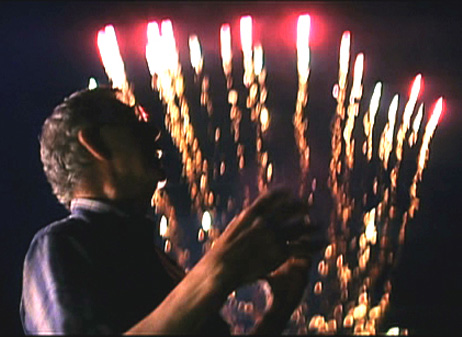 The Guatemalan Handshake
The Guatemalan Handshake(Todd Rohal) — Not only does Rohal’s wildly inventive picture climax with a truly delightful fireworks display, but fireworks also play a vital role in sparking that climax, helping to solve one of the film’s many strange mysteries. (MT)
Manhattan (Woody Allen) —The opening sequence, set to Gershwin’s “Rhapsody in Blue,” as fireworks light up the sky. Black-and-white but perfect. (Tom Hall)
Mean Streets (Martin Scorsese) — No actual fireworks are shown, but Michael (the aspiring wiseguy) and Tony (the bar owner) scam the Riverdale kids who come downtown looking to score some. “You got sparklers?” “Yes.” “Cherry bombs?” “Yes… Now, what we’re gonna do is, we’re gonna let you out right on that corner and we’re gonna come back for you… We’ll be back in about 30 minutes.” (NK)
Meet Joe Black (Martin Brest) — For me, though it’s not indie, a shout out should go to Meet Joe Black. It was hell for me but we had the Gauchi brothers, who do the NYC 4th of July fireworks, shoot off a massive amount of fireworks as close to the ground as possible for twenty nights. They spent close to $200,000 every night… it’s in the climax scene at the party so maybe people can fast forward if they just want to watch fireworks rather than a bloated overlong film. The experience for me ruined all interest in fireworks. (Mike S. Ryan)
Summertime (David Lean) — Frigid, moralistic Katherine Hepburn drops her 16mm camera for Rosanno Brazzi’s arms and kicks off her flame-shaped red heels while fireworks tell the rest of that wild night in Venice. (Cullen Gallagher)
To Catch a Thief (Alfred Hitchcock) — The French Riviera, a high-class hotel, a dark room, Grace Kelly and Cary Grant on the divan—the classic sex metaphor is obviously called for in this scenario, and Hitch doesn’t skimp on the explosions, either. (CG)
Wonderland (Michael Winterbottom) — As Michael Nyman’s astoundingly great score fills the soundtrack, a young boy wanders alone through a crowded nighttime fair, his innocent, wide eyes admiring the fireworks on display before a mugging makes him see a different brand of flashing stars. (MT)
(This clip cuts out at the 1:10 mark but it’s still very worth watching.)
Zodiac (David Fincher) — A menacing, sweeping shot set against the bay, fireworks in the distance… (TH)
BONUS:
There’s a really amazing episode of a canceled Nickelodeon show called Cousin Skeeter (who remembers this puppet-filled Cosby ripoff from the late ‘90s? No one? Ok, cool) in which the puppet voiced by Bill Bellamy believes he and his lady friend have amazing chemistry because he saw fireworks when they kissed—but it turns out that they were just standing near some ACTUAL fireworks! (LD)
DOUBLE BONUS:
Of course, the Opening Credits of Love, American Style. (TH)
